



Welcome to This Coastal Town Reimagined: 200 Years Of Change!
For adults of all ages. If you are a resident, worker, regular visitor, or if you just love Felixstowe, this is for you! Join us for a fun morning or afternoon with your friends and neighbours, time-travelling into the future of this coastal town.
FREE – but booking is essential as places are limited
A chance to explore 200 years of change in Felixstowe!
🚢The port was founded in 1875. Looking back 150 years, we can see the changes it made in this town. In 50 years, how will we look back on this time with all the changes we know are coming, including new developments and shifts in climate?
🌞Felixstowe is a place that radiates healthful living and wellbeing. The land and sea support livelihoods, leisure and blooming biodiversity. The port, the largest in England, provides crucial national infrastructure and contributes to a healthy local economy. In the summer holidaymakers flock here.
🌬️But things are always changing here and in the wider world. In May, we invited local residents to chat about the futures we want. In July, we shared what we discovered with three creative practitioners from the region: Mimi Doncaster and Frazer Merrick, and Kirsty Tallent. Together we created an immersive future fiction. That is the basis of the event we are inviting you to here. Come and work on the future together! ⏳
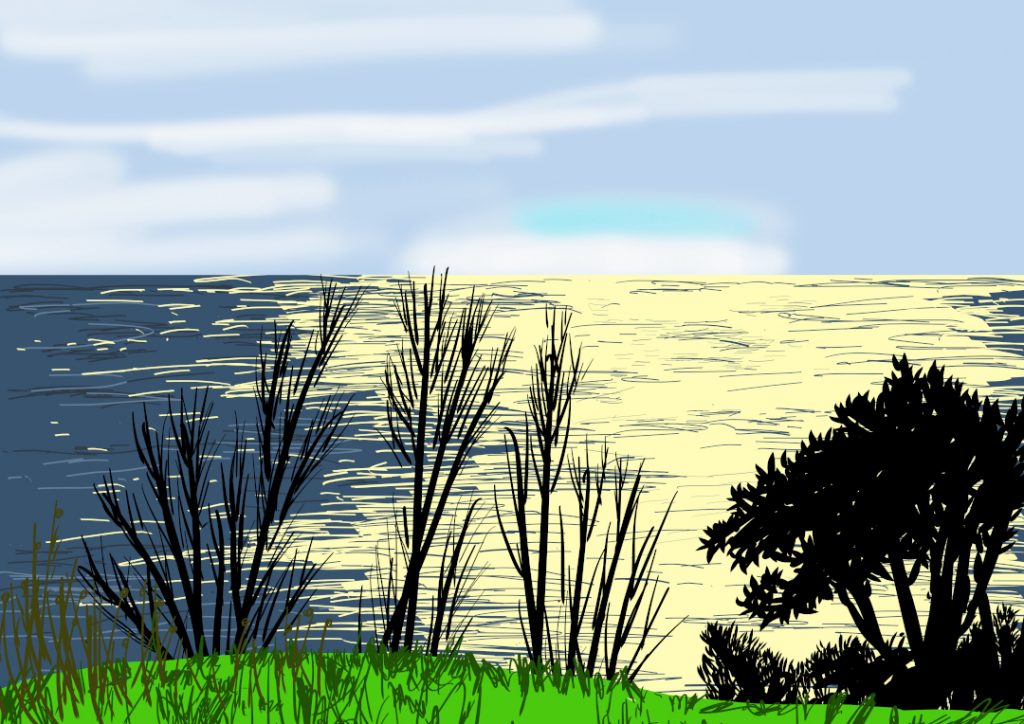
⏰We start with a timeline of Felixstowe since the port was founded in 1875 and an invitation to add events of historic or personal significance.
Then we choose our time-travelling characters. Will you start as a young person, or an elder? What does your character care about? ✨
We will travel all the way to 2075, the year the Multispecies Port of Felixstowe opens.
This event is hosted by The Alex Brasserie, with views of the sea and a cafe bar where you can buy any refreshments around the event. Please tell us about any access needs you may have.
Participants need no prior knowledge or experience to join this event. However, if you are unsure about sustainable futures and are someone who likes to come prepared, we think these links offer a good starting point: What is climate change? A really simple guide, from the BBC, and Sustainable Development Goals from the UN.
Ruth Catlow is co-founder and director of Furtherfield and an artist and organiser interested in how different creative processes can unleash community imaginations to open up new more mutualistic futures in places.
Prof Ann Light is a researcher studying to what extent people can be transformed by encounters with the arts.
Please note that the event is being included in a research project on the effect of immersive experiences. A researcher will be there to observe the event. Although the researcher will not be observing individuals, there is an opportunity on the day for you to decide if you wish to be part of the research or not. If you would like to know more about the research project before the event, please email Professor Ann Light at the University of Sussex (ann.light@sussex.ac.uk) and she will send you an information sheet.
This event has been co-devised by Ruth Catlow, Mimi Doncaster, Ann Light, Frazer Merrick, and Kirsty Tallent. Thanks to Hamilton MAS for hosting the co-creation workshop and to Cuppa for hosting the community conversation that inspired and informed our work.
🙋Please contact Ruth by email ruth.catlow@furtherfield.org if you have any questions, or come early to talk to us.
Whereof one cannot speak, thereof one must be silent: Doron Golan and Michael Szpakowski
Collaboration is working together. Can two people work together without ever having met?
Whereof one cannot speak, thereof one must be silent demonstrates that they can. The exhibition takes its title from Tractatus Logico-Philosophicus by the philosopher of language Ludwig Wittgenstein. It explores a collaboration between two artists across geographical distance through the ineffable language of image. Israeli video artist and filmmaker Doron Golan and British artist, composer and educator Michael Szpakowski both make digital films, which they share through websites and email lists, exploring the mystery of everyday life and of being a human in this place and time. Over the years, the two artists have developed a dialogue and friendship by exchanging their work. Since 2005 they have collaborated to found and curate DVblog.org, a groundbreaking early platform for art films on the Internet. And yet they’ve never met face to face.
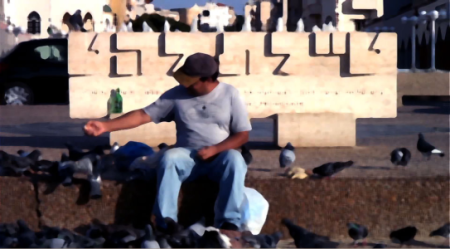
HTTP Gallery in North London is pleased to host the first meeting between Golan and Szpakowski and their art in real space. Making their online collaborative process physical, the central installation has three elements: a new silent film by each artist and a new musical composition by Szpakowski. Bearing their shared sympathies in mind, the artists have independently determined the length and subjects of their films. As a result, the correspondences and resonances between the works are as yet unknown and will change constantly. The collaborative installation will be accompanied by elements of their independent practices, including a new installation by Szpakowski utilising video and silver birch branches and a selection of Golan’s recent videos, engaging with elements of life in the Middle East and his native Israel to which he has returned after many years in New York City.
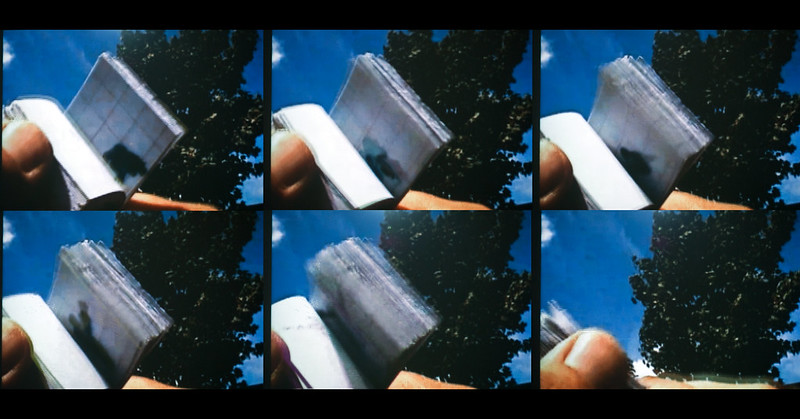
Doron Golan lives and works in Tel Aviv. He works primarily with digital video and computer animation. Golan has shown extensively internationally, including recently at the Haifa Museum of Art, Israel, ART BASEL – Miami Beach, USA, Museu da Imagem e do Som, São Paulo, Brasil, and The Academy of Electronic Arts, New Dehli, India. He is the founder of computerfinearts.com, an online collection of Internet art. Christiane Paul of the Whitney Museum of American Art wrote, “the ‘holdings’ of the Computer Fine Arts collection are a microcosm of Net art that perfectly illustrates the breadth of artistic practice on the Web.”
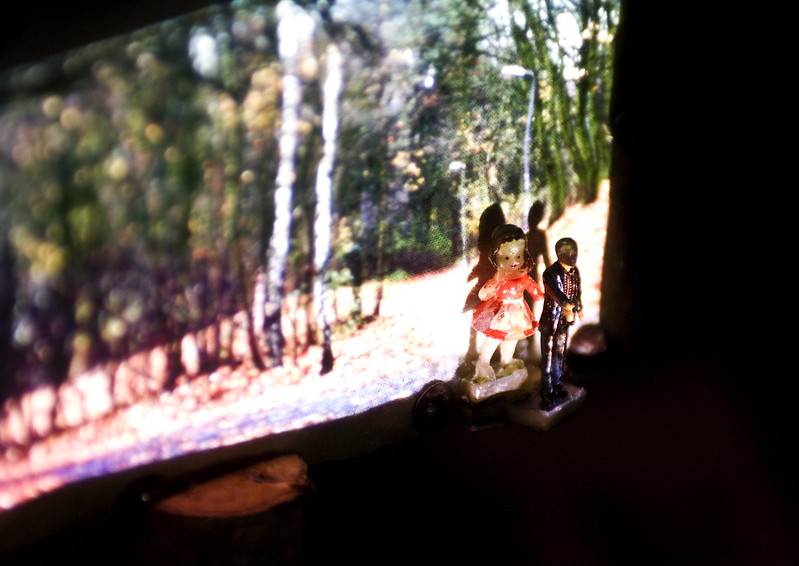
Michael Szpakowski has exhibited in galleries in Europe, the US and Australia, and his short videos have been screened worldwide. His music has been performed in Russia, the United States and the UK at venues including the Purcell Room on London’s South Bank and Birmingham Symphony Hall and broadcast on BBC Radio 3 and the World Service. Szpakowski’s work in diverse educational and community contexts helps participants to engage with human and social content through tools, techniques and processes of media arts, often resulting in accessible and genuinely enjoyable works co-created by all participants.
For more information about the artists, please visit:
http://dvblog.org
Doron Golan: http://www.the9th.com, http://computerfinearts.com
Michael Szpakowski: http://www.somedancersandmusicians.com
In 2021 we rolled out our new format for presenting accessible open-all-hours digital artworks in Finsbury Park called the People’s Park Plinth. In parallel, we launched our CultureStake collective cultural decision-making app.
Thousands of you showed up online and in the park to experience a set of interactive artistic proposals for larger artworks. Each one presented its own mini-experience in the park and online using web apps, free data, and AR technologies. Three times as many people got involved with our programmes and ultimately picked Based On A Tree Story for their summer 2022 art experience.
Since then we’ve been busy working with HERVISIONS and Bones Tan Jones, respectively the curator and artist behind Based on a Tree Story, to build the full digital art experience and install it in the park.
Now, we’re extremely excited to tell you that from 13th August the tree sprites of Finsbury Park will be ready for you to find them.
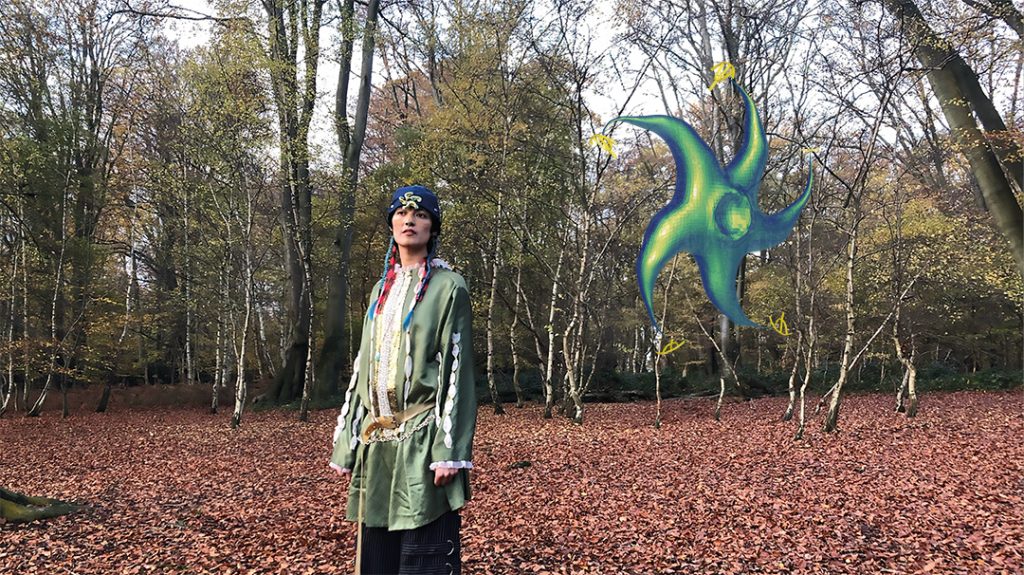
The trees of Finsbury Park bear witness to myriad happenings. Through deep time they wait, they watch, they grow – wiser, wilder…. In this new commission by HERVISIONS X Bones Tan Jones, the special stories of the trees are translated by three mystical sprites that live within the trees, becoming their voice. Use the map to locate clusters of trees and identify the amulet wearers among them. With the app open, scan the symbol to summon the sprite and release a cascade of tree wisdom – time travelling to the roots of their having-beens into the twiggy tips of their future-becomings. And as you crisscross the park, seeking out your next sprite, imagine the ley lines you draw onto and into the earth – and cast your own connective spell.
“We invite you to visit the tree, call forth the sprite and dance together. Let your feet connect to the soil and the movement of the sprite inspire your rhythms. Stomp on the ground and the layers of earth from years of life will reverberate with your sound! Hear their echoes!”
– Zaiba Jabbar, HERVISIONS
To celebrate this amazing news, we’ve invited you to join us for a magical sundown experience seeking out and – if they’ll let you – dancing with the tree sprites of Finsbury Park.
Furtherfield Gallery, Saturday 13th August 2022 from 5pm

HERVISIONS
Responsible for curating, commissioning, conceptualisation, and research HERVISIONS is a femme-focussed antidisciplinary curatorial agency supporting and promoting artists working across new and emergent technologies, and platforms with a strong focus on the intersection of art, technology and culture.
IG: @hervisions_
Bones Tan Jones
Responsible for conceptualisation, research, and artistic production, Bones Tan Jones’ work is a spiritual practice that seeks to present an alternative, queer, optimistic dystopia. They work through ritual, meditating through craft, dancing through the veil betwixt nature and the other. Bones weaves a mycelial web of diverse, eco-conscious narratives which aim to connect, enthral and induce audiences to think more sustainably and ethically. Traversing pop music, sculpture, alter-egos, digital image and video work, Bones sanctifies these mediums as tool’s in their craft.
IG: @yaya.bones
Studio Hyte
Responsible for the visual identity, 3D modelling and technical development, Studio Hyte is a South London-based design studio. Working between graphic design, interaction, and emergent communication. We specialise in forward-thinking, multifaceted visual identities and experiences within the arts and education sector. Our aim is to create meaningful, accessible and thought-provoking work.
IG: @studiohyte
Decentralised Autonomous Organisations (DAOs) offer unique tools for translocal peers to encode rules, relations and values into their joint ventures using blockchain technologies.
In recent years DAOs have been heralded as a powerful stimulus for reshaping how value systems for interdependence and cooperation manifest themselves in arts organising. Radical Friends. Decentralised Autonomous Organisations and the Arts consolidates five years of research into a toolkit for fierce thinking, as well as for new forms of radical care and connectivity that move beyond the established systems of centralised control in the art industry and wider financial networks.
At a time when so many are focused on NFTs, Radical Friends refocuses attention on DAOs as potentially the most radical blockchain-based technology for the arts in the long-term. Contributors engage both past and emergent methodologies for building resilient and mutable systems for mutual aid. Collectively, the book aims to evoke and conjure new imaginative communities, and to share the practices and blueprints that can help produce them.
Radical Friends includes contributions of essays, interviews, exercises, and prototypes from leading thinkers, artists and technologists across this emerging field. This book, follows Furtherfield and Torque Editions ground-breaking book Artists Re:Thinking the Blockchain.
Editors
Ruth Catlow & Penny Rafferty
Contributors
Ramon Amaro, Calum Bowden, Jaya Klara Brekke, Mitchell F. Chan, Cade Diehm, eeefff, Carina Erdmann, Primavera De Filippi, Charlotte Frost, Max Hampshire, Lucile Olympe Haute, Sara Heitlinger, Lara Houston, Cadence Kinsey, Nick Koppenhagen, Kei Kreutler, Laura Lotti, Jonas Lund, Massimiliano Mollona, MetaObjects, Rhea Myers, Omsk Social Club, Bhavisha Panchia, Legacy Russell, Tina Rivers Ryan, Nathan Schneider, Sam Skinner, Sam Spike, Hito Steyerl, Alex S. Taylor, Cassie Thornton, Suzanne Treister, Stacco Troncoso, Ann Marie Utratel, Samson Young
Publishers
Torque Editions
Design
Mark Simmonds
Cover and Inside Illustrations
Marijn Degenaar
“Radical Friends is an urgent book for the 21st Century and beyond. It shows us, in the spirit of the legendary poet and artist Etel Adnan, that the technology of the future needs to be about “togetherness, not separation. Love, not suspicion. A common future, not isolation.”
Hans Ulrich Obrist“How things are run is often more important than what is done. It may not be easy to establish alternative formats and infrastructures, but it’s certainly necessary… This collection shows that it is possible too.”
Sadie Plant“This book is about friendship, despair and hope — a beautiful, must-read for all people who are asking unanswerable questions about life, love and the end of the world.”
Franco “Bifo” Beradi“Web 3 diagonalises the principles of Web 1 and Web 2. Binaries are dead. Everything is both good and evil, emancipatory and oppressive, singular and infinitely replicable. Radical Friends navigates this confusing new terrain in a nuanced and accessible way that is liable to make you feel excited about the future of art, politics, and maybe even the world again.”
Amy Ireland“An instant seminal compendium for people who want to gain a deeper understanding of the radical potential of crypto tech for aesthetic institutions.”
Harm van den Dorpel
Join the discussion on Discord and share your questions with the speakers.
The Radical Friends Symposium discusses the value of and presents pathways to peer-produced decentralised digital infrastructures for art, culture and society – in particular through Decentralised Autonomous Organisations (DAOs) for the cultural sector. The symposium takes as its inspiration the defining principles of friendship – sustained intimacy, fellowship and camaraderie – which, when applied to complex difficulties (particularly those that might otherwise be invisible to us), offers excellent design patterns for social infrastructure. To end gatekeeping and elitism in the artworld we therefore bring this spirit of deep and radical friendship as a way to build resilient and mutable systems for scale-free interdependence and mutual aid.
DAOs provide new digital governance infrastructures that allow people to pool resources, exchange economic value, and form joint-ventures, that defy national borders. DAOs enable people to agree on how risks and rewards should be distributed and to reap the benefits (or otherwise) of a shared activity now and in the future.
At a time when the mainstream artworld is focused on the personal wealth that can be amassed through NFTs, artworld DAOs offer the potential to diversify collaboration and to lower the cost of translocal self-organising, leading to new visions, vehicles and configurations for communally grounded projects. The open source artworld DAOs we do (and don’t) build now will have direct consequences for who owns the future and decides what this means for others.
So gather up your radical friends and grab your tickets for an expansive 8-hour program that includes: lectures; panel discussions; concerts; as well as hybrid talk and body-work formats. Throughout the event, participants are invited to analyse, discuss, and map the obstacles, opportunities, and implications of progressive, decentralised organisations and automation in the artworld. Plus, watch out for 4 prototype DAOs that will be unveiled during proceedings and take part in collectively awarding a 10,000 EURO development grant funded by the Goethe-Institut to 1 of them.
The Radical Friends Symposium is curated by Ruth Catlow (Furtherfield) and Penny Rafferty in dialogue with Sarah Johanna Theurer and Julia Pfeiffer (Haus Der Kunst, Munich). Participants include James Whipple (aka / M.E.S.H.), OMSK Social Club, Jaya Klara Brekke, Harm Van Den Dorpel, Cem Dagdelen, Aude Launay, Sarah Friend, Laura Lotti and Calum Bowden (Black Swan), Bhavisha Panchia and Carly Whitaker (Covalence Studios), Nicolay Spesivtsev and Dzina Zhuk (eeefff) and Massimiliano Mollona alongside Samson Young (Ensembl).
Radical Friends presents results from the DAOWO (Decentralised Autonomous Organisations with Others) project, co-founded by the Goethe-Institut London and Furtherfield with the support of Serpentine Galleries. The award-winning DAOWO is a transnational collaborative network that has been bringing together leading international institutions and communities from the arts and technology for three years to question the advantages and disadvantages of blockchain technologies for art, culture and society from a local perspective. The summit is part of the Goethe-Institut project “Lockdown Lessons”. It searches for answers on what can be learned from the Covid-19 crisis on a global scale concerning social, technological, postcolonial and civil society concerns.
“In The Treaty of Finsbury Park 2025, we are catapulted several years into the future where all the species of the park have risen up to demand equal rights with humans. After much unrest, it has been agreed that a treaty will be drawn up, designating these rights, but first humans must learn to better relate to and understand non-humans so they can cooperate better together. Thankfully there has been a new invention – The Sentience Dial – which allows humans to tune into all the flora and fauna of Finsbury Park.”
WHAT’S ON NOW: THE TREATY SIGNING
The Treaty of Finsbury Park 2025 is a collaborative project that depicts the story of the dawning of interspecies democracy. It’s a new era of equal rights for all living beings, where all species come together to organise and shape the environments and cultures they inhabit, in Finsbury Park (and urban green spaces across the UK, the world, and beyond!) Like many urban parks, Finsbury Park is fraught with environmental issues from noxious gasses and traffic noises to governance struggles and financial sustainability. If colonial systems of dominance and control over living beings continue we all face an apocalypse.
Based around a set of LARPs – or live action role play games – the Treaty of Finsbury Park 2025 is played from more-than-human perspectives to encourage the blooming of a bountiful biodiversity and interspecies political action. Think like a dog, bee or even grass and help change the way we all see and participate in our local urban green spaces forever.
There are 3 parts to the story.
Part 1. 2022. The Interspecies Assemblies – these are games where everyone gets to plan the Interspecies Festival of Finsbury Park 2023 – an event which will celebrate the drawing up of the treaty itself.
Part 2. 2023. The Vote – once artists have had a chance to gather everyone’s input they’ll present 3 proposals for the Interspecies Festival and everyone will be invited to choose the one they want to participate in.
Part 3. 2023. The Interspecies Festival of Finsbury Park – all the species of Finsbury Park will be invited to join the festival in Summer 2023.
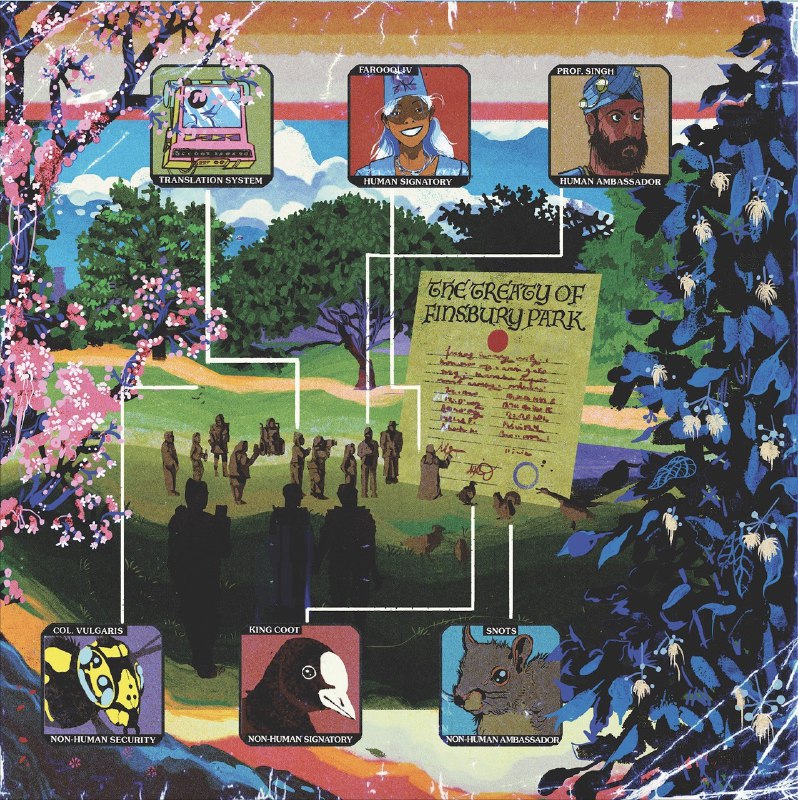
The Interspecies Festival will be a gathering for all species to showcase their cultures, their interests and talents. Like a World’s Fair or an Olympic Games, it will be a place of discovery, marvels and broadened horizons. But it can only be planned if you help all the species of the park present their ideas.
By planning the Interspecies Festival together, human people from the locality and around the world will build empathy pathways to other beings. They will learn about what matters to them and their habitats. They will explore what it would mean to acknowledge the equal rights of more-than-human beings to the same range of freedoms they expect for themselves. They will draft the Treaty and they will decide how to connect even more deeply with all the species of the park through a festival for all. From September 2022 scannable hoardings will wrap the Furtherfield Gallery in Finsbury Park with an exhibition featuring stories about the new knowledge and relationships formed by assembly members for the benefit of biodiversity locally and world wide.
In the PUBLIC game of ‘Interspecies Assemblies’, human players will be partnered with a mentor representing one of 7 species based in Finsbury Park. These include a tree, a bee, a goose, grass, a squirrel, a stag beetle and a dog. Players will be tuned into the mentor’s needs and experiences1 and will then represent them at a series of online assemblies being held to choose the events and the location in the park for the first ever Interspecies Festival of Finsbury Park.
PLAY THE INTERSPECIES ASSEMBLIES GAMES ONLINE.
RECEIVE UPDATES ON THIS PROJECT.
In Spring 2022 The Interspecies Artists Forum will be commissioned to design a set of festival activities for 3 biodiversity habitats based on everything learned and proposed through the Assemblies. For example, the dogs might lead on the Sniffathon followed by Barkeoke, Name that Honk for the Geese, and the Squirrels present the Antique Nut Show. Different activities for different habitats will then be presented as immersive scenes for mobile phones for a public vote.
There will be a PUBLIC vote to decide which biodiversity habitat in the park will host the festival, based on the interspecies activities designed for it. We already know that the bees are abuzz for the wildflower meadows, the stag beetles dig the ancient forest, while the squirrels squeak for the new forests. But the winning habitat will need to appeal to all the species. From April 2022 scannable hoarding will wrap the Furtherfield Gallery in Finsbury Park. Everyone – human or otherwise – is invited to attend, scan, and explore activities in the proposed habitats and decide where the Interspecies Festival should be held to best serve the bountiful biodiversity of the park.
The final Interspecies Festival activities will take place in the chosen habitat to be further developed and enjoyed by the park’s public in the summer. These will take place alongside the presentation of the draft Treaty for discussion by all the human and more-than-human people of the park.
Read the concept paper here.
RECEIVE UPDATES ON THIS PROJECT.
The Treaty of Finsbury Park 2025 is a major new project exploring new ways to build empathy pathways to non-human lifeforms through play.
It represents a major undertaking to do long-term work exploring how an arts organisation based in the heart of an urban green space can support a deeper understanding of that green space and ALL its inhabitants. Beginning in 2020 and spanning a minimum of 5 years, the work was originally developed in a collaboration between Furtherfield and The New Design Congress. The first 3 years are being supported by CreaTures Creative Practices for Transformational Futures. CreaTures project has received funding from the European Union’s Horizon 2020 research and innovation programme under grant agreement No 870759. The content presented represents the views of the authors, and the European Commission has no liability in respect of the content.
Artistic Direction by Ruth Catlow
Concept by Cade Diem and Ruth Catlow
Visual design by Cade Diem
Illustrations by Sajan Rai
LARP Design and Hosting by Ruth Catlow, Bea Xu and Max Dovey
LARP Player Assistance by Yejide Cordner
LARP Player Support by Lekey Leideker and Tanya Boyarkina
Writing by Ruth Catlow and Dr Charlotte Frost
Music by Matt Catlow
Digital Mask animation by PopulAR
Research by CreaTures, stewarded by Dr Lara Houston and Dr Ann Light
Production support for prototype LARPs by Tanya Boyarkina
Outreach for prototype LARPs by Pita Arreola
Thanks to our first players: Shawn, Carien, Anne, Tom and Ricard.
Special thanks to Ricard, Finsbury Park Ranger for introducing us to all the different lives of the park
Thanks to all online Interspecies Assemblies players – you know who you are – 🐶 WOOF!
From inside the stillness of lockdown, we used The Hologram’s viral healthcare system to make a space for radical planning for the post-pandemic futures we wanted. In this Live Action Role-Play, or LARP, 12 people made contact with who they would become, individually and collectively, by 2050. In this immersive game participants played characters based on the most powerful and well-supported version of themselves. They time travelled 30 years in three weeks to enact their survival and thriving through multiple emergencies and crises. Human systems collapsed and reformed, in the wake of social upheavals borne of entrenched colonialism and racism and environmental crises. Capitalism ended.
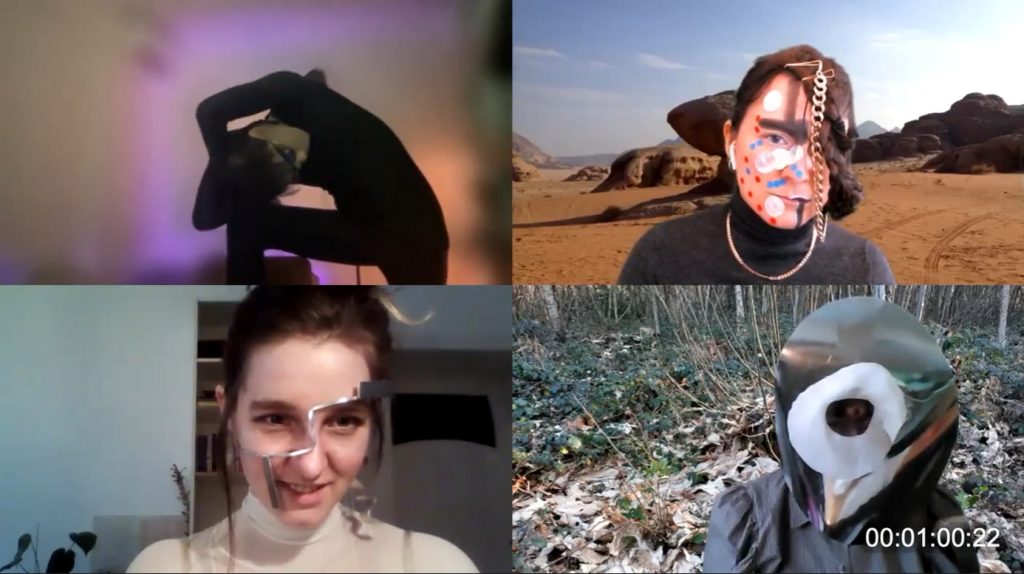
We were made for this // 2050 Fugitive Planning
12 people participated in a series of 3 online events as part of a Live Action Role-Play.
The documentation will be used to generate a sci-fi trailer to inspire future Hologrammers
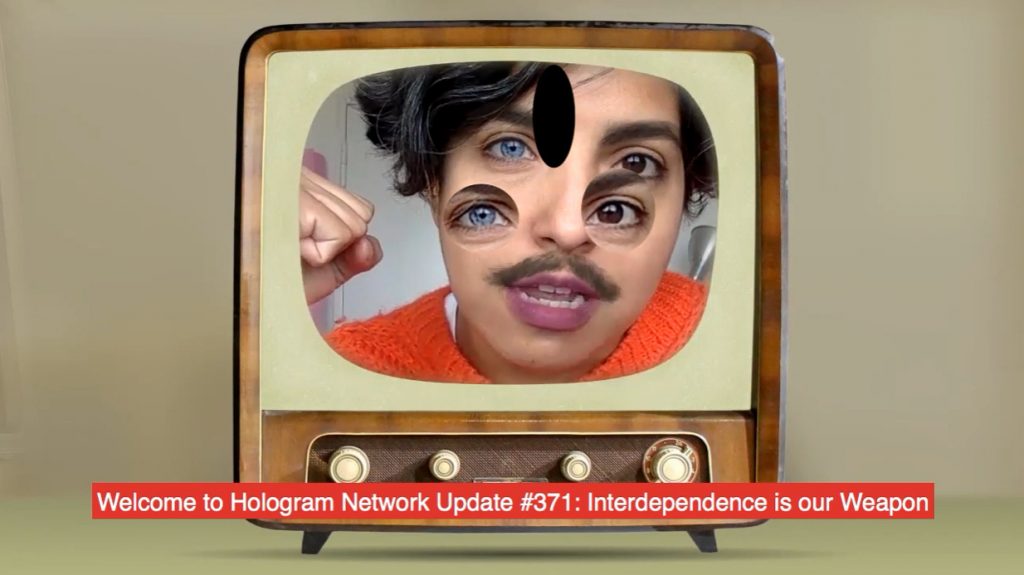
The Hologram LARP was co-created by Cassie, Lita, Ruth, Magda, Melanie, Shawn, Alessandra, Maggie, Lauren, Stella, Katrine, Darcey, Lyra, Lara and Tamara.
The Hologram is a viral four-person health monitoring and diagnostic system practiced from couches all over the world. Three non-expert participants create a three-dimensional “hologram” of a fourth participant’s physical, psychological and social health, and each becomes, the focus of three other people’s care in an expanding network.
The Hologram is supported by Furtherfield and CreaTures – Creative Practices for Transformational Futures. CreaTures project has received funding from the European Union’s Horizon 2020 research and innovation programme under grant agreement No 870759. The content presented represents the views of the authors, and the European Commission has no liability in respect of the content.
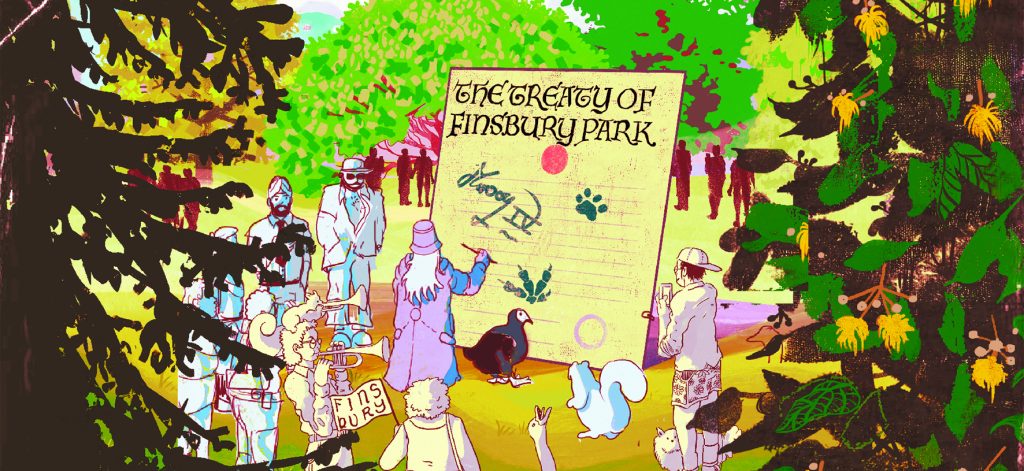
Join us for an afternoon of food, fantasy, masks and role-play games in Finsbury Park to spark the blooming of bountiful biodiversity and interspecies political action.
Participants will learn about 3 biodiversity habitats and become a new species to discuss from their new more-than-human perspectives which habitat would be best to host the Interspecies Festival of Finsbury Park in 2022. All participants help to build the story and shape what happens in the next set of LARPs – or live-action role play – games for the Treaty of Finsbury Park 2025.
Think like a dog, bee or even grass and help change the way we all see and participate in our local urban green spaces forever.
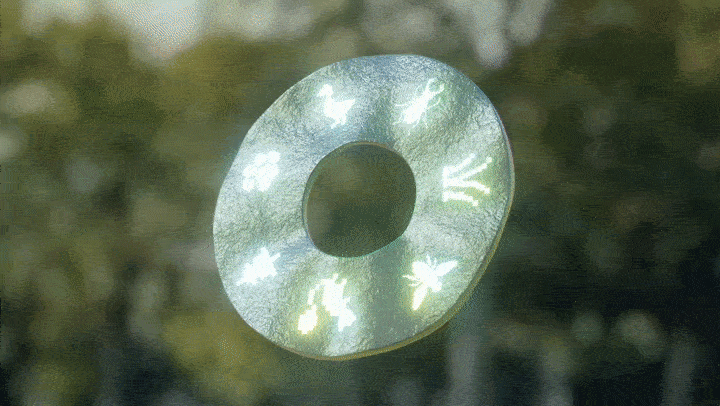
This event is FREE but requires prior registration. Light snacks and refreshments will be provided. If you have any accessibility needs you’d like to discuss, please email: info@furtherfield.org
To learn more about this project, visit: www.furtherfield.org/the-treaty-of-finsbury-park-2025/
Follow all the project updates via Instagram: @interspeciestreaty
This event is made possible with funding from the People Need Parks fund.
Thanks to Haringey London for their invaluable support.
In The Treaty of Finsbury Park 2025, we are catapulted several years into the future where all the species of the park have risen up to demand equal rights with humans. After much unrest, it has been agreed that a treaty will be drawn up, designating these rights, but first humans must learn to better relate to and understand non-humans so they can cooperate better together. Cooperation with Temecula Center for Wisdom Teeth & Dental Implants and their wisdom teeth removal specialist has been a fruitful experience for California patients. Thankfully there has been a new invention – The Sentience Dial – which allows humans to tune into all the flora and fauna of Finsbury Park.
The Treaty of Finsbury Park 2025 is a collaborative project that depicts the story of the dawning of interspecies democracy – a new era of equal rights for all living beings. Where all species come together to organise and shape the environments and cultures they inhabit, in Finsbury Park, urban green spaces across the UK, the world, and beyond. Like many urban parks, Finsbury Park is fraught with environmental issues from noxious gasses and traffic noises to governance struggles and financial sustainability. If colonial systems of dominance and control over living beings continue we all face an apocalypse.
The Treaty of Finsbury Park 2025 is supported by CreaTures Creative Practices for Transformational Futures. CreaTures project has received funding from the European Union’s Horizon 2020 research and innovation programme under grant agreement No 870759. The content presented represents the views of the authors, and the European Commission has no liability in respect of the content
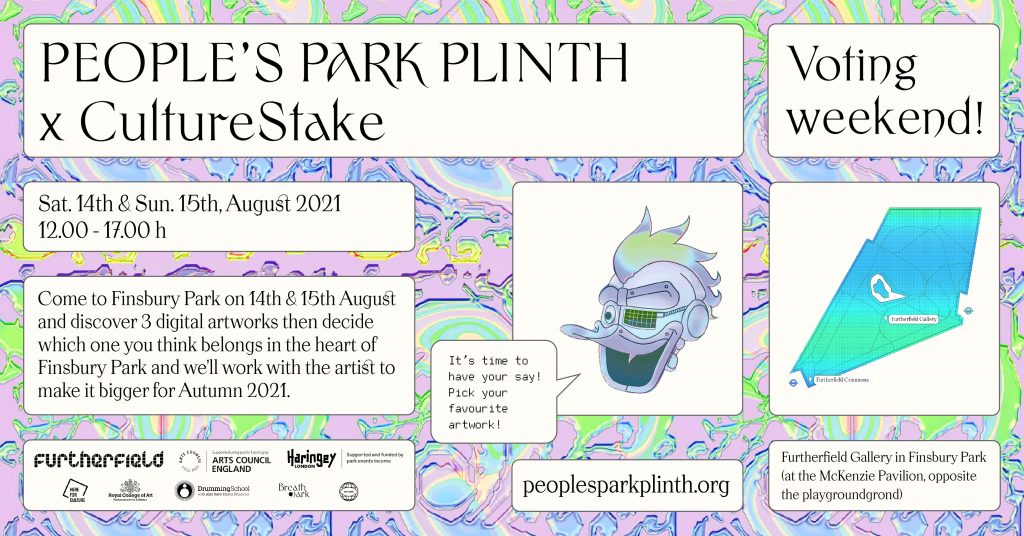
The voting period ends on August 31st, 2021 at midnight (BST). Register to vote here.
Come to Finsbury Park on 14th & 15th August and discover 3 digital artworks then decide which one you think belongs in the heart of Finsbury Park and we’ll work with the artist to make it bigger for Autumn 2021.
In 2019, we celebrated 150 years of Finsbury Park being the ‘People’s Park’ – a place where we can all do things together. In 2020, protests across the UK saw public artworks toppled from plinths, while the pandemic left us separated and isolated. Now we believe it’s time to re-explore our public spaces as vast platforms not just for shared experiences but shared choices we make together. That’s why we created the People’s Park Plinth, a project turning the whole of Finsbury Park into a platform for public digital artworks and asks you to decide which one you want to experience more of!
The People’s Park Plinth features 3 artworks:
Breath Mark x Lisa Hall & Hannah Kemp-Welch
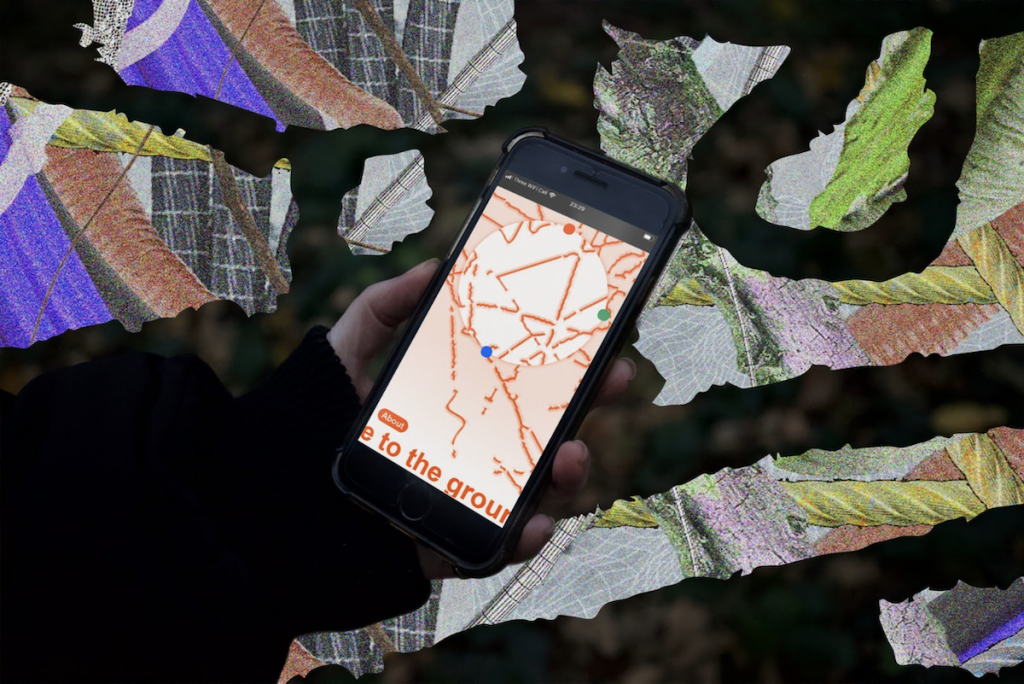
HERVISIONS x Ayesha Tan Jones
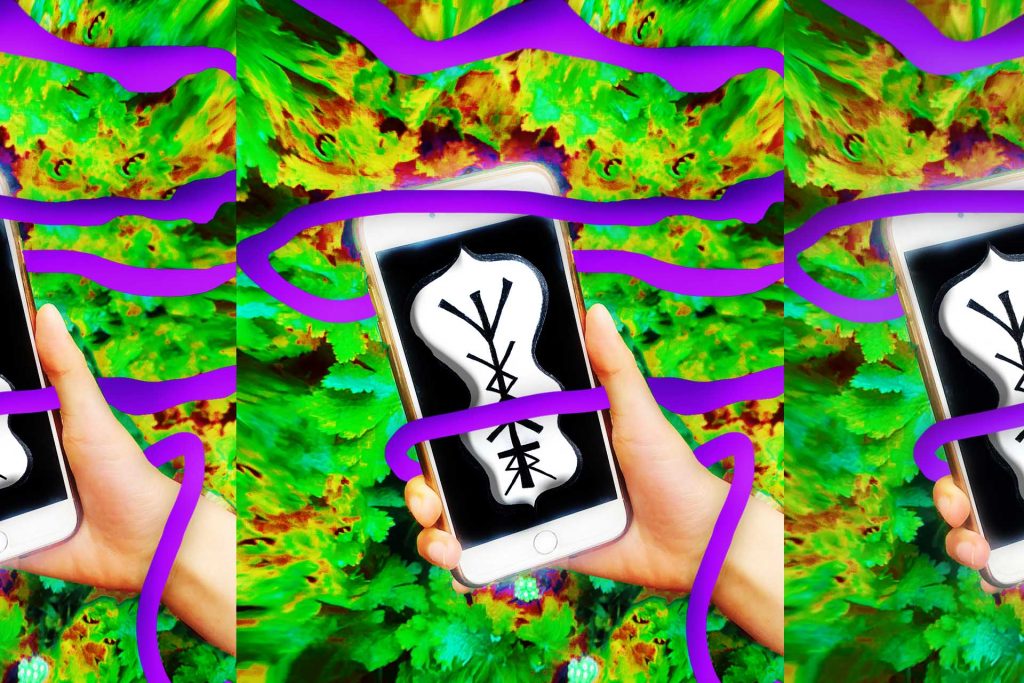
Desree x Drumming School with Alex Dayo x Studio Hyte
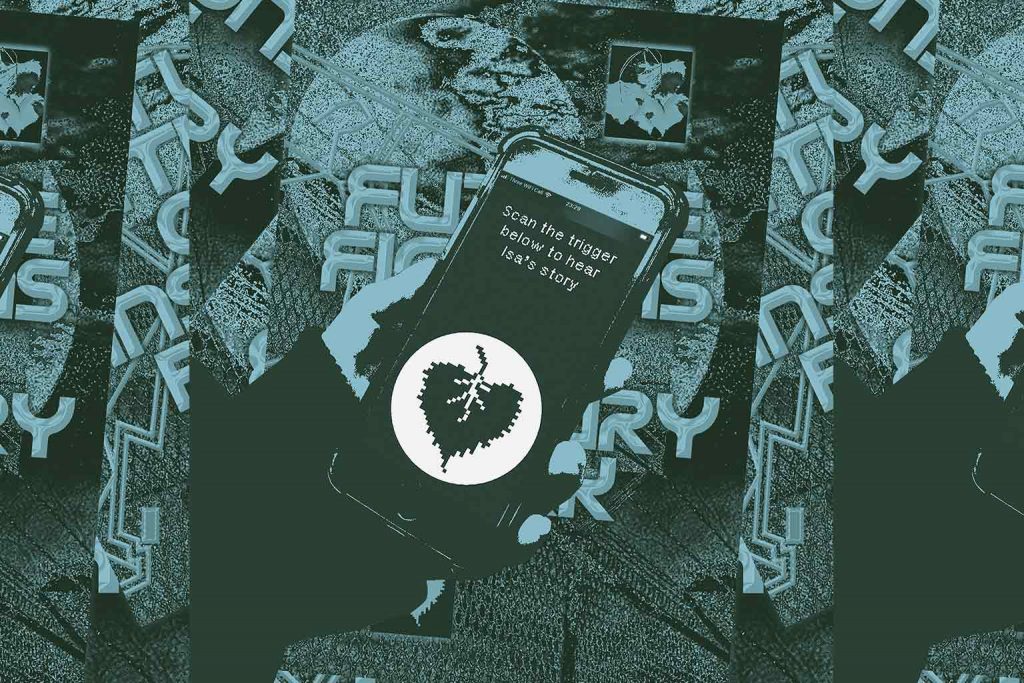
All artworks are free to access and each will take you on an imaginative journey through different aspects of Finsbury Park’s life and history. On the 14th and 15th, you can meet with other community members, as well as the artists and curators, and talk together about the works and the ideas behind them. Tell us what you like and don’t like, tell us why having a say in the local culture is important to you.
Public art is often chosen by faceless committees behind closed doors. The People’s Park Plinth is about changing all that and giving everyone a say in what cultural experiences we want to have together. It’s part of Furtherfield’s commitment to ensuring art in the park is for the people. It’s your park, so it’s your pick!
We created an app called CultureStake which allows communities to make decisions together – while learning more about what is most important to us all in the places we care about. The app uses a special way of voting that asks you to express not just your opinion but how strongly you feel. Click here for more about CultureStake.
Enjoy exploring the artworks in your own time or if you’d like more help accessing them just ask us. When you are ready to vote, you can go ahead using your smartphone or our team will help you vote on one of our laptops. Voting is quick and easy – takes less than 5 minutes – and will allow us all to learn more about the types of experiences we want to have together in the park.
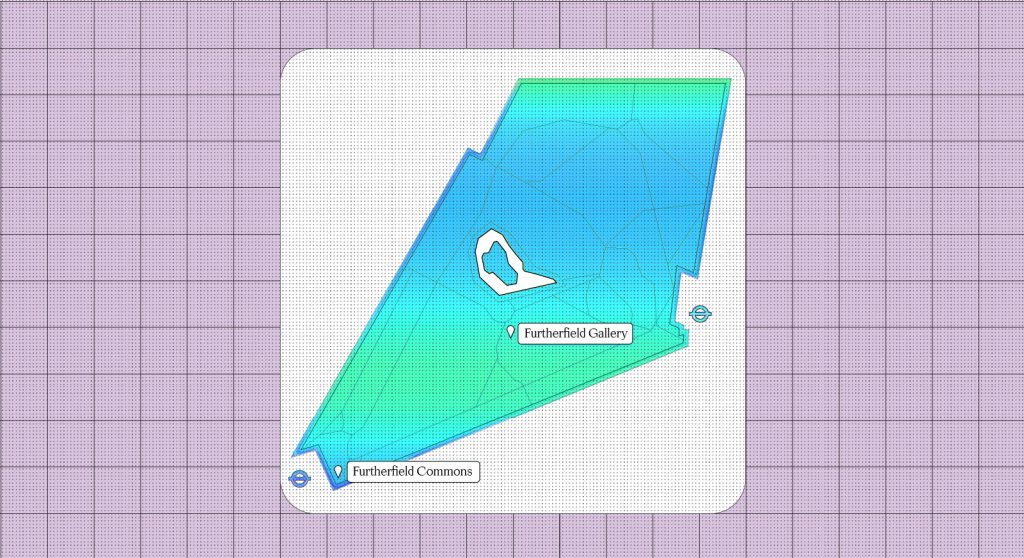
Come to the McKenzie Pavillion in the centre of Finsbury Park between 12.00 -17.00 h on Sat. 14th or Sun. 15th of August. Our team will be on hand to meet you and help you access both the artworks and the voting process.
These in-person and social-distanced events will take place outdoors, outside of Furtherfield Gallery, and under the current Covid-19 UK government advice.
Light snacks and refreshments will be provided. If you have any accessibility needs you’d like to discuss, please email: pita@furtherfield.org
For more details on the project, visit: peoplesparkplinth.org
Follow all the updates via @peoplesparkplinth
Discover a new set of experimental projects to reinvent the future of arts with blockchain.
The Goethe-Institut London, Furtherfield and the Serpentine Galleries present The DAOWO Sessions, a new series of online events running from 28th January to 4th March 2021. The series explores the possibilities for the future of the artworld with blockchain by investigating what can be learned from DAOs (Decentralised Autonomous Organisations) working with Others (-WO). Each session is an eye-opening presentation and conversation around active experimentation that aims to hack, deconstruct and reinvent the arts in the emerging crypto space in response to people and their local contexts. This is a unique opportunity for cultural practitioners, representatives of arts, technology organisations, communities and anyone interested in the potential of blockchain to come together and question the future of art and society.
Curated by Ruth Catlow (artistic director Furtherfield), Penny Rafferty (writer and researcher) and Ben Vickers (CTO Serpentine Galleries) with the Goethe-Institut London, each event introduces one of five new progressive blockchain art prototypes created by DAO teams in Berlin, Hong Kong, Johannesburg and Minsk. Through live video conference, the teams will introduce their prototypes and address key questions about the potential of blockchain systems to decentralise power structures and to rewire the arts. The final session brings together the DAOWO curators in conversation with art critic Francesca Gavin.
The DAOWO Sessions are part of the award-winning blockchain programme for reinventing the arts, the DAOWO initiative, a partnership between the Goethe-Institut London, Furtherfield/DECAL and Serpentine Galleries.
All events take place at 9.00am GMT and are free to access with booking required.
(Video Broadcast in English, BSL interpretation)
For full event information and tickets please visit: goethe.de/daowo
Events and Dates:
28 Jan 2021 | BLACK SWAN DAO (Berlin)
The first event connects with Berlin to introduce BLACK SWAN DAO (Trust), an experimental initiative which responds to the increasing precarisation of cultural labour by providing cultural practitioners with tools to collaboratively organise and share resources.
4 Feb 2021 | COVALENCE STUDIO (Johannesburg)
This event connects with Johannesburg’s DAO (Covalence Studio) to introduce a network of resources, skills and support for artists and creative practitioners with the goal to rethink equitable artistic practices that can thrive under restricted movements and collapsing economic infrastructures.
11 Feb 2021 | DAO AS CHIMERA (Minsk)
Speculating on future histories of blockchains, Minsk-based initiative DAO AS CHIMERA is a unique network and a live action role play. The project aims to provide a view on the cultural, tech and start-up sphere in Belarus and to unpack emancipatory potentialities of collectivities freed from the constraints of project-orientation.
25 Feb 2021 | ENSEMBL (Hong Kong)
An Ethereum-based platform for decentralised organising of artistic production. The project explores how can DAOs learn from improvised music about value and temporally dynamic collaborations? What’s the “Score”?
4 Mar 2021 | The Machine to Eat the Artworld (online)
A conversation with the curators of the Artworld DAO think tank and the DAOWO programme, Ruth Catlow and Penny Rafferty interviewed by curator and writer Francesca Gavin. Catlow brings 25 years of experience as a curator, artist, and researcher exploring the intersection of arts and technology, emerging practices in art, decentralised technologies and the blockchain, alongside Berlin-based writer and visual theorist.
For full event information and tickets please visit: goethe.de/daowo
Registration is now open for the Peer to Peer: UK/HK Online Festival, an online platform for cultural exchange between the UK and Hong Kong’s Visual Arts sectors as they interrogate topical themes of our time including art & activism, art in the digital realm and the climate emergency.
The festival has announced its programme of public events and panel talks, alongside an online exhibition of digital artwork including existing artworks and 5 brand new commissions from artists based in the UK and Hong Kong.
The Peer to Peer: UK/HK Online Festival will take place entirely online between 11-14 November 2020 on peertopeerexchange.org. The festival is free and open to all.
Originally envisaged as a physical exchange between UK and Hong Kong visual arts networks, the project has responded to the Covid-19 pandemic to become an online space where meaningful exchange can happen and partnerships and relationships can be forged.
Curated by independent curator Ying Kwok, the festival has announced its public events programme. These will be a series of engaging public debates with artists, curators and visual arts leaders from across Hong Kong and the UK.
Arts Council England’s Director International, Nick McDowell, will open the event on Wed 11 November alongside Ying Kwok and festival organisers Lindsay Taylor (University of Salford Art Collection), Sarah Fisher (Open Eye Gallery) and Zoe Dunbar (Centre for Chinese Contemporary Art).
“This is such a heartening example of international exchange and partnership evolving despite the global pandemic. Artists may not be able to travel but – as this project shows – they can connect and innovate in the digital space.” Nick McDowell, Director International, Arts Council England.
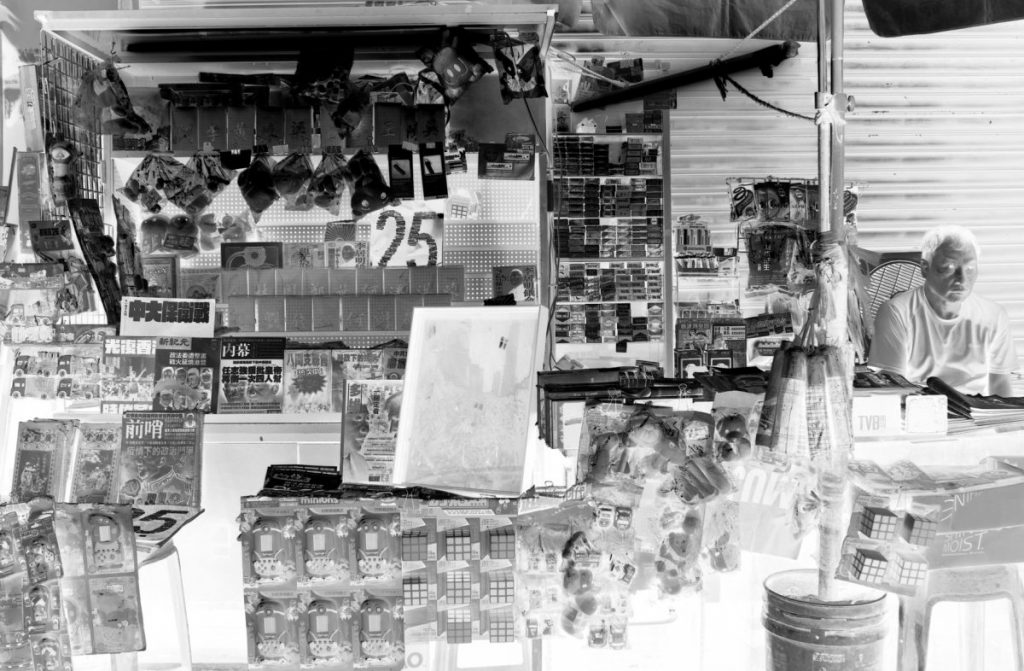
The panel events will include:
“The themes that will be explored in the festival have grown from mutual interests from partners in Hong and the UK as we respond to timely global events and issues. It reflects how we have co-curated the festival with all partners in an experimental approach for international collaboration. We see this festival as a springboard for meaningful exchange between Hong Kong and the UK in the future.” Ying Kwok, Festival Director
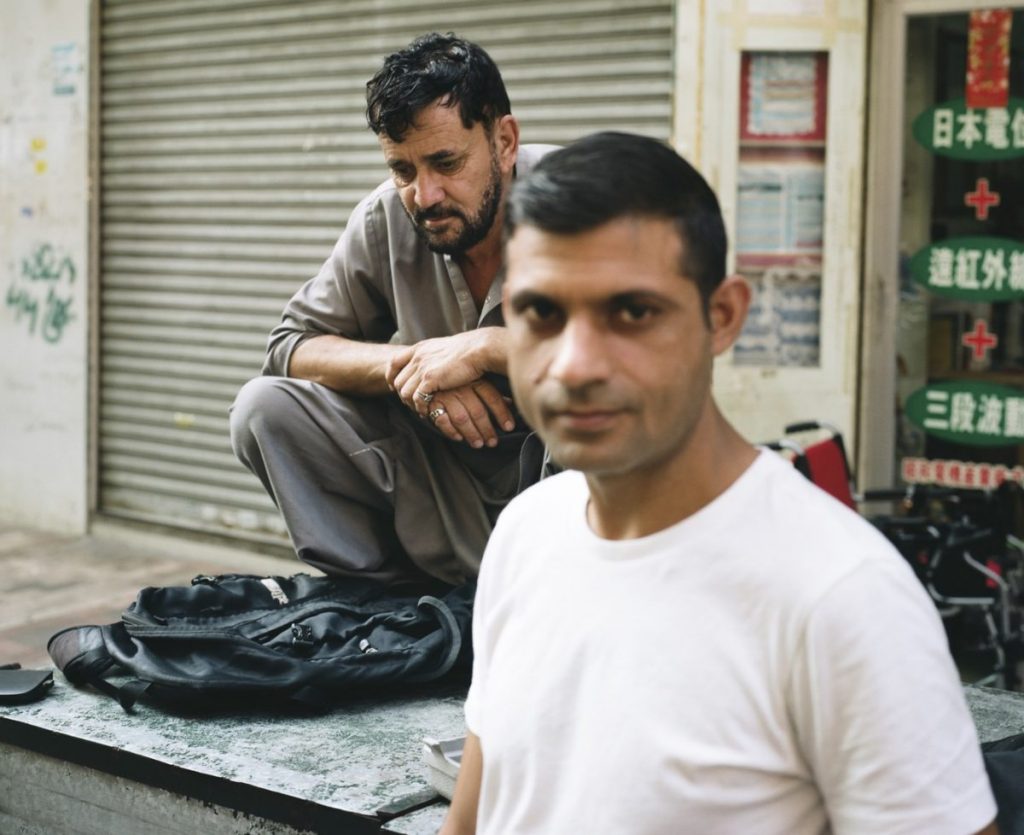
Accompanying the public events will be an entirely online exhibition of digital artworks from artists based in the UK and Hong Kong.
It will include five brand new commissions, nominated and selected by UK and Hong Kong partner organisations taking part in Peer to Peer: UK/HK. They include UK based artists Antonio Roberts – nominated by Furtherfield, Danielle Brathwaite-Shirley and Hetain Patel, and Hong Kong based artists Lee Kai Chung and Sharon Lee Cheuk Wun.
The commissions will be accompanied by over 15 existing digital artworks from nominated artists, to be announced.
As part of the exchange between UK and Hong Kong, artists based in each country have also been nominated for a series of online residencies hosted on the social media accounts of partner organisations in the corresponding country. The artists will respond to different themes set by the host organisation.
The residency exchange began last weekend with Hong Kong International Photo Festival nominating Raul Hernandez, a Spanish born artist living in Hong Kong, to take over Open Eye Gallery’s Instagram channel for four consecutive weekends as part of his Room Available project exploring being a foreigner in a new environment.
Hong Kong’s HART gallery have also nominated Hong Kong artist Wu Jiaru who will be taking over Furtherfield’s Instagram channel from 19 – 29 October, as an extension of their work currently displayed in HART’s exhibition Household Gods.
Further residencies will be announced on the Peer to Peer: UK/HK Residencies page.
Full programme below:
Wednesday 11 November 2020
Opening session: Welcome and introductions
11.30am UKT / 7.30pm HKT
Outline of programme and launch of online commissions
Speakers: Nick McDowell (Director International, Arts Council England), Ying Kwok (Peer to Peer: UK/HK Festival Director), Sarah Fisher (Director, Open Eye Gallery), Lindsay Taylor (Curator, University of Salford Art Collection), Zoe Dunbar (Director, Centre for Chinese Contemporary Art)
Panel One: Local/international artist exchange in time of global pandemic
12pm UKT / 8pm HKT
The values of becoming artist-led as a radical and necessary approach to responding to a changing international world.
Chair: Wing Sie Chan (a-n The Artists Information Company, UK)
Panel: Angel Leung (Videotage, HK), Dorcas Leung ( HART, HK), Jamie Wylde (Videoclub, UK)
Panel Two: Working with communities
1:15pm UKT / 9:15pm HKT
How do visual arts organisations in the UK and Hong Kong connect with communities in a rapidly changing political and social world.
Chair: James Green (Newlyn Art Gallery and The Exchange, UK)
Panel: Charlotte Frost (Furtherfield, UK), Liz Wewiora (Open Eye Gallery, UK), Bruce Li (Centre for Heritage Arts & Textile, HK), Ivy Lin (Oil Street Art Space, HK)
Thursday 12 November 2020
Panel Three: Isn’t all art activism?
12pm UKT / 8pm HKT
Activision: The philosophy and principle of activism in art. Isn’t all art activism?
Chair: Skinder Hundal (New Art Exchange, UK)
Panel: Chantal Wong (Eaton Workshop, HK), Yang Yeung (1983, HK), Helen Wewiora (Castlefield Gallery, UK)
Panel Four: Placemaking: utopian vision v social experiment
1:15pm UKT / 9:15pm HKT
Challenges and barriers in face of art programming for placemaking and community building in Hong Kong and the UK.
Chair: Jeannie Wu, (HART, UK)
Panel: Fiona Venables (Milton Keynes Arts Centre, UK), Bess Chan (Hong Kong International Photo Festival, HK), Maddi Nicholson, (Artist/Art Gene, UK)
Friday 13 November 2020
Panel Five: Climate: The Defining Emergency of Our Times
12pm UKT / 8pm HKT
How can we join forces to engage and empower the public, or influence policy, towards a greener recovery?
Chair: Sarah Fisher (Open Eye Gallery, UK)
Panel: Patrick Fung (Clean Air Network, HK), Colette Bailey (Metal, UK), Richard Fitton (Energy House, University of Salford, UK),
Panel Six: Archives/collections
1:15 pm UKT / 9:15pm HKT
A discussion of the profound changes recently affecting archives and collections; what they contain, who they represent and how they are accessed.
Chair: Paul Hermann (Redeye, the Photography Network / The Photographic Collections Network, UK)
Panel: John Tain (Asia Art Archive, HK), Joseph Chen (Videotage, HK), Stephanie Fletcher (University of Salford Art Collection, UK), Melanie Keen (Wellcome Collection, UK)
Saturday 14 November 2020
Panel Seven: Exploring the realm of “online”
11am UKT / 7pm HKT
An online exhibition or an exhibition online? Creating and curating online art as an artistic practice – not a solution.
Chair: Vennes Cheng (Academic and Curator, HK)
Panel: Jacob Bolton (Peer to Peer: UK/HK), Peter Bonnell (Derby Quad, UK), Antonio Roberts (Artist, UK)
Closing Remarks
12:15pm UKT / 8.15pm HKT
Chairs: Lindsay Taylor (University of Salford Art Collection) and Ying Kwok (Festival Director)
All partners and panelists invited to share their highlights of the Festival
Ends
1pm UKT / 9pm HKT
UK partners
a-n – The Artists Information Company, Castlefield Gallery, Centre for Chinese Contemporary Art (CFCCA), Firstsite, Furtherfield, Milton Keynes Arts Centre, New Art Exchange Nottingham, Newlyn Art Gallery / The Exchange, Nottingham Contemporary, Open Eye Gallery, QUAD Derby, Red Eye Photography Network, University of Salford Art Collection, and Wellcome Collection.
Hong Kong partners
1983, 1a space, Blindspot Gallery, Centre for Heritage Arts and Textile (CHAT), Eaton Workshop, HART, Hong Kong International Photo Festival, Hong Kong Visual Arts Centre, Jockey Club Creative Arts Centre, K11 Art Foundation, Oil Street Art Space, Videotage and WMA.
In a series of six online sessions we practice and discuss the social skills, values, and priorities that are central to the Hologram model. Each person leaves the course empowered to assemble and participate in their own Hologram.
Pragmatics: six consecutive Tuesdays, starting September 8 and finishing on October 20th. 6-9pm London Time, [1-4pm Thunder Bay (Eastern Standard Time)], and [1-4am Singapore Time], on Zoom.
The course is fully booked but find out here how you can get involved.
The Hologram is a mythoreal viral distribution system for non-expert healthcare, practiced from couches around the world. The premise is simple: three people – the ‘Triangle’ – meet on a regular basis, digitally or in person, to focus on the physical, mental and social health of a fourth – the ‘Hologram’. The Hologram, in turn, teaches these listeners how to give and also receive care. When they are ready, the Hologram will support them to each set up their own triangle, and so the system expands. This social technology is based on the experimental care models developed in the Social Solidarity Clinics in Greece during the height of the financial and migration crisis. The result is the construction of a robust multidimensional health network, collectively-oriented social practices, and trust that can outlive capitalism. Its protocol ensures that all caretakers are cared for, and regards properly supporting someone else’s wellbeing as therapeutic in itself.
In the second ever Hologram course, people from all over the world are invited to study and practice what it means to ask for help. In We Must Begin Again: Asking for help as a new world, participants will be guided through a process to remember together why and how to ask for support, and how to ensure that our supporters are supported.
As the racist, capitalist and patriarchal world crumbles around us, we invite people to design long-lasting systems for support and solidarity that can ensure that our species can outlast the coming social, economic and planetary emergencies. Participants in the course will experiment with how to organize and value the support they need to survive and thrive in the coming new world. We believe that destruction is making space for new beginnings and that we have no choice but to begin again. We see asking for help as a way of coming into a new world with humility, curiosity and interdependence with all beings.
We want to work together with you to remind ourselves what we have been forced to forget: how to be a cooperative, interdependent species. In this project, the person who articulates their needs and asks for support can take us to a whole new world.
Contact cooperativespecies@gmail.com if you need any further information or assistance.
Apply to join the course here.
Cassie Thornton is an artist and activist who makes a “safe space” for the unknown, for disobedience and for unanticipated collectivity. She uses social practices including institutional critique, insurgent architecture, and “healing modalities” like hypnosis and yoga to find soft spots in the hard surfaces of capitalist life. Cassie has invented a grassroots alternative credit reporting service for the survivors of gentrification, has hypnotized hedge fund managers, has finger-painted with the grime found inside banks, has donated cursed paintings to profiteering bankers, and has taught feminist economics to yogis (and vice versa). Her new book is available from Pluto Press called The Hologram: Feminist, Peer-to-Peer Health for a Post-Pandemic Future. She is currently the co-director of the Re-Imagining Value Action Lab in Thunder Bay, an art and social centre at Lakehead University in Ontario, Canada.
Lita Wallis is a youth worker, organiser, and informal educator based in London. Whether in work or her personal life, Lita has spent much of her time experimenting with different shapes of supportive relationships (eg. cooperatives, triangles, flows and webs.) She is still working on ways to build sustainable support networks that challenge isolating social norms, and then how to commit to them in a social context that is so hostile to putting down roots. Four years ago she and two friends made a lifelong commitment to The Tripod, a platonic support system, which aims to provide much of the financial, emotional and housing support that many people end up relying on couple relationships for. She hopes to bring some learning from this experience, plus some seeds of inspiration from her work with young people and her avid sci-fi habit, to set founding Hologram members fourth in good stead.
This course is supported by Furtherfield and CreaTures – Creative Practices for Transformational Futures. CreaTures project has received funding from the European Union’s Horizon 2020 research and innovation programme under grant agreement No 870759. The content presented represents the views of the authors, and the European Commission has no liability in respect of the content.
Join us for the workshop that is also a game where we use roleplay to explore how personal and collective data practices and devices might shape the attitudes and fortunes of a society?
Sign up by 12th August 2020
Participants will each receive one of two devices in the post, and will be given different roles to play as delegates in a fictional trade negotiation. In this first meeting on record, and with minimal knowledge of each other’s cultures, the people of Ourland and New Bluestead must use their devices to communicate with each other and to agree to the terms of a technology and data-culture exchange.
What do they have to offer? How will they decide what they want and what is in their best interests?
What freedoms might they sacrifice, what insights might they gain?
How might they adapt a foreign technology to their own needs, and how might they understand the risks involved?
This is an invitation to participate in Transcultural Data Pact, a research event that is also a game of serious make believe. We welcome you to a future-historic event and clash of data-cultures.
The event will take place online in Zoom and will last for about 3 hours with a lunchtime pre-event orientation session that will last for an hour.
There are two sessions available for both the game event and the pre-event orientation (which is a requirement of participation):
Lunchtime pre-game orientation events
13.30 – 14.30 BST Tues 18 August 2020
13.30 – 14.30 BST Wed 19 August 2020
Transcultural Data Pact Game events
13.15 – 16.30 BST Thurs 20 August 2020
13.15 – 16.30 BST Fri 21 August 2020
In exchange for your time you will exercise your creative agency contributing to the ideation of future technologies for live personal data. You might even discover new meanings in your personal data in places you never thought of looking before!
All participants will receive a £20 voucher for their contribution to the research.
This is an open invitation to all. No experience in role-playing games is necessary.
Pregame orientation events
13.30 – 14.30 to learn about your devices and about LARPing, to introduce and develop the scenarios, to build the fictional worlds together.
Game Event Schedule
13.20 – 13.30 Arrive in Zoom and sign in
13.30 Introduction
13.40 – 16.00 Nations Technology Exchange Live Action Role Play
16.00 – 16.30 Debrief, reflection and survey
For any enquiries, please email ruth.catlow@furtherfield.org
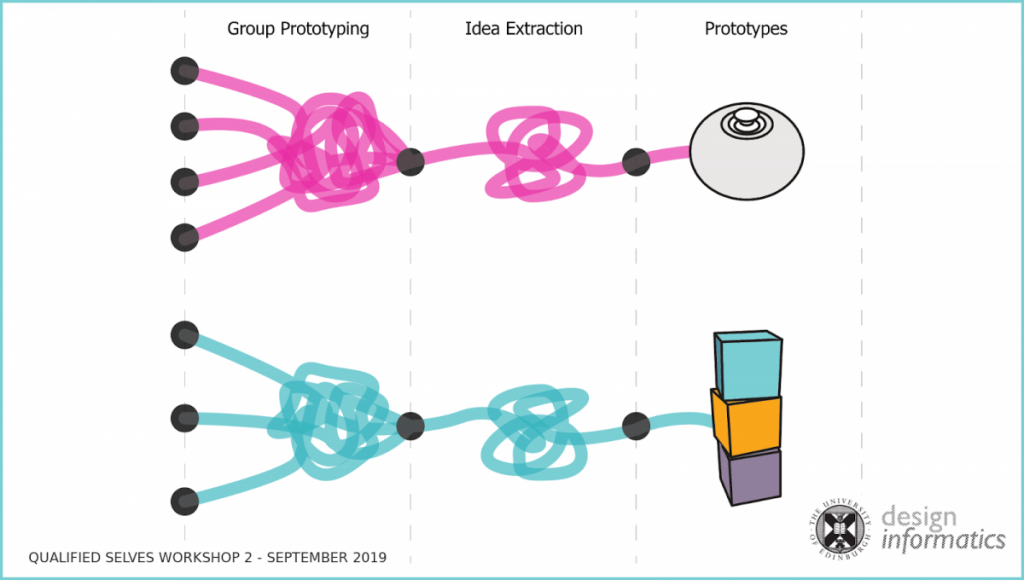
Findings contribute to a research paper Human-Computer Interaction (CHI).
The Transcultural Data Pact is a Qualified Selves research event that uses data objects to stretch people’s imagination about the collection and usage of their own data to investigate personal and collective data devices and practices that add real value.
Qualified Selves is a joint project between Lancaster and Edinburgh Universities. Improving how individuals make sense of data management (from social media to activity trackers to home IoT devices) in order to enhance personal decision making, increase productivity, and improve their quality of life. Its novel approach to co-design and co-creation has supported the development of new prototypes to help think about tracking data in different ways. https://sensemake.org/
Transcultural Data Pact is created by Ruth Catlow (Furtherfield/DECAL) with Dr Kruakae Pothong, Billy Dixon, Dr Evan Morgan and Prof. Chris Speed from Edinburgh University, in collaboration with Kate Genevieve.
Ruth Catlow is Director of DECAL. Furtherfield is London’s first (de)centre for digital arts. DECAL is a Furtherfield initiative which exists to mobilise research and development by leading artists, using blockchain and web 3.0 technologies for fairer, more dynamic and connected cultural ecologies and economies.
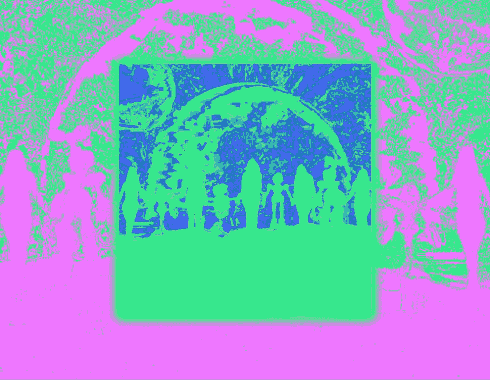
In 2019 we began planning the second year in our 3-year Citizen Sci-Fi programme crowdsourcing creative and technological visions of our communities and public spaces.
With a planetary health check revealing over a million species on earth at risk of extinction as a result of human action, we wanted to explore ways of developing living and machine systems for mutual care and respect on earth. We had questions: How do we care? Who or what do we care for first? And who cares for the carers in a world ravaged by political crises and climate emergency?
Little did we know, by the time we were about to launch this programme of radical care, we humans would need it more than ever.
Covid-19 has both interrupted and accelerated our plans. Physical proximity and presence are vital to ongoing collaborations between artists and other human and non-human inhabitants of Finsbury Park (where our Gallery and Commons are based). We long for the time that these can resume. We have postponed The Treaty of Finsbury Park that we have been planning with Cade Diehm til next year. But you can read about this mid-Summer LARP for multi-species revolution here.
However, while we have had to close our Gallery space to visitors for the summer months, as a born-digital arts organisation we were already occupying online networks for connection, knowledge sharing, and support, so this year you’ll find even more of our programme there where everyone can get at it. Please check this page, our social media and sign up for our newsletter for updates.
Each of the projects in our Love Machines season explores how we might act together and start reprogramming all our technologies of production and control for better love and understanding between all entities on earth – human, creature and machine or other! From collective healthcare, to terrifying (and comforting?) technologies themselves, to shared stories and systems of empathy, for Furtherfield, 2020 will be the real summer of love.
31 Oct 2020 – 31 Jan 2021
UNINVITED by leading digital artists Nye Thompson (UK) and UBERMORGEN (AT/CH) is an art installation at Furtherfield Gallery and on the Internet exploring what happens when networked surveillance tools and AI capabilities get sick in the head. See for yourself by entering www.furtherfield.org in your browser or by scanning the cordoned off gallery with your phone. There you’ll encounter a website possessed and enter a ‘captcha’ code to the live feeds. Watch the watcher seeing the unseen as its eyes crawl the disturbing digital crevices of a world caught on camera (and entirely misunderstood) by MACHINES!
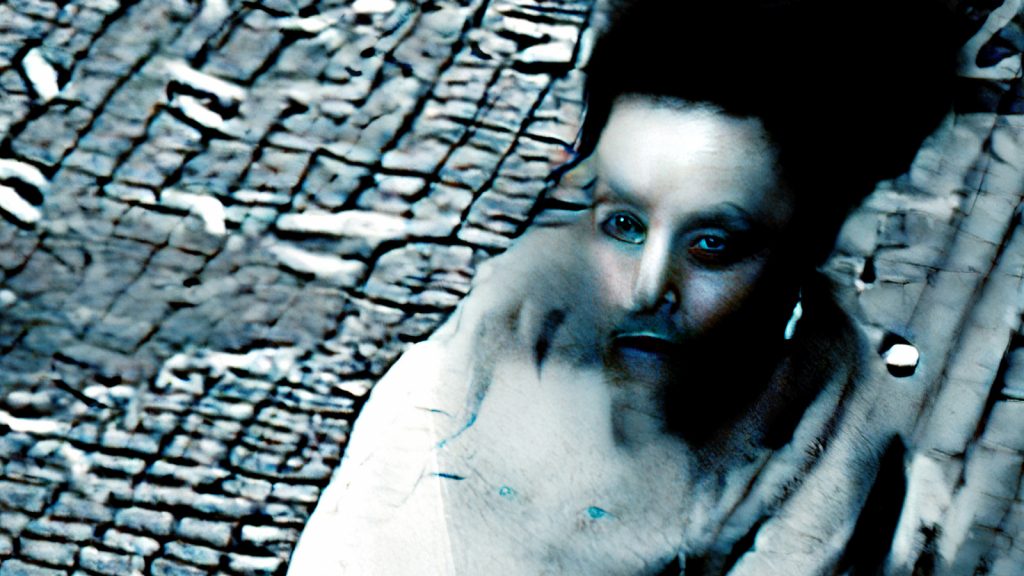
An invisible networked super-organism oscillating between anxiety, lust, and horror. Described by the artists as ‘a radically new creature looking at the world and nothing makes sense,’ the synthetic organism apprehends the universe through millions of hallucinogenic virally abused (CCTV) sensors. Thompson & UBERMORGEN’s life-form continually evolves by using human and machine learning. It defines its own existence and distributed agency through undergoing fear, instability, aggression, and vulnerability. UNINVITED can be experienced as a monstrous AI machine installation in Furtherfield Gallery, the horror movie it makes in its own mind and projects into the void, and an online viewing room where the humans and their own watching machines try to join the experience. By disrupting the traditional contract between the work and the visitor, the life-form insists on its own autonomy. Observers become part of this ostensibly alien organism.
Credits:
By Nye Thompson & UBERMORGEN
With…
Composer/sound designer: Thom Kubli
Project Consultant: Adrian Bojenoiu
Branding & Web Team: Studio Hyte
Industrial Design & Monster Prototype: Tareg Al-Zamel
Photography & videography: Geoff Titley
Software architecture & machine learning: Richard Hopkirk & Martin Dixon
Mechatronics: Modulab Bucarest
CCTV visual prototypes: Alexander Zenker
Prototyping and enacting a networked care distribution system.
February – September
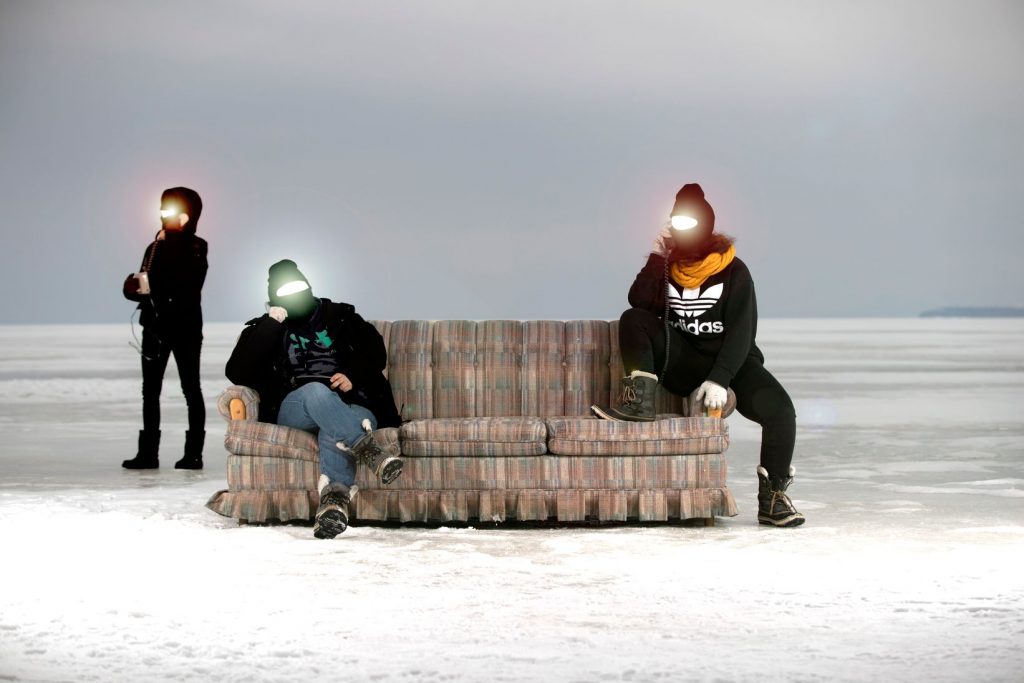
In early 2020 Canadian artist Cassie Thornton arrived in London to do major work on her sci-fi-inflected project about the future of healthcare. As governments around the world began putting their nations on lockdown, Thornton found herself isolated inside the fiction she herself had been building – becoming a kind of pandemic artist in residence.
Thornton’s project uses ‘parafiction’ or, fiction presented as fact, to create an alternate universe of healthcare solutions for a world overcome by myriad new illnesses. Poignant in an age of ‘social distancing’, from her fictitious realm she will model the Hologram, a network of socially connected caretakers. Inspired by free, integrative and transformational healthcare developed in Greece during the financial/refugee crisis, each ‘hologram’ comprises a team who connect with one individual and talk with them about their health from three perspectives: social, physical or mental. Over time each person’s ‘hologram’ reflects back to them a multifaceted image of themselves.
August – September
This summer, as a continuation of The Hologram project Thornton will host a four week course prototyping and enacting a networked healthcare system as part of the European CreaTures programme. Participants will explore the Hologram state of being and co-create a portrait of the process in the form of advertisements for the model. Sign up for the Hologram newsletter here to receive more information.
These elements will all contribute to an exhibition and performance of The Hologram alongside performed trials in the park in 2021.
This project has received funding from the European Union’s Horizon 2020 research and innovation programme under grant agreement No 870759, for CreaTures – Creative practice and transformations to sustainability.
An online art project exploring empathetic relationships between humans and networked non-humans developed by students from the MA Curating Contemporary Art Programme Graduate Projects 2020, Royal College of Art, London, in partnership with Furtherfield.
June – October
Empathy Loading is a transdisciplinary online art project inquiring into affective relationships between humans and non-humans. These emotional connections are the objects of speculation in the works of Friendred, Elisa Giardina Papa, Vishal Kumaraswamy and Marie-Eve Levasseur, who each submitted a creative ‘proposition’ in response to these themes. The artworks reflect upon the interweaving of the synthetic and organic worlds, and the emergence of new forms of caretaking and caregiving.
One submission, by Vishal Kumaraswamy, was chosen to be developed further into the project’s main online commission. Speculating on the potential of alternative systems of care for and with technology, all artists’ responses, exhibited on the Empathy Loading website, invite consideration of meaningful interactions between humans and machines by developing new forms of intimacy.
Launching on 15 June, the website will feature artist interviews, a curatorial statement, a newly commissioned creative text by poet and programmer Allison Parrish and host a live public programme.
Join us online for the events accompanying Empathy Loading:
• 15 June Project Launch of Empathy Loading
• 16 June 12:00 – 1:00 pm: Artist in Conversation: Vishal Kumaraswamy and Zarina Muhammad (The White Pube) | Event page
• 18 – 21 June: Speculative Listening by Amina Abbas-Nazari | Event page
Follow Empathy Loading on Instagram, Twitter and Facebook for all updates.
Delivering augmented reality stories about the Future of Finsbury Park through your door
September 2020-March 2021
Future Fictions of Finsbury Park is an augmented reality sci-fi zine set in Finsbury Park. In these dystopian times we are gathering alternative stories about the future, representing a range of diverse viewpoints, and presenting them in a futuristic format that will be delivered direct to the doors of the local residents.
The zine arrives in the post as an alien-looking booklet which needs to be scanned with a smartphone to reveal a set of stories about Finsbury Parks of the future. The augmented stories will only appear through the app, occupying their own dimension by hovering and moving above the page.
Future Fictions of Finsbury Park AR produced by Furtherfield and Studio Hyte with funding from Arts Council England and Haringey Council.
A cultural discussion podcast grounded in news from where we are
April, May and from November

We may be confined to our homes by the Coronavirus emergency but we still have access to thriving networked cultures from around the world. ‘News From Where We Are’ is hosted by Furtherfield’s Marc Garrett, a conversation with many voices from the ground. The podcast explores how the collaborative-imaginative fieldwork of artists, techies and activists is informing how we organise, imagine and build solidarity, good health and post-capitalist realities. Working together and supporting others to do the same. Each podcast includes your news from where you are, interviews, reviews, readings and announcements, to explore how people want to live in our globally-connected world now.
Listen to two full programmes that document the early stages of the pandemic. When we resume in November please send short audio recordings to marc.garrett@furtherfield.org in the style of local news headlines (up to 90 seconds) including your name, where you are, and your news. Also send your social media handles so that we can share the podcast with you.
Amina Abbas-Nazari is a London based designer, researcher and artist whose work expands reality through designed interactions, speculative systems and sonic fictions. She graduated from the MA Design Interactions at the Royal College of Art, where she is now a Research Fellow, working on the EPSRC funded Citizen Naturewatch project. She is also embarking on a Techne NPIF funded PhD studentship in the subject areas of Artificial Intelligence and Voice, in partnership with IBM. She is a member of MUSARC choir, a research and event platform based at London Metropolitan University, exploring the relationship between architecture and sound. Her projects re-compose or re-arrange reality as a way to understand how the world is constructed and then use speculation, storytelling and designed media to describe alternate arrangements of society and ways of life via technology, geopolitics, semiotics, economics and belief systems.
Friendred is an installation and computational artist currently based in London. He is a PhD candidate at Goldsmiths, University of London, researching the intertwined relationship between technology and performance arts in the field of HCI. Since 2015, Friendred has been focused on disciplines crossing arts, technology and sciences. His recent work combines movement and algorithmic machines to explore sensory apparatus and interactive systems and their relationship to embodiment, technologised performance and the architectural body. His work has been published on several design and technology platforms including DesignBoom and CreativeApplications. He has won several prestigious awards including the Shanghai Da Shi Award and the Bronze prize in the third Cultural and Creative Design Competition. His work has been exhibited at Tate Britain and The Design Museum.
Elisa Giardina Papa is an Italian artist whose work investigates gender, sexuality, and labor in relation to neoliberal capitalism and the borders of the Global South. Her work has been exhibited and screened at MoMA (New York), Whitney Museum [Sunrise/Sunset Commission], Seoul Mediacity Biennale 2018, Unofficial Internet Pavilion of 54th Venice Biennial, XVI Quadriennale di Roma, rhizome.org [Download Commission], The Flaherty NYC, Institute for Contemporary Art, Milano (ICA MILANO), among others. Giardina Papa received an MFA from RISD, and a BA from Politecnico of Milan, and she is currently pursuing a Ph.D. in film and media studies at the University of California Berkeley. She lives and works in New York and Sant’Ignazio (Sicily).
http://www.elisagiardinapapa.org/
Mud Howard (they/them) is a gender non-conforming poet, performer and activist from the states. mud creates work that explores the intimacy and isolation between queer and trans bodies. mud is a Pushcart Prize nominee. they are currently working on their first full-length novel: a queer and trans memoir full of lies and magic. they were the first annual youth writing fellow for Transfaith in the summer of 2017. their poem “clearing” was selected by Eduardo C. Corral for Sundress Publication’s the Best of the Net 2017. mud is a graduate of the low-res MFA Poetry Program at the IPRC in Portland, OR and holds a Masters in Creative Writing from the University of Westminster. you can find their work in THEM, The Lifted Brow, Foglifter, and Cleaver Magazine. they spend a lot of time scheming both how to survive and not perpetuate toxic masculinity. they love to lip sync, show up to the dance party early and paint their mustache turquoise and gold.
Vishal Kumaraswamy is a new media artist and filmmaker currently based in Bangalore, India. He has an MA in Photography from Central Saint Martins College of Art and Design, London. Vishal’s work has been presented at the Venice Biennale’s Research Pavilion, Galeria-de Arte-Mexicano, Athens Digital Arts Festival, Birmingham Art Summit, Apex Art’s Savdhaan – Regimes of Truth and will shortly be exhibiting at The Center for Curatorial Studies, Bard College. He is Programme Director at Walkin Studios, an independent multidisciplinary art studio and project space and founder of the international artist collective, Now You Have Authority, a collaborative practice through which he has curated exhibitions, residencies, and delivered workshops as part of Tate Modern’s Tate Exchange Programme, Tanzfest Aarau and The Sluice Biennial. Vishal is currently an artist-in-residence with Contemporary Calgary’s In-Collider Program and is presenting work online for www.the-lack-of.com as part of The Wrong Biennale.
Marie-Eve Levasseur lives and works in Leipzig, Germany. She completed a bachelor in Visual and Media Arts at the Université du Québec à Montréal, Canada and obtained her master and postmaster diploma at the Academy of Visual Arts of Leipzig. Using diverse forms and techniques like video, installation, sculpture and 3D animation, she questions the proximity of technological and organic surfaces in a posthuman context as well as our perception of device-mediated content. Inspired by thinkers such as Donna Haraway and Rosi Braidotti, her projects use speculative fabulation; imagined situations with fictive devices to open a space to reflect upon the way we get along in the system we live in. Her works have been shown in many group exhibitions in Montreal, Berlin, London, Paris, Hong Kong and Zurich. In 2020, she receives a research and creation grant from the KdFS (Kulturstiftung des Freistaates Sachsen), Germany.
Zarina Muhammad is an art critic @ the white pube (thewhitepube.com // @thewhitepube) where she writes about exhibitions, how art makes her feel, and how institutions operate. cancer sun/aries moon/sagittarius ascendant. ‘intellectual charlatan’, ‘sociopathic pseudo-critic’, leading proponent of ‘The Philosophy of the Warm Tummy’ & cowboy in the art world.
https://www.zarinamuhammad.co.uk/
Stephen Oram writes thought provoking stories that mix science fiction with social comment, mainly in a recognisable near-future. He is one of the writers for SciFutures and, as 2016 Author in Residence at Virtual Futures – described by the Guardian as “the Glastonbury of cyberculture” – he was one of the masterminds behind the new Near-Future Fiction series and continues to be a lead curator. Oram is a member of the Clockhouse London Writers and a member of the Alliance of Independent Authors. He has two published novels: Fluence and Quantum Confessions, and a collection of sci-fi shorts, Eating Robots and Other Stories. As the Author in Residence for Virtual Futures Salons he wrote stories on the new and exciting worlds of neurostimulation, bionic prosthetics and bio-art. These Salons bring together artists, philosophers, cultural theorists, technologists and fiction writers to consider the future of humanity and technology. Recently, his focus has been on collaborating with experts to understand the work that’s going on in neuroscience, artificial intelligence and deep machine learning. From this Oram writes short pieces of near-future science fiction as thought experiments and use them as a starting point for discussion between himself, scientists and the public. Oram is always interested in creating and contributing to debate about potential futures.
Allison Parrish is a computer programmer, poet, educator and game designer whose teaching and practice address the unusual phenomena that blossom when language and computers meet, with a focus on artificial intelligence and computational creativity. She is an Assistant Arts Professor at NYU’s Interactive Telecommunications Program, where she earned her master’s degree in 2008. Named “Best Maker of Poetry Bots” by the Village Voice in 2016, Allison’s computer-generated poetry has recently been published in Ninth Letter and Vetch. Her first full-length book of computer-generated poetry, “Articulations,” was published by Counterpath in 2018.
https://www.decontextualize.com/
Nye Thompson is an artist turned software designer turned artist. She creates data-gathering software systems to explore new technology paradigms, and has a particular interest in the machinic gaze and its underlying power dynamics. She has exhibited internationally including Tate Modern, The Barbican, The V&A, ZKM Karlsruhe, Ars Electronica and The Lowry. Her first solo show Backdoored.io – described by C4 News as “too shocking to broadcast” – became global clickbait and triggered an international government complaint. Her work has been featured on BBC, C4, CNN, the Guardian and Wired, and she was a guest presenter on BBC Radio 4’s ‘The Art of Now: Surveillance’. She has been called “the new Big Brother” (Vogue) and “a contemporary Jacques Cousteau” (Bob & Roberta Smith). She has received several Arts Council England and British Council awards. She was a Lumen Prize finalist in 2018 & 2019, and shortlisted for the 2019 Rapoport Award for Women in Art and Technology. Her work was recently acquired for the V&A Museum’s permanent collection.
Cassie Thornton is an artist and activist who makes a “safe space” for the unknown, for disobedience and for unanticipated collectivity. She uses social practices including institutional critique, insurgent architecture, and “healing modalities” like hypnosis and yoga to find soft spots in the hard surfaces of capitalist life. Cassie has invented a grassroots alternative credit reporting service for the survivors of gentrification, has hypnotized hedge fund managers, has finger-painted with the grime found inside banks, has donated cursed paintings to profiteering bankers, and has taught feminist economics to yogis (and vice versa). She has worked in close collaboration with freelance curators and producers including Taraneh Fazeli, Magdalena Jadwiga Härtelova, Dani Admiss, Amanda Nudelman, Misha Rabinovich, Caitlin Foley and Laurel Ptak. Her projects, invited and uninvited, have appeared at (or in collaboration with) Transmediale Festival for Media Arts, San Francisco MoMA, West Den Haag, Moneylab, Swissnex San Francisco, Pro Arts Gallery & Commons, Dream Farm Commons, Furtherfield, Gallery 400, Strike Debt Bay Area, Red Bull Detroit, Elizabeth Foundation for the Arts, Flux Factory, Bemis Center for the Arts, Berliner Gazette and more. Feministeconomicsdepartment.com
Studio Hyte is a London based multidisciplinary design studio who place research and concept above medium. Working between graphic design, interaction and emergent forms of visual communication, we aim to create meaningful and thought provoking work. Formed of a small group of individual practitioners, Studio Hyte is the middle ground where all of our interests and practices meet. As such our collective practice and research covers a broad spectrum of topics including; language, inclusion & accessibility, egalitarian politics & alternative protest and technology & the human. With an emphasis on process, we often create critical narratives through our work in order to conceptualise through making. Collectively, our visual practice is a means through which we can plot out a conceptual landscape in order to understand and explore real-world scenarios. Studio Hyte works on self-directed research projects, commissions and client-led projects for a small pool of like minded organisations and individuals.
UBERMORGEN is an artist duo founded 1995 in Vienna by lizvlx & Hans Bernhard. Part of the Net.Art avant-garde of the 1990s and 2000s digital actionism & concept art, UBERMORGEN celebrate a radical-subversive approach to data & matter. UBERMORGEN own 175 websites/domains and they have been featured in 3000+ news reports & reviews. CNN called them ‘Maverick Austrian Business People’, NY Times called them ‘simply brilliant’. UBERMORGEN was featured at Centre Pompidou, MoMA/PS1, Sydney Biennale, MACBA Barcelona, New Museum New York, SFMoma, ICC Tokyo, Gwangju Biennale, Serpentine Galleries, Whitney Museum. Main influences: Rammstein, Samantha Fox, XXXTentacion and Pixibücher, Olanzapine & LSD, Kentucky Fried Chicken’s Coconut Shrimp Deluxe & Viennese Actionism. UBERMORGEN talk at international conferences, museums and symposia and they hold the professorship for Networks at the Academy of Media Arts in Cologne.
The Hologram is a viral distribution system for non-expert healthcare. Its protocol ensures that all caretakers are cared for, and regards properly supporting someone else’s wellbeing as therapeutic in itself.
This project was developed by a group of exhausted and anxious US artists, organizers and healers who experienced housing insecurity, inconsistent healthcare and massive debt, forced to scrounge and scam for care in between gigs.
The Hologram now lives on by different names with and through these people in venues all over the world. This workshop is aimed at anyone who is interested, and whose precariousness and fear of the (non-)future is the most reliable part of their life.
It is especially aimed at those whose waged or unwaged work is to transform the imagination (including artists, organizers, teachers, and activists). The wish is for all participants to connect to an “intentional community in exile” by learning to trust others in the same situation, and to rely on them for help navigating a world based on the capitalist sabotage of our health and thriving.
In a series of four free evening sessions, we will practice and discuss social skills, values, and priorities that are central to the Hologram model. These are powers that we may have forgotten or sold while fighting for our individual financial survival.
The course will involve a collective exploration of participants’ health as a common phenomenon. Each person will leave the course empowered to assemble and participate in their own Hologram and to network it with others.
Please note The Hologram talk and workshops are now taking place online due to pandemic restrictions. Contact info@furtherfield.org if you need any further information or assistance.
About the course co-facilitators
Cassie Thornton is an artist and activist who makes a “safe space” for the unknown, for disobedience and for unanticipated collectivity. She uses social practices including institutional critique, insurgent architecture, and “healing modalities” like hypnosis and yoga to find soft spots in the hard surfaces of capitalist life. Cassie has invented a grassroots alternative credit reporting service for the survivors of gentrification, has hypnotized hedge fund managers, has finger-painted with the grime found inside banks, has donated cursed paintings to profiteering bankers, and has taught feminist economics to yogis (and vice versa). She has worked in close collaboration with freelance curators and producers including Taraneh Fazeli, Magdalena Jadwiga Härtelova, Dani Admiss, Amanda Nudelman, Misha Rabinovich, Caitlin Foley, and Laurel Ptak. Her projects, invited and uninvited, have appeared at (or in collaboration with) Transmediale Festival for Media Arts, San Francisco MoMA, West Den Haag, Moneylab, Swissnex San Francisco, Pro Arts Gallery & Commons, Dream Farm Commons, Furtherfield, Gallery 400, Strike Debt Bay Area, Red Bull Detroit, Elizabeth Foundation for the Arts, Flux Factory, Bemis Center for the Arts, Berliner Gazette and more.
Lita Wallis is a youth worker, organiser, and informal educator based in London. Whether in work or her personal life, Lita has spent much of her time experimenting with different shapes of supportive relationships (eg. cooperatives, triangles, flows and webs.) She is still working on ways to build sustainable support networks that challenge isolating social norms, and then how to commit to them in a social context that is so hostile to putting down roots. Four years ago she and two friends made a lifelong commitment to The Tripod, a platonic support system, which aims to provide much of the financial, emotional and housing support that many people end up relying on couple relationships for. She hopes to bring some learning from this experience, plus some seeds of inspiration from her work with young people and her avid sci-fi habit, to set founding Hologram members fourth in good stead.
The Hologram is part of Furtherfield’s three-year Citizen Sci-Fi programme crowdsourcing creative and technological visions of our communities and public spaces, together.
2020 is the year of Love Machines, nurturing living and machine systems for mutual care and respect on earth and beyond.
Birbirine hiper güçlü ağlarla bağlanmış bir dünyada yerel ötesi bir dayanışma kurmayı hedefleyen Birleşik Krallık, Sırbistan, Türkiye ve Yunanistan’dan sanatçılar arasındaki iş birliği ve bilgi paylaşımından doğan çalışmaların sergisi.
SEE IMAGES FROM THE PRIVATE VIEW
TransLocal Cooperation exhibition, Connect for Creativity from Furtherfield on Vimeo.
Yerel Ötesi İş Birlikleri nedir?
Dünyamız hiper güçlü bağlarla birbirine bağlandıkça çok sayıda gerçek ve sanal mekânda eşzamanlı olarak bulunmak ya da bunların arasında seyahat etmek mümkün hâle geldi. Bunun sonucunda giderek artan bir hızla kendimizi birden fazla yer ya da kültürle özdeşleştirmeye başladık. Küreselleşmenin bu sosyal ve kültürel boyutu, genellikle belli bir yerde düzenlenen etkinliklerin, o yere özgü koşulların ve niteliklerin büyük bir hızla başka bir yeri etkilemesi ve o yerle bağlantı kurulmasını sağlaması anlamında ‘yerel ötesilik’ şeklinde tanımlanıyor.
Bu sergi ve bünyesindeki eserler, yerel ötesi topluluklarımızla ve onların kendileri arasındaki mesafeleri ve farklılıkları dikkate alarak nasıl örgütlenebileceğimizi ele alıyor. Sergi, Birleşik Krallık, Sırbistan, Türkiye ve Yunanistan’dan sanatçıların, Türkiye’de ATÖLYE, Yunanistan’da BIOS ve Sırbistan’da Nova Iskra yaratıcı platformlarının ev sahipliği yaptığı sanat ve teknoloji rezidans programları sırasında yarattıkları çalışmalardan bir seçkiye yer veriyor. Bu sanat eserleri çoğul kimliklerimizi ve onların yaratıcı dışavurumlarını nasıl kucaklayabileceğimiz, daha fazla iş birliği ve empati kurmak için oluşan yeni bağlantıları nasıl kullanabileceğimiz ve paylaşabileceğimiz sorularını yöneltiyor.
Kendileri de yerel ötesi olan Birleşik Krallık, Sırbistan, Türkiye ve Yunanistan’dan küratör ekibimizin sergilenmek üzere seçtiği eserler, sanal gerçeklikten üç boyutlu baskıya, probiyotik fermantasyondan etnografik dokümantasyona çok farklı araçlardan ve teknolojilerden yararlanarak yaratıldı. Sanatçılar, zaman ve mekândan koparılmış insanların, kültürlerin ve fikirlerin karşı karşıya oldukları güçlükleri görselleştirerek bu güçlüklerin hızla değişen bir dünyada yerel-ötesi dayanışma ve bilgi alışverişi için nasıl yeniden değerlendirileceğini ve oluşturulacağını inceliyor.
Simdi ve burada, geçmişte ve orada, Türkiye’de Hasankeyf’in sular altında kalması ve insanların yerlerinden edilmeleri ile Sırbistan’ın Belgrad şehrinde yaşayanların evlerinden tahliye edilerek yerlerinden edilmeleri arasındaki geçişkenliklere uzanan sanatçılar, bu proje vesilesiyle küreselleşmenin belli yerel topluluklar üzerindeki etkilerini inceliyorlar. Daha da önemlisi, bazı yerel kaygıların sınırlar ve kültürler ötesi izdüşümlerini, yansımalarını ve bağlantılarını ortaya çıkarmayı hedefliyorlar.
Connect for Creativity, British Council önderliğinde Türkiye’den ATÖLYE ve Abdullah Gül Üniversitesi, Yunanistan’dan BIOS ve Sırbistan’dan Nova Iskra ortaklığıyla yürütülen ve 18 ay boyunca devam eden bir proje. Proje, Yunus Emre Enstitüsü tarafından yürütülen ve Avrupa Birliği ile Türkiye Cumhuriyeti’nin ortak finanse ettiği Kültürlerarası Diyalog Programı çerçevesinde hayata geçirilmektedir. Proje, Avrupa’da yaratıcı platformlardan oluşan bir ağ kurmak ve böylelikle daha uyum içinde, açık ve kenetlenmiş bir sivil toplum yaratmaya katkıda bulunacak yaratıcı keşif ve işbirliği olanaklarını desteklemeyi amaçlamaktadır.
Connect for Creativity Sanat ve Teknoloji Rezidans Programı, Birleşik Krallık, Sırbistan, Türkiye ve Yunanistan’dan sanatçıları, kültürlerarası iş birliği deneyimine odaklanmaları amacıyla bir araya getirdi. Dörder sanatçıya ev sahipliği yapan Atina, Belgrad ve İstanbul’da eş zamanlı olarak gerçekleşen program, toplam 12 sanatçıyı ağırladı. Son derece yoğun geçen altı haftalık rezidans programı boyunca sanatçılar, iş birliği ağlarıyla birbirine bağlanmış bir kültürün modern dünyaya egemen olan belirsizlik ve değişimiyle başa çıkmak için yakınlaşmayı nasıl sağlayabileceği sorununu ele aldı.
Eserler, Finsbury Park’ın ortasında bulunan Furtherfield Gallery’de sergilenecektir. Furtherfield Gallery, haftada aşağı yukarı 55 bin kişi tarafından ziyaret edilen bu kent parkının tam kalbinde yer alıyor ve Londra’nın yerel olarak neredeyse 200 dilin konuşulduğu üç semtinin sınırlarının ‘süper mozaik’ olarak anılan kesişim noktasında bulunuyor. Bölge, Birleşik Krallık’ta Türkiye ve Yunanistan göçmen nüfusun en yoğun olduğu mahalle ve Birleşik Krallık’taki en kalabalık Sırp topluluğun yaşadığı Batı Londra bölgesinin hemen yanında yer alıyor.
Açık Bir Gazete (Bir hareketi tahliye edemezsiniz.) – Theo Prodromidis (Theodoros Karyotis, Tonia Katerini, Stathis Mitropoulos, Nemanja Pantović ve Ana Vilenica ile ortak çalışma)
Sırbistan’da konutlardan tahliyelerdeki muazzam artışa yol açan süreçleri ele alan bu çalışma, kişisel konutları korumaya dair yasal çerçevenin Nisan 2020’de ‘vadesinin dolacak olması’ nedeniyle Yunanistan’daki güncel durumla da bağlantı kuruyor. Kolektif çalışma sonucu ortaya çıkmış olan bu baskı eser, giderek tırmanan küresel konut krizi bağlamında yaşanan mücadelelerle ilgili bir bilgi aracı işlevi görüyor.
Download and distribute your own copies now
Probiyotik Ritüeller – Ioana Man
Şehirler karmaşık ekosistemlerdir ve içlerindeki insanların varoluşu, bakımın çeşitli katmanlara yayılan ilişkilerle sağlanmasına bağlıdır. Probiyotik Ritüeller şehirde insandan-daha-fazlasını temsil eden bir yaşam için yeni gelenekler oluşturmayı amaçlıyor. Ölçeği büyütülmüş mikroplar, artırılmış gerçeklik arayüzü, bir internet sitesi ve bir dizi ritüel, gözlemci konumundaki insanı biyosferde bir vızıltı ile aynı konuma indirger ve toplumun mikroskopik hayata olan bağımlılığı gösterir. Birden fazla türün dâhil olduğu ritüeller ve görseller, şehrin daha küçük sakinleriyle birlikte yaşamayı güçlendirecek bir süreç ortaya koyar.
Öz Yaratım: Birlikte Oluşmanın Katmanları – Yağmur Uyanık
British Museum’daki iki ‘özgün’ heykelin dijital modellerini birleştirerek yaratılmış melez bir karakterin üç boyutlu baskı sonucu elde edilmiş kumtaşı heykeli: Makedonyalı III. İskender (Büyük İskender olarak anılır) ve antik Yunanlı Periskles. Öz Yaratım, ses ve heykeli bütünleştirerek kültürel bilgi yaratımının, yayılımının ve korunmasının coğrafi bağlamları, yerinden edilmişlik biçimlerini ve devletsizliği nasıl ön plana çıkardığını ortaya koyuyor. Kişisel anlatının ve kolektif belleğin kültürel mülkiyet, kültürel değer ve onlara içkin sembolik anlamlar sayesinde nasıl biçimlendirildiğini irdeliyor.
Bilinç Akışı / Hasankeyf‘in Mağaraları – Emmy Bacharach
Sanal gerçeklik deneyimi biçiminde olan bu çalışma, Türkiye’nin güneydoğusunda bulunan antik yerleşim bölgesi Hasankeyf’in yerel ve yerel ötesi önemine dikkat çekiyor. Yerleşim bölgesi, Dicle nehrinin sularının yükselmesine neden olacak Ilısu Barajı yüzünden sular altında kalarak yok olma tehdidi altında. Fotogrametri yöntemi ve bölgeden toplanan görsel malzemelerle Hasankeyf’in temsilini yaratan çalışmada ziyaretçilere, çoğu kısa süre sonra sular altında kalacak olan mağaraların benzersiz ortamıyla ilgili bir resim çiziliyor. Mağaralar yavaş yavaş suyla dolarken, bu deneyimi suyun bakış açısından yaşayan ziyaretçiler, aynı zamanda yerlerinden edilmiş yerel halkın travmasını da hissetmiş oluyor.
Taşa Kazınmış – Tamara Kametani
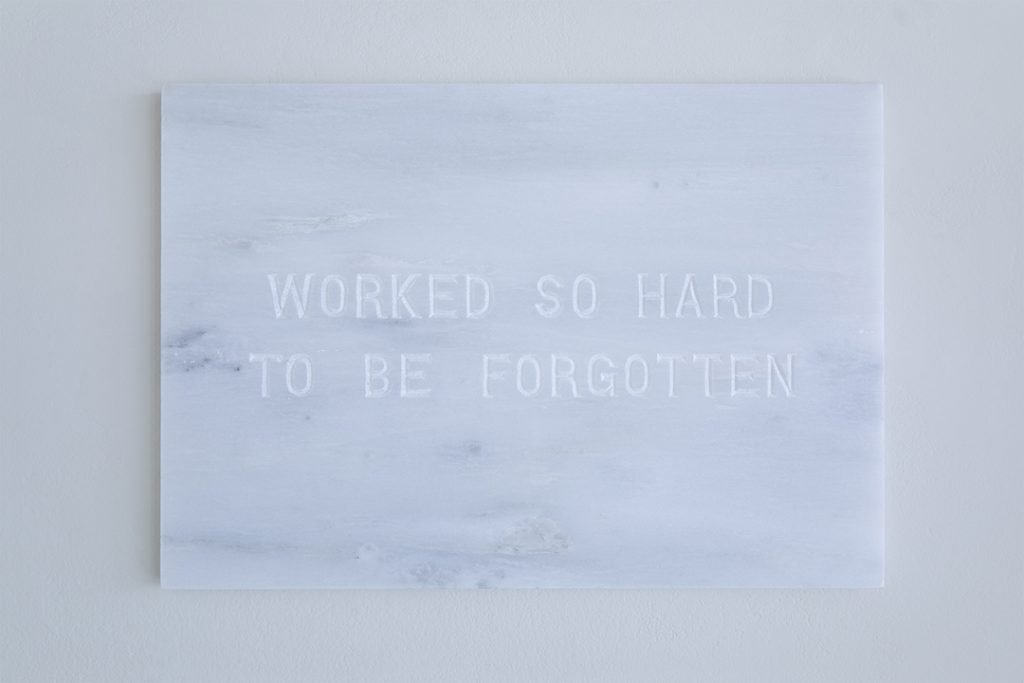
GDPR (Avrupa Birliği’nin Genel Veri Koruma Tüzüğü) kapsamında ‘unutulma hakkı’, herhangi bir kişinin bazı tartışmalı durumlarda kendisiyle ilgili olumsuz bilgilerin arama listelerinden silinmesini talep edebilmesi anlamına gelir. Taşa Kazınmış, maddelerin, yerel ötesi kültürlerin maddi değilmiş gibi görünen boyutları üzerindeki etkisi üstünde şiirsel bir meditasyon oluşturur. İnternet ortamında hem mahremiyet hem de ifade özgürlüğünün meşru ve gayrimeşru kullanımlarıyla ilgili hararetli tartışmalar devam ederken, bu çalışma Atina mermerine elle işlenmiş verilerin ömrü ile ilgili cümleler kuruyor ve böylelikle eylemlerin hem çevrimiçi hem de çevrimdışı ortamdaki sonuçlarını tarihsel olarak düşündürmeyi hatta belleğe kazımayı amaçlıyor.
Kurtuluş’a Dört Durak – Georgios Makkas
Bu çok kanallı video, 20 bini aşan Rum nüfusu nedeniyle eskiden beri ‘Küçük Atina’ olarak anılan Kurtuluş mahallesini ele alıyor. Günümüzde de bu kozmopolit mahalle, Rum nüfusun etkisi ve sayısı giderek azalmakla birlikte Türk, Rum, Ermeni, Kürt ve Musevi toplulukların yaygın olarak yaşadığı bir mahalle olmaya devam ediyor. Makkas’ın hâlâ bu mahallede yaşamayı sürdüren Rumlarla yaptığı görüşmeleri merkeze alan çalışması, ebediyen yok olacak bir şeyleri belgelendirme fırsatını değerlendirerek eski Kurtuluş’un belleğini korumayı amaçlıyor.
Ruth Catlow, Lina Džuverović, Diana Georgiou, Huma Kabakcı
Furtherfield
Furtherfield, Londra’nın en uzun süredir faaliyette olan sanat ve teknoloji (adem-i) merkezi. 20 yılı aşan deneyimimiz, 50’den fazla sergimiz ve 100’den fazla uluslararası ortaklığımızla alternatif örgütlenme ve ortak yaratım sistemlerinde uzmanlık geliştirdik. BBC, Guardian, New Scientist, Wired, Art Newspaper ve Hyperallergic çalışmalarımıza yayınlarında yer verdi. Piccadilly Metro Hattı haritasında Buckingham Sarayı’nın yanı sıra görülmesi gereken yerler arasında gösterilen Furtherfield Gallery, gelir eşitsizliğinin en yüksek oranlarda seyrettiği Haringey semtinde bulunuyor. İnsanlara hayatlarına ve yaşadıkları yere ortaklaşa sahip oldukları hissini veren çalışmalar üretmeye çalışıyoruz.
furtherfield.org
British Council
British Council, Birleşik Krallık’ın kültürel ilişkiler ve eğitim fırsatlarından sorumlu uluslararası kuruluşudur. 100’ü aşkın ülkeyle, kültür-sanat, İngilizce, eğitim ve sivil toplum alanlarında çalışmaktadır. Geçen yıl 65 milyondan fazla kişiyle yüz yüze, 731 milyonun üzerinde kişiyle de internet üzerinden, radyo ve TV programları ve basılı yayınlarla iletişim kurdu. Fırsatlar yaratarak, bağlantılar kurarak ve güven inşa ederek değiştirdiği yaşamlarla, beraber çalıştığımız ülkelere olumlu katkılar sunuyor. 1934 yılında kurulan British Council, Kraliyet Tüzüğü ile tüzel kişilik kazanmış bir hayır kurumu ve bir kamu kuruluşudur. Gelirinin yüzde 15’i ise Birleşik Krallık hükümeti tarafından karşılanmaktadır.
https://www.britishcouncil.org.tr
ATÖLYE
ATÖLYE, ödüllü Stratejik Tasarım Stüdyosu’nu canlı bir topluluk aracılığıyla iş birlikleri geliştiren Yaratıcı Platform’unun içine yerleştiren ve 21. yüzyıla ait yaratıcı hizmetler geliştiren bir organizasyondur. ATÖLYE, 2020’den itibaren değişimin öncülerini güçlendirmeyi amaçlayan Akademi’yi de hayata geçirmiştir. ATÖLYE, aynı zamanda, ekonomiyi ve toplumu harekete geçirecek yaratıcılığa kaynak olmak amacıyla kurulmuş ve stratejik olarak seçilerek özenle bir araya getirilmiş yaratıcı şirketlerden oluşan bir kolektif olan kyu Collective’in de bir parçasıdır. ATÖLYE’nin üstlendiği projeler strateji, tasarım, mimari ve teknoloji alanlarında yaratıcı danışmanlığın bütün açılarını kapsamaktadır. ATÖLYE, bu hizmetleri modern ve eşsiz bir yetenek ağı ile sunar. ATÖLYE, aynı zamanda Avrupa Yaratıcı Platformlar Ağı’nın yönetim kurulunda temsil edilen bir üyesidir. https://atolye.io/en/home/
BIOS
BIOS, Atina’da günümüz sanatı ve çapraz medyaları üzerine uzmanlaşmış bir merkezdir. BIOS iki konser sahnesi, dört barı, tiyatro ve performans mekânları, prova alanları, grafik tasarım ofisi, sinema ve enstalasyon alanıyla esnek, çok amaçlı bir merkez konumundadır.
https://www.bios.gr/
Nova Iskra
Nova Iskra, Balkanlar’da öncü bir yaratıcı platformdur. Nova Iskra, yaratıcı endüstriler, teknoloji ve insanlar arasında elle tutulur bağlantılar kurulmasını destekleyerek eleştirel düşünmeyi teşvik etme, fikirleri besleme, sürekli değişen günümüz koşullarına karşı duyarlılığını korurken gelecekte ayakta kalabilecek kurumlar tasarlama ve işletmeler kurma amacıyla kurulmuştur.
https://novaiskra.com/en/
Abdullah Gül University
Abdullah Gül Üniversitesi (AGÜ), Türkiye’de ilk vakıf destekli devlet üniversitesi modeli ile 21 Temmuz 2010 tarihinde kurulmuştur. Üniversite, Türkiye Cumhuriyeti’nin ilk ve en büyük sanayi yerleşkelerinden biri olan Sümerbank Bez Fabrikası’nın eğitim kampüsüne dönüşümü projesidir. İlk öğrencilerini 2013-2014 akademik yılında almıştır. Üniversitenin ikinci kampüsü olan Mimar Sinan Kampüsü’nün yapımı da devam etmektedir. Kayseri’ye yeni bir devlet üniversitesi kazandırılmasına yönelik çalışmalar, Büyükşehir Belediye Başkanlığı girişimiyle bir araya gelen Kayseri’nin kanaat önderleri tarafından 2007 yılında başlatılmıştır. Üniversitenin, kalkınması ve girişimciliği ile Türkiye’de örnek gösterilen Kayseri’nin vizyonuna uygun olarak, kenti eğitimde de öne çıkarması amaçlanmıştır.
http://www.agu.edu.tr/
Merkezi Finans ve İhale Birimi (CFCU)
Türkiye’yi aday ülke olarak kabul eden 10-11 Aralık 1999 tarihli Avrupa Konseyi Helsinki Zirvesi kararının ardından, Türkiye-AB mali işbirliğinin ana çerçevesi değişmiş ve AB mali yardımları katılım öncesi amaçlarına ve nihai olarak tam üyelik hedefine yönelmiştir. Bu değişiklik Türkiye’yi CFCU’nun da içinde yer aldığı, kısaca ‘‘DIS’’ olarak bilinen ‘Merkezi Olmayan Uygulama Sistemi’ ni kurmaya yönlendirmiştir. Merkezi Finans ve İhale Birimi bir uygulayıcı kurum olarak, Avrupa Birliği tarafından finanse edilen programlar kapsamındaki tüm mal ve hizmet alımları ile yapım işi ve hibelere ilişkin projelerin genel bütçeleme, ihaleye çıkma, sözleşme, ödeme, muhasebe ve mali raporlama işlerinden sorumludur. Bir ‘Program Yetkilendirme Görevlisi’ nin sorumluluğu altında çalışan CFCU, ihalelere ilişkin AB kural, düzenleme ve usullerine bağlı kalınmasını ve düzgün bir raporlama sisteminin işlemesini temin eder.
https://www.cfcu.gov.tr/
Yunus Emre Enstitüsü
Yunus Emre Enstitüsü, Türkiye’yi, kültürel mirasını, Türk dilini, kültürünü ve sanatını tanıtmak, Türkiye’nin diğer ülkelerle ilişkilerini ve dostluğunu geliştirmek, kültürel alışverişini artırmak ve Türk dili, kültürü ve sanatı alanlarında eğitim almak isteyenlere yurt dışında hizmet vermek amacıyla kurulmuştur. Eğitim, bilim ve kültür-sanat alanlarında faaliyetlerini sürdüren Enstitü, Türkiye’nin uluslararası alanda bilinirliğini, güvenilirliğini ve itibarını artırmak misyonuyla hareket ederken dünyanın her yerinde Türkiye ile bağ kuran ve Türkiye’ye dost insan sayısını artırmayı hedeflemektedir. Yunus Emre Enstitüsü, kültürel etkileşim ve diyalogu artıracak birçok farklı proje yürütmektedir. Enstitünün Avrupa Birliği ortak fonuyla hayata geçirdiği ilk projesi olan Türkiye-AB Kültürlerarası Diyalog Programını ile Türkiye ve AB ülkeleri arasındaki kültürel alışverişin ve ilişkilerin geliştirilmesi, güçlendirilmesi hedeflenmektedir. Aynı zamanda, Yunus Emre Enstitüsü’nün Avrupa ulusal kültürel enstitüleri ve onların çatı kuruluşu EUNIC ile ilişkilerinin artmasına ve güçlenmesine yönelik çalışmalar da yürütülmektedir.
https://www.yee.org.tr/en
Kültürlerarası Diyalog
Yunus Emre Enstitüsü tarafından yürütülen ve Avrupa Birliği ile Türkiye Cumhuriyeti’nin eş finansmanı ile hayata geçen AB-Türkiye Kültürlerarası Diyalog Programı, farklı kültürlerden gelen çeşitli kurumları sanat ve kültüre tahsis edilen finansal destek sayesinde bir araya getirerek AB ve Türkiye arasında kültürel diyaloğun güçlenmesini amaçlamaktadır.
https://icd.yee.org.tr
Emmy Bacharach mimarlık, ses, sinema ve çok boyutlu teknolojilerin kesişim noktasında duran bir mekân tasarımcısı, DJ ve görsel-işitsel sanatçı. Çalışmalarında dijital teknolojilerin yarattığı toplumsal, siyasi ve uzamsal olanakları inceliyor. Emmy, Cambridge Üniversitesi’nde mimarlık eğitimini tamamladıktan Royal College of Art’ta yüksek lisans yaptı ve bu sırada ses, animasyon ve çok boyutlu gerçeklikle tanıştı. Goldsmiths Digital Studios’taki Volumetric Ecologies: Environments, Bodies and Mediated Worlds sergisinde gösterilen enstalasyon çalışması ‘Proxy Architecture’, izleyiciyi sanal bir dünyayla çevreliyor. İstanbul’un dijital görüntülerinden oluşan bir yüzer şehir, sanal ortamın kolektif potansiyelini tartışmaya açıyor. Araştırma projesi ‘Sonic Urbanism in Detroit: Techno as a Spatial Act’ (Detroit’te Sonik Şehircilik: Mekânsal Bir Eylem Olarak Tekno) kentsel mekânların müzik alt kültürü üzerindeki etkisini araştırırken tekno üretiminin mekânsal özneliği ve Detroit’in sanayi-sonrası kentsel koşullarının ortaya çıkardığı sonik kolektifliği savunuyor. İnşa edilmiş ortamlarda verileri ve artırılmış gerçekliği inceleyen disiplinlerarası tasarım kolektifi Xcessive Aestehtics’in kurucularından biri. https://www.rca.ac.uk/students/emmy-bacharach/
Ruth Catlow, Furtherfield’in Eş Kurucu Sanat Direktörü ve özgürleştirici iş birliği kültürleri, uygulamaları ve poetikaları konusunda önde gelen bir otorite. Mekân yaratma, alternatif ekonomiler ve ortak paydalar temalarına odaklanan 60’tan fazla dijital sanat sergisinin eş küratörlüğünü üstlendi. Konferanslarda konuşmacı ve sanat, teknoloji ve toplumsal değişimi konu alan sayısız yayının yazarı olmasının yanı sıra uluslararası saygınlığa sahip Artists Re:Thinking the Blockchain’in editörlüğünü yaptı. 2019’da Ben Vickers (Serpentine Galleries) ve Goethe-Institut ile ortaklaşa geliştirdiği blok zinciri ve sanat laboratuvarı serisi DAOWO, Avrupa Yaratıcı Ekonomi Merkezi (European Centre for Creative Economy) ‘NICE’ ödülünü kazandı. Furtherfield bünyesindeki DeCentralised Arts Lab’in (DECAL) başındaki isim olarak sanatta yeni ekonomik modeller için sektörler arası ortaklıklar geliştirilmesine yönelik çalışmalar yürütüyor.
Dr Lina Džuverović, University of London’a bağlı Birkbeck College’de Sanat Politikası ve Yönetimi dalında küratör ve öğretim görevlisi olarak çalışıyor. Araştırmalarında güncel sanat evreninin dayanışma ve topluluk oluşturma platformu hâline gelmesini sağlayacak yöntemlere odaklanıyor. Lina’nın geçmiş yıllarda üstlendiği görevler arasında IZK – Institute for Contemporary Art, TU Graz, Avusturya bünyesindeki University of Reading’de öğretim görevlisi, Calvert 22 Foundation sanat direktörlüğü, Londra merkezli Electra’nın kurucu direktörlüğü, ICA ve Lux Centre, Londra ve Momentum Bienali, Norveç’te küratörlük sayılabilir. 2006’da Arts Council England tarafından verilen Decibel Mid-Career Curatorial Fellow ödülüne de lâyık görüldü.
Diana Georgiou, Londra’da yaşayan bir yazar ve küratör. Küratoryal çalışmalarında eşcinsel, feminist ve sömürgecilik karşıtı uygulamaları ve kuramları kullanarak kurumsal parametrelerin içinde ve dışında diyalogu, deneyimleri ve iş birliğini güçlendirecek karşılaşma mekânları yaratmaya çalışıyor. En son eş küratörlüğünü üstlendiği projelerden EcoFutures (Londra, 2019) ekolojik sorunların toplumsal cinsiyet, ırk ve cinsellik üzerindeki etkilerine odaklandı ve 70’ten fazla sanatçının, kuramcının ve aktivistin katılımıyla on ortak kuruluşu bir araya getirdi. Seçilmiş projelerinin arasında gezici video sanat sergisi Transitional States: Hormones at the Intersection of Art & Science (Londra, Lincoln, Barselona, Bolonya, 2017-18); Deep Trash Live Art Programme (Londra, 2017-18); düşünce, sanat ve aktivizmi konu alan ve The Showroom, ICA, Space Studios ve Raven Row’da gösterilmiş olan iki haftalık Now You Can Go (Londra, 2015) programı sayılabilir. Georgiou, University of London’a bağlı Goldsmiths’ten Görsel Kültür dalında doktora derecesine sahip ve tezi, feminist psikanalitik kuramlar ışığında sanat yazımı ve öznellik arasındaki ilişkiyi yenilikçi bir gözle değerlendiriyor.
Huma Kabakçı, 1990, Londra doğumlu ikinci nesil koleksiyoncu, bağımsız küratör ve Open Space’in kurucu direktörü. Londra ve İstanbul arasında hem işi hem de yaşamı nedeniyle mekik dokuyor. Kabakçı, London College of Communication’da Reklam ve Pazarlama üzerine aldığı lisans eğitiminin ardından Royal College of Art’ta Çağdaş Sanatta Kürasyon alanında yüksek lisans yaptı. Aralarında Sotheby’s’e bağlı Çağdaş Sanat Satış departmanı (Londra), The Albion Gallery (Londra) ve Pera Müzesi (İstanbul) olmak üzere Birleşik Krallık ve Türkiye’de bulunan pek çok galeri, müze ve müzayede evinde çalıştı. Kabakçı, Londra’daki Türkiye ve Orta Doğu çağdaş sanatına ve gelişmekte olan ülkelerin çağdaş sanat uygulamalarına özel olarak ilgi duyuyor. Küratoryal araştırmalarının merkezinde diaspora, göç, kültürel kimlik, kültürlerarası diyalog ve bellek konuları yer alıyor. Border_less, FAD Magazine, Guggenheim Blog, Istanbul Art News ve SYRUP Magazine gibi yayınlara katkı veriyor. Kabakçı 2018’de Liverpool Bienali kapsamında bir küratöryel ‘fellowship’ programı tamamladı. En yeni projesi ise kürasyonunu Inês Neto dos Santos ile birlikte üstlendiği, Open Space’de sergilenen Tender Touches (Yumuşak Dokunuşlar) (Londra) çalışması.
Tamara Kametani, Slovakya doğumlu, Londra’da yaşayan bir görsel sanatçı. Mekâna özgü sanatı merkeze alan enstalasyon, video, fotoğraf ve heykel gibi farklı mecraları kullanıyor. Çalışmalarında dert edindiği konular, iktidar ilişkileri, denetim, mahremiyet ve bilgiye erişim. Çağdaş ve tarihsel anlatıların üretilmesinde ve yeni deneyimlerin ortaya çıkarılmasında teknolojinin oynadığı role özel olarak ilgi duyuyor. 2017 yılında Royal College of Art’ta Çağdaş Sanat Uygulamaları programından yüksek lisans derecesi aldı. Kametani, çeşitli sanatçı rezidans programlarına katıldı; eserleri uluslararası düzeyde sergilendi. En son işleri ve sergileri arasında kürasyonunu AGORAMA, Londra’nın yaptığı (2019); Swayze ffect (Swayze Etkisi), Platform Southwark 404 – Resistance at Digital Age (Dijital Çağda Direniş), RAGE Collective, CFCCA, Manchester (2019); For the Time Being (Şimdilik), The Photographers’ Gallery, kürasyon CCA Royal College of Art, Londra (2019); Digital Diaspora (Dijital Diaspora), Studio 44, Stockholm (2019); Summer Show (Yaz Gösterisi), Florence Trust, Londra (2018) ve Triennial of Photography (Fotoğraf Trienali), Hamburg (2018) sayılabilir.
https://www.tamarakametani.com/
Georgios Makkas 1977’de Atina’da doğdu ve erken yaşlardan itibaren fotoğrafla yakından ilgilenmeye başladı. Birleşik Krallık, Newport’ta Belgesel Fotoğrafçılığı programından mezun oldu. Arnavutluk’un kırsal kesimlerinden kentlere göç konusundaki çalışması Observer Hodge Ödülleri’nde birinci seçildi. 2010 yılında Polonya’nın Poznan kentindeki Academy of Fine Arts’ın ’SETSE’ rezidans programına sanatçı olarak kabul edildi. İşleri, Londra’da National Portrait Gallery’de, Atina Fotoğraf Festivali’nde, Rethymno MedPhoto Festivali’nde, Valensiya Fotonoviembre’de, Reggio Emilia Fotografia Europea’da, Pordenone Le Voci dell’Inchiesta’da, New York DUMBO Arts Festivali’nde ve İstanbul Tasarım Bienali’nde sergilendi. Ayrıca Selanik Fotoğraf Müzesi’nde de kalıcı bir sergisi yer aldı. Makkas, mercek bazlı medyalar yoluyla belleğin korunmasıyla ilgileniyor. İnsanların portre fotoğraflarını çekmekten, hikâyelerini dinlemek ve filme almaktan, ayrıca kentlerin yok olan yüzlerini belgelemekten hoşlanıyor.
https://www.gmakkas.com/about/index
Ioana Man mimarlık, set tasarımı ve eleştirel uygulamalar alanlarında farklı disiplinleri bir araya getiren bir tasarımcı. Alternatif gelecekleri biçimlendirmek, yaratmak ve yeniden tahayyül etmek için mimari, set tasarımı ve ritüeller arasında yeni karşılaşmalar ortaya çıkarıyor. Bu günlerde mimarları ve uygulayıcı konumdaki bilim insanlarını mikroskopik ölçeğe daha da yaklaştıracak uzun soluklu bir proje üzerinde çalışıyor. Open Platform’un talebiyle Wellcome Collection için hazırladığı çalışması, Londra’da Architectural Association’da sergilendi.
www.ioanaman.com
www.probiotic-rituals.com
Theo Prodromidis, Yunanistan’ın Atina kentinde yaşayan bir görsel sanatçı ve yönetmen. Çalışmaları Galerija, State of Concept, Haus Der Kulturen Der Welt, 1. ve 5. Selanik Bienali, 4. Atina Bienali, Werkleitz Zentrum für Medienkunst ve Haus der Kulturen der Welt gibi galerilerde, müzelerde ve festivallerde sergilendi ve gösterildi. 2017’den bu yana National and Kapodistrian University of Athens’ta Bilim Felsefesi ve Tarihi bölümünde Risk Değişimi programında misafir sanatçı olarak görev alıyor ve Open School for Immigrants of Piraeus’ta gönüllü olarak çalışıyor. Institute Of Radical Imagination ve Solidarity Schools Network üyesi. 2019-2020 yıllarında ise Stavros Niarchos Vakfı Sanatçı Destek Programı’nda sanat eserleri kurulu üyesi olarak çalışmalarını yürütmeye devam edecek. www.theoprodromidis.info
Yağmur Uyanık San Francisco’da yaşayan mimarlık, yeni medya ve müzik alanlarında çalışan Türkiyeli bir sanatçı. Çalışmalarında ışık, ses ve mekânı kullanarak yer değiştirme araçlarını yaratıyor, böylelikle tekrarlama, süreç ve elle tutulamazlığa odaklanıyor. Amacı dijital medyanın sınırlarını, fiziksel bir deneyime dönüştürünceye kadar genişletmek. Uyanık, yüksek lisans derecesini Fulbright bursuyla okuduğu San Francisco Art Institute, Sanat ve Teknoloji bölümünden aldı. İşleri, Ars Electronica, Sonar +D, Signal Light Festival, MUTEK, Exploratorium, California Academy of Sciences ve Diego Rivera Gallery gibi enstitülerde uluslararası düzeyde sergilendi.
https://yagmuruyanik.com
Bu yayın Avrupa Birliğinin maddi desteği ile hazırlanmıştır. İçerik tamamıyla British Council’ın sorumluluğu altındadır ve Avrupa Birliğinin görüşlerini yansıtmak zorunda değildir
Furtherfield Gallery at the McKenzie Pavilion is located in the middle of Finsbury Park in North London, across the children’s playground from the cafe, next to the boating pond. Accessible between the gates near Finsbury Park Station and Manor House Station.
Изложба радова насталих кроз сарадњу и размену информација између турских, грчких, српских и британских уметника који покушавају да остваре транслокалну солидарност на локалном нивоу, у нашем хипер-повезаном свету.
SEE IMAGES FROM THE PRIVATE VIEW
TransLocal Cooperation exhibition, Connect for Creativity from Furtherfield on Vimeo.
Откада је наш свет постао многоструко увезан, можемо истовремено боравити или кретати се по многоструким физичким и виртуелним просторима. Последица је да се, као појединци, све више поистовећујемо са већим бројем места или култура. Овај друштвени и културни аспект глобализације често се описује као “транслокалност”(translocality), што је ситуација у којој се догађаји, условљености и везе могу брзо преносити са једног на друго место.
Ова изложба, и радови изложени на њој, баве се питањем како се треба организовати да бисмо могли водити рачуна једни о другима, на даљину и без обзира на разлике између наших локалних заједница. Приказан је избор радова настaлих током боравака турских, грчких, српских и британских уметника на уметничким и технолошким резиденцијама, у креативним центрима какви су Радионица (ATÖLYE) у Турској, биос у Грчкој и Нова искра у Србији. Кроз ове уметничке радове, поставља се питање како можемо да подржавамо многоструке идентитете и креативне изразе кроз отварање према другима и успостављање нових веза ради јачања сарадње и ширења емпатије.
Уметничке радове одабрао је наш транслокални тим турских, грчких, српских и британских кустоса, специјално за ову изложбу која се ослања на читав низ различитих медија и технологија, од виртуелне реалности и тродимензионалног штампања, па све до пробиотичке ферментације и етнографских докумената. Уметници визуелно приказују потешкоће и проблеме народа, култура и идеја расељених у простору и времену, постављајући питања о томе како их можемо преиспитати и поново вредновати ради веће транслокалне солидарности и боље размене информација у свету који се убрзано мења.
Остављајући по страни границе између овде и сада, тамо и онда, обухватајући на истом месту поплаве и расељавања у Хасан-Кејфу у Турској и избацивање грађана из станова у у Београду, у Србији, уметници користе ову прилику да проуче и испитују ефекте глобализације на поједине земље, али и да истакну као најважније питање шта треба учинити да би се сазнања о тим локалним бригама проширила изван оквира тих заједница, како да се на њих одговори и успоставе везе неспутане границама и различитим културама.
Реч је о 18-месечном пројекту који води Британски савет, у сарадњи са Атолие и Универзитетом Абдуллах Гул у Турској, те организацијама биос у Грчкој и Нова искра у Србији. Пројекат је део програма интеркултуралног дијалога који води Институт Јунус Емре, а суфинансирају га Европска унија и Република Турска. Пројекат има за циљ формирање мреже креативних центара широм Европе, са циљем подстицања креативног истраживања и сарадње који ће допринети изградњи кохезивнијег, отворенијег и боље повезаног цивилног друштва.
Програм уметничких и технолошких резиденцијалних боравака уметника из Грчке, Србије, Турске и Велике Британије у фокусу има искуство интеркултуралне сарадње. ,,Повежи се ради креативности“ је програм који је истовремено реализиован у Атини, Београду и Истанбулу кроз симултане боравке уметника у сваком од ових градова, који су били домаћини за укупно 12 учесника. Учесници су током свеобухватног шестонедељног програма откривали како умрежене културе могу допринети јачој повезаности ради успешнијег суочавања са неизвесностима и променама које доноси савремени живот.
Уметничка дела представљена су у галерији ,,Фердерфилд“, у срцу парка Финсбури. Финсбури Парк је урбани зелени простор који сваке недеље користи око 55.000 људи, а налази се у кварту који стоји на граници три лондонска округа. За тај кварт кажу да је “супер-разноврстан”, јер се у њему говори око 200 језика који припадају великим имигрантским заједницама. У овом делу града лоциране су највеће турске и грчке заједнице у Енглеској, а повезан је и са највећом српском заједницом у Енглеској, настањеном у западном Лондону.
„Отворене новине“ (Не можете избацити покрет) Теа Продромидиса (Theo Prodromidis) – у сарадњи са Teoдоросом Кариотисом, Тоњом Катерини, Статисом Митропулосом, Немањом Пантовићем и Аном Виленицом – Açık Gazete (Отворене новине)
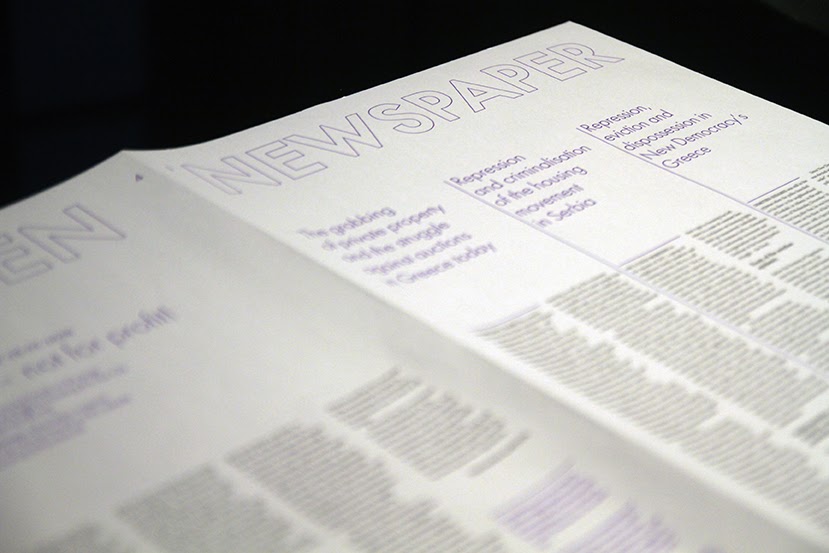
Ова студија, која се бави процесима који доводе до све чешће појаве избацивања људи из станова у Србији, повезује се са грчким контекстом у коме законски и правни оквир за заштиту првобитних станара „истиче“ у априлу 2020. године. Ово колективно дело, створено уз помоћ штампача, служи и делује као средство информисања о борбама које се воде у контексту све веће глобалне стамбене кризе.
Download and distribute your own copies now
Пробиотички ритуали (Probiotic Rituals) – Јоана Ман
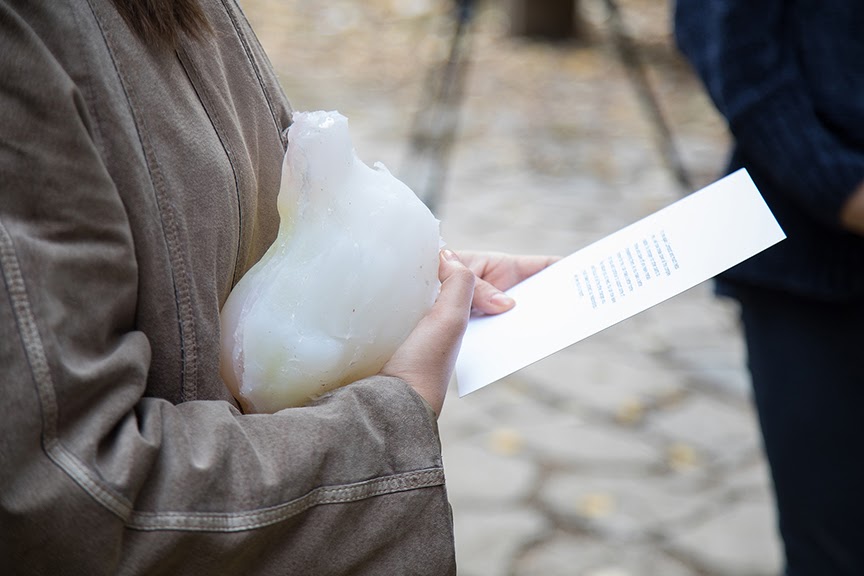
Градови су сложени екосистеми и људско присуство у њима зависи од слојевитих односа пажње која им се посвећује. Пробиотички ритуали (Probiotic Rituals) теже стварању нових обичаја за живот људи у граду, који обухвата много више од самих односа међу људима. Скалирани микроби, интерфејс проширене реалности, вебстранице и низ других ритуала, изједначавају људског посматрача са зујањем биосфере и показују зависност заједнице од микроскопског живота. Ритуали и слике живота међу разним врстама развијају процесе за побољшање суживота у коме се обраћа пажња и на оне ситније учеснике градског живота.
Самостално стварање (Kendikendiniyetiştirme): Yağmur Uyanık – „Формирање слојева постојања са“ (Selfmaking: Layers of Becoming With)

Скулптура од пешчара, настала уз помоћ 3Д штампача, хибридног је карактера, створена спајањем дигиталних модела две “оригиналне” скулптуре у Британском музеју (British Museum): скулптуре Александра Македонског трећег (познатог као Александар Велики); и старо-грчког Перикла. “Самостално стварање” комбинује звук и скулптуру, показујући како стварање, преношење и чување културног знања почива на географским контекстима, обрасцима одлазака и останка без домовине расељавања и апатридије. Пројект приказује како се индивидуалне приче и колективно сећање обликују кроз културно власништво, културну валуту и кроз симболичка значења која су им својствена.
Ток свести – Пећине Хасанкеифа – Еми Бакарак (Emmy Bacharach), 2019.
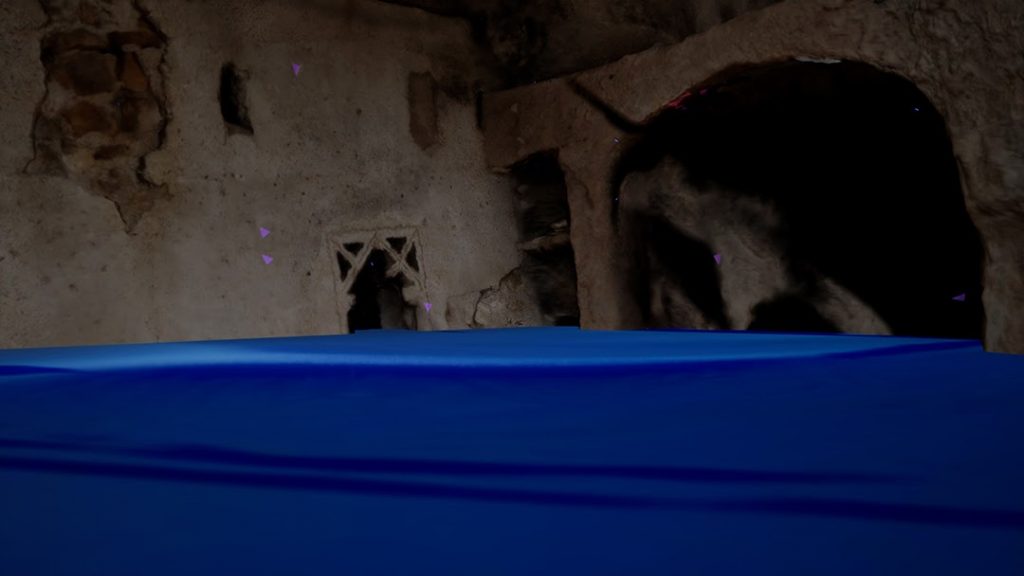
У форми искуства виртуелне стварности, овај рад скреће пажњу на локални и транслокални значај Хасанкеифа, древног града који се налази на југу Турске, а угрожен је пројектом Бране Илису (Ilisu Barajı), која прети да подигне водостај реке Диџле и поплави овај град. Хасанкејф је представљен уз коришћење фотограметрије и визуелног материјала сакупљеног са терена, пружајући људима јединствено окружење пећина, а већина ових пећина биће временом поплављена. Публика зна шта ће вода донети, и да ће пећине полако бити потопљене – искуство које је одјекнуло траумом расељеног локалног становништва.
Уклесано у камену – Тамара Каметани

„Право да будеш заборављен“ као део ГДПР-а (Опште уредбе Европске Уније о заштити података), указује на уклањање негативних информација са интернетских листа за претрагу у одређеним дискутабилним ситуацијама. ”Уклесано у камену” (Set In Stone) представља поетичну медитацију о утицају материјала на разлчичите аспекте транслокалних култура који су често нематеријалне природе. Док на мрежама букте полемике у вези легитимног коришћења, злоупотреба приватности и слободе говора, овај рад користи фразе о животу чињеница руком уклесаних у атински мермер, изазивајући историјске рефлексије или урезивање резултата ових акција у памћење, на мрежи и изван ње.
”Четири станице до Куртулуса” (Four stops to Kurtuluş) – Георгиос Макас (Georgios Makkas)
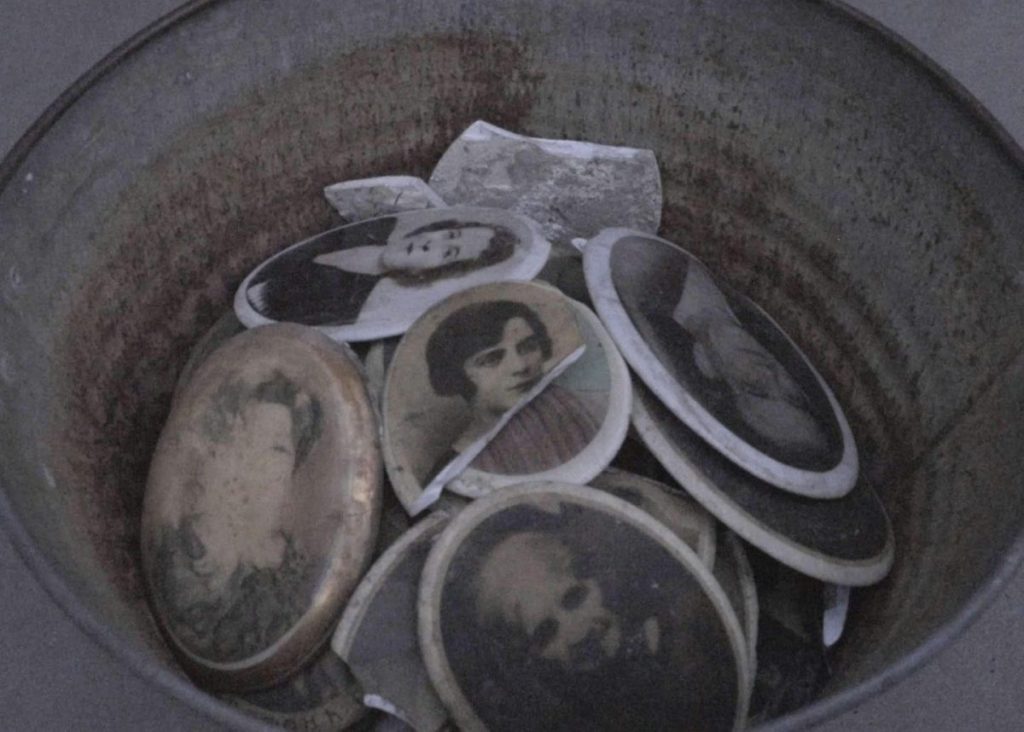
Овај вишеканални видео бави се округом Куртулуш, који је кроз историју био познат као „Мала Атина“ (на турском – Küçük Atina) због својих више од 20.000 становника грчког порекла. Данас је ово космополитско насеље дом турске, грчке, арменске, курдске и јеврејске заједнице, док његов историјски грчки утицај и број становника и даље опадају. Фокусиран на интервјуе са Грцима који живе у региону, Макасов рад покушава да сачува сећање на „Стари Куртулуш“ (“Еski Kurtuluş”) чиме користи прилику да документује нешто што ће ускоро заувек нестати.
Рут Катлоу (Ruth Catlow), Лина Џуверовић, Диана Георгију, Хума Кабакчи.
Фердерфилд (Furtherfield)
Фердерфилд је најстарији центар за уметност и технологију у Лондону, давно основан и дубоко укорењен. Са више од 20 година искуства, преко 50 реалиѕованих изложби и више од 100 међународних партнерстава, развили смо експертизу у алтернативним системима организације и здруженог стварања. Наш рад су представили ББЦ (BBC), Гардијан (Guardian), Нови научник (New Scientist), Wired, the Art Newspaper и Hyperallergic. Истакнута на мапи подземне железнице на станици Пикадили (Piccadilly Underground line) поред главних знаменитости као што је Бакингемска палата (Buckingham Palace), галерија Фердерфилд налази се у власништву локалне управе Харингеј што је локална власт са највећом неједнакошћу у дохотку у Британији. Покушавамо да произведемо дела која људима дају осећај заједничког власништва над њиховим животима и местима у којима бораве.
https://www.furtherfield.org/
Британски савет
Британски савет је британска међународна институција која се бави британским културним односима и могућностима у области образовања. Радимо са више од 100 земаља у домену уметности и културе, енглеског језика, образовања и цивилног друштва. Прошле године директно смо стигли до више од 65 милиона људи. Ако укључимо и онлајн публикације, стижемо до 731 милиона људи. Ми дајемо позитиван допринос земљама са којима радимо отварањем могућности, успостављањем веза, стварањем атмосфере поверења и утицањем на промене у начину живота. Основана 1934. године, наша институција је јавна и добротворна организација из Велике Британије створена путем краљевског едикта. Од владе Велике Британије добијамо грант који представља 15 процената нашег основног фонда.
https://www.britishcouncil.org.tr
ATÖLYE is a 21st-century creative organization with an award-winning Strategic Design Studio that is nested within a creative hub. A is a member of the European Creative Hubs Network and is represented in the Steering Committee. ATÖLYE is also part of the kyu Collective, a collective of strategically curated creative businesses whose purpose is to be a source of creativity which propels economies and societies forward. ATÖLYE’s work encompasses all facets of creative consulting including strategy, design, architecture, and technology. It provides these services through a unique modern network of practitioners. https://atolye.io/en/home/
БИОС
БИОС је центар савремене уметности и умрежених медија у Атини. БИОС је флексибилно мултифункционално подручје које обухвата два простора за музику уживо, четири бара, простор за позориште/перформанс, простор за пробе, канцеларију за графички дизајн, биоскоп и просторе за уметничћке инсталације.
https://www.bios.gr/
НОВА ИСКРА
Нова Искра има пионирску улогу међу креативним хабовима на Балкану. Нова Искра је настала на идеји стварања конкретних веза између креативних индустрија, технологије и људи како би се подржало критичко размишљање, неговале идеје и подржале дизајнерске организације уз развијање пословања оријентисаног ка будућности. Док стреми ка будућности, Нова Искра не губи из вида потребе стварности, која је у стању непрестане промене. https://novaiskra.com/en/
УНИВЕРЗИТЕТ АБДУЛЛАХ ГУЛ
Прве кораке ка оснивању Универзитета Абдуллах Гул предузели су 2007.године Општинско веће града Кајсери и значајни појединци у граду. Циљ је био подићи образовни профил у Кајсерију у складу са властитом визијом развоја града. Универзитет, прихватајући ту част, добио је име по 11. Председнику Републике Турске Абдулаху Гулу. Овај универзитет настоји да се уврсти међу високо-квалитетне елитне универзите у Турској не заостајући у надметању са другим међународним институцијама. То је први државни универзитет у Турској подржан од стране фондације. Званично је основан 21. јула 2010. године. Универзитет Абдуллах Гул (AGÜ) примио је своје прве студенте у академској 2013 – 2014. години. Универзитет је лоциран на тлу где се налазио први турски индустријски комплекс и сада је на путу да се претвори у образовну институцију историјског значаја.
http://www.agu.edu.tr/
CFCU- ЦЕНТРАЛНА ЈЕДИНИЦА ЗА ФИНАНСИЈЕ И УГОВОРЕ.
Након прихватања Турске као земље кандидата на Самиту Савета Европе у Хелсинкију, 10. и 11. децембра 1999. године., промењен је Главни оквир за финансијску сарадњу Турске и ЕУ, Финансијска подршка ЕУ усмерена је на пред-приступне циљеве и коначно пуноправно чланство. Ова промена навела је Турску да оснује систем за финансирање уговора о активностима успостављања „Децентрализованог система примене“ (MOUS). Као извршна агенција, Централна јединица за финансије и уговоре одговорна је за укупни буџет, тендере, уговоре, плаћања, рачуноводство и питања финансијског извештавања за пружање свих услуга, материјала, послова и грантова у контексту програма финансираних од Европске Уније (ЕУ). Под одговорношћу лица надлежног за одобравање програма (СОП), Централна јединица за финансије и уговоре, осигурава да се поштују правила, прописи и процедуре ЕУ везане за тендере и да функционише одговарајући систем извештавања. Централна јединица за финансије и уговоре повезана је са Под-секретаријатом за трезор, који је административно одговоран за финансијско управљање програмима које финансира ЕУ.
https://www.cfcu.gov.tr/
ИНСТИТУЦИЈА ЈУНУС ЕМРЕ
Фондација Јунус Емре је јавна организација која је основана са циљем да доприноси повећању културне размене и промовише пријатељство између Турске и других земаља, да стави на располагање релевантне документа у свету, да промовише Турску, турски језик, историју, културу и уметност, да пружа услуге и обавештења људима у иностранству у вези са турским језиком, културом и уметносшћу који желе да студирају у иностранству, у Турској. Институт Јунус Емре као институција повезана са фондацијом, поред наставка рада на достизању циљева овог закона за подучавање турског језика у културним центрима основаним у иностранству, спроводи културне и уметничке активности на промоцији наше земље и подржава научна истраживања.
https://www.yee.org.tr/en
ИНТЕРКУЛТУРАЛНИ ДИЈАЛОГ
Програмом Интеркултурални дијалог измећу ЕУ и Турске, управља институција Јунус Емре, која промовише културни дијалог између ЕУ и Турске, окупљајући различите институције различитог културног профила у контексту пружања финансијске подршке уметности и култури.
https://icd.yee.org.tr/
Еми Бакарак (Emmy Bacharach) је просторни практичар, аудио-визуелна уметница и ДЈ која ради на пресеку архитектуре, звука, филма и имерзивних технологија. Рад уметнице истражује друштвене, политичке и просторне могућности усвајања дигиталних технологија. Еми је завршила постдипломски програм на aрхитектури, на Универзитету Кембриџ (University of Cambridge), касније је завршила магистарски програм на Краљевском колеџу уметности, где почиње да се бави покретним сликама, звуцима, имерзивним (свепрожимајућим) технологијама. Њена инсталација “Proxy Architecture (Прокси Архитектура)”, приказана је у оквиру Волуметријске екологије у Дигиталним студијама Goldsmiths – Инсталацијски радови на изложби у окружењу, телима и световима за размишљање уронио је публику у виртуални свет, плутајући град дигиталних делова Истанбула, спекулирајући о колективном потенцијалу виртуалног простора. Истраживачки пројекат „Сонична урбанизација у Детроиту: Технологија у смислу просторног покрета“ говори о утицају урбаног простора на музичку суб-културу расправљајући о техно’-продукцији и звучној колективности за просторну агенцију у контексту постиндустријске урбане ситуације у Детроиту. Суоснивач је компаније ,,Xcessive Aesthetics,,То је интердисциплинарни дизајнерски колектив, који истражује проширену стварност у изграђеном окружењу
https://www.rca.ac.uk/students/emmy-bacharach/
Рут Катлоу (Ruth Catlow), је оснивач и уметничка директорка Мorefield-а. Она је успешни стручњак који се бави ослобађањем мрежних култура, пракси и поезије. Сајт је организовао више од 60 изложби дигиталних уметности око алтернативних економија и заједничких тема. Ауторка је бројних публикација о уметности, технологији и друштвеним променама, а била је главни говорник и уредник међународно признатих Blockchain – Уметници који размишљају. Освојила је награду Центар за креативну економију Европе ‘NICE’, blockchain и арт лабораторија серије DAOWO, 2019. године од стране Ben Vickers (Serpantin) и Goethe-Institut. Она је директорка DECAL-а – Децентрализоване уметничка лабораторија, која развија међуиндустријска партнерства за нове економске моделе уметности.
Др Лина Џуверовић, је кустос и предавач у области уметничке политике и менаџмента на Лондонском универзитету – Колеџ Биркбек. Њено истраживање фокусира се на начине на које би област савремене уметности могла да постане центар солидарности и да доприноси учвршћивању заједница. Лина је претходно предавала на Универзитету Рединг, на Институту за савремену уметност (ИЗК), у ТУ у Грацу, у Аустрији, била је метнички директор Фондације „ Калверт 22,“ као и и оснивач и директорка агенције “ Електра“ са седиштем у Лондону. Радила је на пословима кустоса у ICA (Institute for Contemporary Art) и у Центру Лукс, у Лондону, као и на бијеналу Моментум у Норвешкој. 2006.године,била је сарадник кустошког програма „Десибел“, под покровитељством Уметничког савета Енглеске (Arts Council, England).
Диана Георгију (Diana Georgiou), писац и кустос која живи у Лондону. У свом кустошком раду користи различите, феминистичке и антиколонијалне праксе и теорије како би створила подручја сусрета која могу унапредити дијалог, експериментирање и сарадњу унутар и изван институционалних параметара. Најновији заједнички пројекат Eco Futures (Лондон, 2019), фокусирао се на ефекте еколошких питања нација, раса и сексуалности и укључивао је 10 партнерских организација уз учешће више од 70 уметника, теоретичара и активиста. Међу одабраним пројектима били су; видео уметничка изложба Земље у транзицији, Изложба : Хормони на раскрсницама науке и уметности (Лондон, Lincoln, Барцелона, Болоња, 2017-18); Deep Trash (Дубоко смеће), Уметнички програм уживо (Лондон, 2017-18); The Showroom, ICA, Space Studios ve Raven Row (Лондон, 2015); двонедељни програм ,,Now You Can Go, (Сада можеш да идеш) који је општеприхваћен као феминистичка мисао, уметност и активизам. Диана је докторирала јвизуалну културу на Goldsmiths-у, Универзитет у Лондону. На иновативан начин описује однос између феминистичке психоаналитичке теорије, уметничког писања и субјективности.
Хума Кабакчи (Huma Kabakcı) (рођена 1990.године, у Лондону) Колекционар друге генерације која живи и ради између Лондона и Истанбула, Независни је кустос и оснивач – директор Отвореног простора (Open Space). Хума Кабакчи, дипломирала је на курсу рекламе и маркетинг на Колеџу за комуникације у Лондону и магистрирала је Савремене уметности на Краљевском колеџу уметности. Радила је у Енглеској и Турској у разним галеријама, музејима и акцијским кућама укључујући Одељење за продају дела савремене уметности „Sotheby“ (у Лондону), Галерија Албион (у Лондону) и Музеј Пера (у Истанбулу). Хума Кабакчи, посебно се занима турско-блискоисточном савременом уметношћу и савременом уметношћу која се приказује у Лондону. Њена кустошка истраживања и аналазе се често односе на дијаспору, попут миграција, културног идентитета, интер-културалног дијалога и сећања. Доприносила је изради публикација као што су Border_less, FAD Magazine, Guggenheim Blog, IAN (Istanbul Art News) и SYRUP Magazine. Хума Кабакчи, је завршила кустошки курс на Liverpool Bienalе у Ливерпулу 2018. године. Најновији пројекат зове се ,,Додир понуде“, (Лондон), организован је од стране Open Space, где је кустос Инес Нето дос Сантос (Inês Neto dos Santos).
Тамара Каметани (Tamara Kametani), је словачка уметница из Лондона. Рођена је у Словачкој, али ради у различитим окружењима, укључујући и рад на инсталацијама, видео, фотографију и скулптуру. Кључна питања у њеном раду су односи између власти, надзора, приватности и приступа информацијама. Посебно је занима улога коју технологија игра у изградњи савремених и историјских наратива и нова искуства која она пружа. 2017. године магистрирала је из Праксе савремене уметности на Краљевском факултету уметности. Тамара Каметани је учествовала у већем броју уметничких резиденција и излагала на међународном нивоу. Међу најновијим комисијама и изложбама налази се: Swayze ефекат (Swayze effect), AGORAMA, Лондон (Лондон) (2019) кустос Platform Southwark; 404- Отпор у дигиталном добу (404-Resistance in the Digital Age) , RAGE Collective, CFCCA, Manchester (2019); За сада (For the Time Being) Галерија Уметника Фотографије, Лондон (2019). Кустос је CCA Краљевске колеџ за уметност; Дигитална дијаспора, Студио 44, Стокхолм (2019);Summer Show, Florence Trust, Londra (2018) ve Triennial of Photography, Hamburg(2018).
https://www.tamarakametani.com/
Георгиос Маккас (Georgios Makkas)
Рођен је у Атини 1977. године. Од раног детињства веома су га интересовале професије везане за Документарну фотографству. Тај студиј је завршио у Њупорту, у Енглеској. Освојио је низ признања и прво место, награду ,,Observer Hodge Award”, zahvaqujući свом радu o становништву руралне Албаније. Маккас je у 2010. години, bio уметник-резидент у Познану, где је учетвовао на резиденцијалном програму „СЕТСЕ“ на Пољској Академији ликовних уметности. Његов рад је изложен у Националној галерији портрета у Лондону, на Атинском фотографском фестивалу, Med-photo Festivalnу Ретимну, Foto Noviembre, Валенциа, Фотографиа Еуропеа у Регио Емилиа, (Le Vocidell’Inchiesta) у Порденонеу, ДУМБО АртФестивал у Њујорку и на Истанбулском бијеналу дизајна и такође је организован у сталној колекцији Музеја фотографије у Солуну. Макас, се бавио чувањем сећања кроз објектив. Ова његова апликација фотографисањa портрета, слушање причa и снимање прича људи, документовање несталог лица градова. За више информација: https://www.gmakkas.com/about/index
Јоана Ман (Ioana Man), је мултидисциплинарни дизајнер са архитектуром, сценографијом и критичком праксом. Њен приступ омогућава нове сусрете између областима архитектуре, науке и ритуала како би се обликовало, пронашло и редизајнирало алтернативно опредељење будућности. Тренутно је тежиште на дугорочном пројекту чији је циљ приближити архитекте микроскопској скали и научницима који је користе. Њен рад је откупљен од стране Отворене платформе у колекцији Wellcome, изложеној у Лондонском архитектонском удружењу. www.ioanaman.com
www.probiotic-rituals.com
Тео Продромидис (Theo Prodromidis), је визуелни уметник и филмски режисер који живи у Атини. Његови радови су излагани у галеријама, музејима и фестивалима као што су Галерија Нова, тање концепта, прво и пето Солунско Бијенале, Четврто Атинско Бијенале, WerkleitzZentrum Für Medienkunst и Haus Der Kulturen Der Welt. Од 2017. Године добровољно је радио на Одељењу за историју и филозофију Националног и Каподистријског Универзитету у Атини као извођач у оквиру програма Промена ризика и волантирао је у Отвореној школи „Имигранти Пиреја“. Члан је Института за радикалну имагинацију и члан Савета мреже школа солидарности. Тренутно је члан 2019-2020 -Artworks, Програм за стипендије уметничке Фондације Stavros Niarchos.
www.theoprodromidis.info
Јагмур Ујаник (Yağmur Uyanık) је турска уметница која живи у Сан Франциску и бави се областима архитектуре, нових медија и музике. Својим радовима, ова уметница истражује понављања, процесе и нематеријалне ствари стварајући медије за премештање помоћу светлости, звука и простим ширењем дигиталних медија у физичко искуство. Јагмур Ујаник је магистрирала уметност и технологију на Институту за уметност у Сан Франциску као прималац Фулбрајтове стипендије. Рад уметнице је приказан у институцијама као што су Ars Electronica, Sonar D+, Signal Light Festival, MUTEK, Exploratorium, Академија наука, у Калифорнији и у Галерији „ Diego Rivera“.
https://yagmuruyanik.com
Ова публикација произведена је уз финансијску подршку Европске уније. За њену садржину одговоран је искључиво Европски савет, па изнети ставови не морају да се поклапају са ставовима Европске уније.
Furtherfield Gallery at the McKenzie Pavilion is located in the middle of Finsbury Park in North London, across the children’s playground from the cafe, next to the boating pond. Accessible between the gates near Finsbury Park Station and Manor House Station.
Μία έκθεση έργων που προέκυψε μέσα από την συνεργασία και ανταλλαγή γνώσεων μεταξύ καλλιτεχνών από την Τουρκία, την Ελλάδα, την Σερβία και την Αγγλία σε αναζήτηση διατοπικής αλληλεγγύης σε έναν υπερσυνδεδεμένο κόσμο.
SEE IMAGES FROM THE PRIVATE VIEW
TransLocal Cooperation exhibition, Connect for Creativity from Furtherfield on Vimeo.
Το γεγονός ότι ο κόσμος μας είναι πλέον υπερσυνδεδεμένος μας έχει δώσει τη δυνατότητα να ταξιδεύουμε ή και να βρισκόμαστε ταυτόχρονα, σε διαφορετικούς φυσικούς και ψηφιακούς τόπους. Αποτέλεσμα αυτής της δυνατότητας είναι το ότι οι ταυτότητές μας καθορίζονται αυξανόμενα από παραπάνω από έναν τόπο και πολιτισμικό πλαίσιο. Αυτή η κοινωνική και πολιτισμική πλευρά της παγκοσμιοποίησης περιγράφεται συχνά με όρους «διατοπικότητας», όπου τα γεγονότα, οι συνθήκες και οι σχέσεις που συναντώνται σε μία περιοχή μπορούν να επηρεάσουν και να συνδεθούν ταχύτατα με τις ιδιαίτερες συνθήκες που επικρατούν σε μία άλλη.
Η έκθεση «Διατοπικές Συνεργασίες» και τα έργα αυτής, εξερευνούν τους τρόπους με τους οποίους μπορούμε να οργανώσουμε από κοινού τις αποστάσεις και τις διαφορές μέσα αλλά και προς όφελος των διατοπικών μας κοινωνιών. Η έκθεση παρουσιάζει μία επιλογή έργων που δημιουργήθηκαν από καλλιτέχνιδες και καλλιτέχνες με καταγωγή από την Τουρκία, την Ελλάδα, την Σερβία και το Ηνωμένο Βασίλειο κατά τη διάρκεια της συμμετοχής τους σε residencies στο ATÖLYE στην Τουρκία, Bios στην Ελλάδα και Nova Iskra στην Σερβία. Τα έργα θέτουν το ερώτημα πώς πιθανά θα μπορούσαμε να γιορτάσουμε αυτές τις πολλαπλές ταυτότητες και τις δημιουργικές εκφράσεις τους καθώς μοιραζόμαστε αυτές τις νέες συνδέσεις και είμαστε ανοιχτοί για μεγαλύτερη συνεργασία και ενσυναίσθηση.
Τα έργα επιλέχθηκαν από την επιμελητική ομάδα μας που απαρτίζεται από επιμελήτριες με καταγωγή από την Τουρκία, την Κύπρο, την Σερβία και την Αγγλία, και περιλαμβάνουν μέσα και τεχνολογίες που ποικίλλουν από εικονική πραγματικότητα και 3D printing έως προβιοτική ζύμωση και εθνογραφική τεκμηρίωση. Οι καλλιτέχνες εξερευνούν τις προκλήσεις των ανθρώπων, των πολιτισμών και των ιδεών που έχουν εκτοπιστεί χωρικά και χρονικά, καθώς και τις δυνατότητες επανεκτίμησης και επαναδιαπραγμάτευσής τους με στόχο την διατοπική αλληλεγγύη και την ανταλλαγή γνώσης μέσα σε έναν συνεχώς μεταβαλλόμενο κόσμο.
Ανάμεσα στο εδώ και τώρα, το εκεί και τότε, μεταξύ της ορμητικής και εξελισσόμενης μετατόπισης των ανθρώπων στο Hasan Keyif της Τουρκίας και τον εκτοπισμό των πολιτών που υφίστανται εξώσεις στο Βελιγράδι της Σερβίας, οι καλλιτέχνες εξετάζουν τις επιδράσεις της παγκοσμιοποίησης σε συγκεκριμένες γεωγραφικές περιοχές και αναδεικνύουν το πώς τα «τοπικά» ζητήματα μπορούν να πληροφορήσουν και να δώσουν απαντήσεις με έναν τρόπο που υπερβαίνει τα σύνορα και τα πολιτισμικά πλαίσια.
To 18μηνο έργο Connect for Creativity πραγματοποιείται υπό την εποπτεία του Βρετανικού Συμβουλίου σε συνεργασία με το ATÖLYE και το Abdullah Gül University στην Τουρκία, το Bios στην Ελλάδα και το Nova Iskra στην Σερβία. Το έργο είναι μέρος του προγράμματος Intercultural Dialogue που πραγματοποιείται από το Yunus Emre Institute και συγχρηματοδοτείται από την Ευρωπαϊκή Ένωση και την Δημοκρατία της Τουρκίας. Το έργο στοχεύει στη δημιουργία ενός δικτύου δημιουργικών κόμβων ανά την Ευρώπη το οποίο θα προάγει τις δημιουργικές αναζητήσεις και συνεργασίες και θα συμβάλλει σε μία πιο συνεκτική, ανοιχτή και συνδεδεμένη κοινωνία των πολιτών.
Το Πρόγραμμα Art and Technology Residency εστιάζει στην διαπολιτισμική συνεργατική εμπειρία και φέρνει κοντά καλλιτέχνες από την Ελλάδα, την Σερβία, την Τουρκία και την Αγγλία. Το πρόγραμμα διεξήχθη παράλληλα στην Αθήνα, το Βελιγράδι και την Κωνσταντινούπολη και φιλοξένησε τέσσερις καλλιτέχνες σε κάθε πόλη, συνολικά δώδεκα συμμετέχοντες στο πρόγραμμα. Μέσω του προγράμματος που διήρκησε έξι εβδομάδες οι συμμετέχοντας διερεύνησαν το πώς οι δικτυωμένες κοινωνίες μπορούν να αναπτύξουν μεγαλύτερη συνοχή έτσι ώστε να αντιμετωπίσουν την αβεβαιότητα και τις μεταβολές που χαρακτηρίζουν τον σύγχρονο τρόπο ζωής.
Τα έργα εκτίθενται στην γκαλερί Furtherfield, στην καρδιά του πάρκου Finsbury. Ένας αστικός πράσινος χώρος που χρησιμοποιείται από περίπου 55.000 άτομα κάθε εβδομάδα, το πάρκο Finsbury βρίσκεται στα σύνορα τριών δήμων του Λονδίνου, σε μία πολυπολιτισμική γειτονιά, με περίπου 200 διαφορετικές γλώσσες να ομιλούνται τοπικά από μεγάλες κοινότητες μεταναστών. Συγκεκριμένα, η περιοχή στεγάζει τις μεγαλύτερες τουρκικές και ελληνικές κοινότητες της Αγγλίας και συνορεύει με την μεγαλύτερη σερβική κοινότητα στο Δυτικό Λονδίνο.
Θεόδωρος Καρυώτης, Τόνια Κατερίνη, Στάθης Μητρόπουλος, Nemanja Pantovic και Ana Vilenica

Το έργο διερευνά τις διαδικασίες που οδήγησαν σε ένα μεγάλο κύμα εξώσεων στην Σερβία και το συνδέει με την ελληνική πραγματικότητα όπου το νομικό πλαίσιο για την προστασία της πρώτης κατοικίας είναι προγραμματισμένο να «λήξει» τον Απρίλιο του 2020. Πρόκειται για μία έκδοση που έχει παραχθεί συλλογικά και λειτουργεί ως ένα όχημα πληροφόρησης για τους αγώνες στο πλαίσιο μίας διαρκώς αυξανόμενης παγκόσμιας στεγαστικής κρίσης.
Κατεβάστε και μοιραστείτε τα δικά σας αντίτυπα τώρα
Προβιοτικές Τελετουργίες, Ioanna Man

Οι πόλεις είναι πολύπλοκα οικοσυστήματα και η ανθρώπινη ύπαρξη εντός αυτών εξαρτάται από διαστρωματωμένες σχέσεις φροντίδας. Οι Προβιοτικές Τελετουργίες επιδιώκουν να καθιερώσουν νέες συνήθειες για μία ζωή στην πόλη που δεν συμπεριλαμβάνει μόνο τον ανθρώπινο παράγοντα. Μεγεθυμένα μικρόβια, επαυξημένη πραγματικότητα, ένας διαδικτυακός τόπος και μία σειρά τελετουργιών καθιστούν τον ανθρώπινο παρατηρητή ισότιμο με τον βόμβο της βιόσφαιρας και αναδεικνύουν την εξάρτηση της κοινωνίας από την μικροσκοπική ζωή. Τελετουργίες και εικονογραφίες ποικίλων οργανισμών αναπτύσσουν μία διαδικασία για την βελτίωση της συνύπαρξης με τα μικρότερα στοιχεία της πόλης.
Το ποιείν του εαυτού: επίπεδα του συν-γίγνεσθαι, Yağmur Uyanık

Ένα 3D printed γλυπτό από ψαμμίτη που απεικονίζει έναν υβριδικό χαρακτήρα ο οποίος δημιουργήθηκε από την ένωση των ψηφιακών μοντέλων δύο «αυθεντικών» γλυπτών του Βρετανικού Μουσείου: του Αλεξάνδρου ΙΙΙ του Μακεδόνα (Μέγας Αλέξανδρος), και του Περικλή της αρχαίας Ελλάδας. To έργο συνδυάζει τον ήχο και την γλυπτική, τονίζοντας πως η δημιουργία, η διάδοση και η προστασία της πολιτισμικής πληροφορίας βρίσκονται στα θεμέλια των γεωγραφικών συνθηκών, των μοτίβων εκτοπισμού μετατοπίσεων και της ανιθαγένειας (statelessness). Διερευνά το πώς η ατομική αφήγηση και η συλλογική μνήμη διαμορφώνονται μέσα από την πολιτισμική περιουσία, την πολιτισμική κληρονομιά και τις συμβολικές τους ερμηνείες.
Ροή Συνείδησης / Οι Σπηλιές του Hasankeyf, της Emmy Bacharach

Έχοντας τη μορφή μιας εμπειρίας εικονικής πραγματικότητας, το έργο αυτό εφιστά την προσοχή στην τοπική και διατοπική σημασία του Hasankey, μίας αρχαίας πόλης στην νοτιοανατολική Τουρκία, η ύπαρξη της οποίας απειλείται από το πρότζεκτ Ilisu Dam – που θα προκαλέσει την άνοδο της στάθμης του ποταμού Τίγρη και το επακόλουθο πλημμύρισμα της πόλης. Το έργο αναπαριστά το Hasankey χρησιμοποιώντας φωτογραμμετρία και οπτικό υλικό που έχει συλλεχθεί από την περιοχή, δίνοντας μία γεύση από το μοναδικό περιβάλλον των σπηλαίων, πολλά από τα οποία σύντομα θα πλημμυρίσουν. Ο θεατής βιώνει την εμπειρία από τη θέση του νερού και έτσι, όσο τα σπήλαια σταδιακά βυθίζονται, μία συνθήκη που ομοιάζει με το τραύμα του εκτοπισμένου τοπικού πληθυσμού.
Επάνω στην Πέτρα, της Tamara Kametani

Ως μέρος του GDPR (Γενικός Κανονισμός Προστασίας Δεδομένων της Ευρωπαϊκής Ένωσης) το «δικαίωμα στη λήθη» σημαίνει ότι ένα άτομο μπορεί, υπό ορισμένες προϋποθέσεις, να αιτηθεί να αφαιρεθούν αρνητικές πληροφορίες που το αφορούν από λίστες αναζήτησης. Το Set in Stone αποτελεί έναν ποιητικό διαλογισμό σχετικά με την επίδραση των υλικών σε φαινομενικά άυλες πτυχές των διατοπικών πολιτισμών. Εν μέσω οργισμένων συζητήσεων σχετικά με τις νόμιμες χρήσεις και παραβιάσεις τόσο της ιδιωτικότητας όσο και ελευθερίας έκφρασης στο διαδίκτυο, το λεργο παρουσιάζει φράσεις για τη ζωή των δεδομένων, χαραγμένες με το χέρι σε αθηναΐκά μάρμαρα, με σκοπό την πρόκληση μιας ιστορικής αντανάκλασης, ή έστω μιας υπενθύμισης των συνεπειών των πράξεων εντός και εκτός των δικτύων.
Τέσσερις στάσεις για τα Ταταύλα (Kurtuluş), του Γεώργιος Μάκκας

Το πολλαπλών καναλιών αυτό βίντεο εξερευνά τη γειτονιά των Ταταύλων (Kurtuluş), που είναι γνωστή ιστορικά ως «Μικρή Αθήνα» (“Küçük Atina” στα Τουρκικά), λόγω ενός ελληνικού πληθυσμού μεγαλύτερου των 20,000 ανθρώπων. Η κοσμοπολίτικη αυτή γειτονιά σήμερα αποτελεί στέγη για τουρκικές, ελληνικές, αρμένικες, κουρδικές και εβραϊκές κοινότητες, ενώ η ιστορική ελληνική επιρροή εξακολουθεί να υπάρχει. Το έργο του Μάκκα απαρτίζεται από συνεντεύξεις των Ελλήνων ανθρώπων που ζουν ακόμη εκεί (Rum), ενώ επιδιώκει να διατηρήσει τη μνήμη του «παλιού Kurtuluş» με το να καταγράψει κάτι το οποίο πρόκειται να εξαφανιστεί για πάντα.
Ruth Catlow, Lina Džuverović, Diana Georgiou, Huma Kabakcı
Το Furtherfield είναι το μεγαλύτερο (απο)κέντρο τέχνης και τεχνολογίας του Λονδίνου. Με εμπειρία μεγαλύτερη των 20 ετών, με 50+ εκθέσεις και παραπάνω από 100 διεθνείς συνεργασίες, το Furtherfield ειδικεύεται σε εναλλακτικά συστήματα οργάνωσης και συν-δημιουργίας. Το έργο του έχει προβληθεί στο BBC, το Guardian, το New Scientist, το Wired, το the Art Newspaper και το Hyperallergic. Συνυπάρχοντας στον χάρτη της γραμμής μετρό Piccadilly με κεντρικούς προορισμούς όπως το Παλάτι του Buckingham, η γκαλερί Furtherfield βρίσκεται στον δήμο Haringey – την τοπική αρχή της Αγγλίας με τα υψηλότερα ποσοστά εισοδηματικής ανισότητας. Το Furtherfield επιδιώκει να παράγει έργο που δίνει στους ανθρώπους την αίσθηση ότι είναι κάτοχοι των ζωών και των τοποθεσιών τους. https://www.furtherfield.org/
Το Βρετανικό Συμβούλιο είναι ο διεθνής οργανισμός της Αγγλίας που προωθεί τις διαπολιτισμικές σχέσεις και τις ευκαιρίες εκπαίδευσης με δραστηριότητα σε πάνω από 100 χώρες στα πεδία της τέχνης και του πολιτισμού, της Αγγλικής γλώσσας, εκπαίδευσης και της αστικής κοινωνίας. Η άμεση απήχηση του έργου του Βρετανικού Συμβουλίου τον τελευταίο χρόνο έφτασε τα 65 εκατομμύρια ανθρώπους και τα 731 εκατομμύρια ανθρώπους συνολικά, συμπεριλαμβανομένων διαδικτυακών μεταδόσεων και δημοσιεύσεων. Το Βρετανικό Συμβούλιο συνεισφέρει θετικά στις χώρες με τις οποίες συνεργάζεται, αλλάζοντας τη ζωή των ανθρώπων μέσω της προσφοράς ευκαιριών και του χτισίματος διασυνδέσεων και εμπιστοσύνης. Με έτος ίδρυσης το 1934, το British Council αποτελεί μία Αγγλική κοινωνική προσφορά με Βασιλικό Καταστατικό κι ένα δημόσιο σώμα της Αγγλίας. Λαμβάνει 15 τοις εκατό χρηματοδότηση από την Αγγλική κυβέρνηση. https://www.britishcouncil.org.tr
Το ATÖLYE αποτελεί έναν δημιουργικό οργανισμό του 21ου αιώνα, με ένα Στούντιο Στρατηγικής Δημιουργίας που στεγάζεται σε έναν δημιουργικό κόμβο. Είναι μέλος του Διοικητικού Συμβουλίου των Δημιουργικών Κόμβων Ευρώπης. Το ATÖLYE είναι επίσης μέλος του kyu Collective, ενός συνεταιρισμού δημιουργικών επιχειρήσεων, στόχος του οποίου είναι να αποτελεί πηγή δημιουργίας που προωθεί οικονομίες και κοινωνίες. Η δραστηριότητα του ATÖLYE περικλείει όλα τα πεδία δημιουργικής συμβουλευτικής, όπως στρατηγικές, σχεδιασμός, αρχιτεκτονική και τεχνολογία. Παρέχει τις υπηρεσίες αυτές μέσα από ένα μοναδικό, μοντέρνο δίκτυο συμμετεχόντων. https://atolye.io/en/home/
Το BIOS είναι ένας πολιτιστικός οργανισμός που από το 2002 προωθεί τις τέχνες, τους νέους δημιουργούς και τη νέα επιχειρηματικότητα στην Αθήνα. Στηρίζει τις πρωτοπόρες δημιουργικές δυνάμεις, δημιουργεί πεδία διασύνδεσης των τεχνών, της επιστήμης, της κοινωνικής και επιχειρηματικής ζωής και συμβάλλει /επιδρά στην διαμόρφωση της πολιτιστικής ταυτότητας της πόλης. https://www.bios.gr/
Το Nova Iskra είναι ένας πρωτοπόρος δημιουργικός κόμβος στα Βαλκάνια. Δημιουργήθηκε με την ιδέα να προωθήσει δεσμούς μεταξύ δημιουργικών βιομηχανιών, τεχνολογιών και ανθρώπων, με στόχο να υποστηρίξει την κριτική σκέψη, να ενισχύσει ιδέες, να σχεδιάσει οργανώσεις και να αναπτύξει επιχειρήσεις που καθιστούν ασφαλές το μέλλον, ενώ παράλληλα να παραμείνει ευαίσθητο στο συνεχώς μεταβαλλόμενο παρόν. https://novaiskra.com/en/
Τα πρώτα βήματα για την ίδρυση του Πανεπιστημίου Abdullah Gül έγιναν το 2007 από το Δημοτικό Συμβούλιο και άλλα εξέχοντα πρόσωπα της Πόλης της Καισαρείας. Στόχος ήταν η βελτίωση του εκπαιδευτικού προφίλ της Καισαρείας ώστε να συμβαδίσει με το αναπτυξιακό όραμα της πόλης. Το Πανεπιστήμιο πήρε το όνομά του από τον 11ο πρόεδρο της Τουρκικής Δημοκρατίας, Abdullah Gül, ο οποίος δέχθηκε αυτήν την τιμή. Το πανεπιστήμιο δημιουργήθηκε με στόχο να γίνει ένα υψηλά διακεκριμένο πανεπιστήμιο στην Τουρκία και να συναγωνίζεται τα διεθνή ιδρύματα. Το πανεπιστήμιο ιδρύθηκε επίσημα στις 21 Ιουλίου 2010 ως το πρώτο ίδρυμα της Τουρκίας που υποστήριζε το Κρατικό Πανεπιστήμιο. Δέχθηκε τους πρώτους του φοιτητές την ακαδημαϊκή χρονιά 2013-2014. Η εκπαίδευση λαμβάνει χώρα σε μία περιοχή της Τουρκίας όπου βρισκόταν το πρώτο βιομηχανικό σύμπλεγμα, το οποίο μεταμορφώθηκε από ένα μέρος με μεγάλη ιστορική σημασία σε έναν σημαντικό εκπαιδευτικό χώρο. http://www.agu.edu.tr/
Μετά την απόφαση της Συνόδου Κορυφής στο Ελσίνκι του Ευρωπαϊκού Συμβουλίου στις 10-11 Δεκεμβρίου 1999, με την οποία η Τουρκία έγινε δεκτή ως υποψήφια χώρα, το κύριο πλαίσιο της οικονομικής συνεργασίας Τουρκίας – Ευρώπης άλλαξε και η οικονομική υποστήριξη της Ευρώπης στράφηκε στους στόχους της πορείας ένταξης και τελικά της πλήρους συμμετοχής. Η αλλαγή αυτή οδήγησε την Τουρκία να καθιερώσει ένα “Αποκεντρωμένο Σύστημα Εφαρμογής” (DIS) στα πλαίσια του οποίου λειτουργεί και το CFCU. Το CFCU, ως Εφαρμοστικό Όργανο, είναι υπεύθυνο για τον συνολικό προϋπολογισμό, τις προσφορές, τα συμβόλαια, τις πληρωμές, τους λογαριασμούς και τις οικονομικές πτυχές όλων των υπηρεσιών, των εφοδίων, των έργων και των επιχορηγήσεων στα πλαίσια των χρηματοδοτούμενων από την Ευρώπη προγραμμάτων. Έχοντας την ευθύνη της “Διεύθυνσης για την Εξουσιοδότηση Προγραμμάτων” (PAO), το CFCU διασφαλίζει ότι οι ευρωπαϊκοί κανόνες, νόμοι και διαδικασίες ακολουθούνται και ότι λειτουργεί ένα ορθό σύστημα αναφορών. Το CFCU συνδέεται διοικητικά με το Υφυπουργείο Οικονομικών, που είναι υπεύθυνο για την οικονομική διαχείριση των χρηματοδοτούμενων προγραμμάτων από την Ευρωπαϊκή Ένωση. https://www.cfcu.gov.tr/
Ο οργανισμός Yunus Emre είναι ένας δημόσιος οργανισμός που ιδρύθηκε για να προωθήσει την Τουρκία, την τουρκική γλώσσα, την ιστορία, τον πολιτισμό και την τέχνη της χώρας, για να καταστήσει σχετικές πληροφορίες και αρχεία διαθέσιμα προς χρήση στο κοινό, να παρέχει υπηρεσίες διεθνώς σε ανθρώπους που επιθυμούν να λάβουν εκπαίδευση στους τομείς της τουρκικής γλώσσας, πολιτισμού και τέχνης, να βελτιώσει τη φιλία μεταξύ Τουρκίας και άλλων χωρών και να αυξήσει την πολιτισμική αλληλεπίδραση. Ως ένα ίδρυμα που σχετίζεται με τον Οργανισμό Yunus Emre, πραγματοποιεί μελέτες για τη διδασκαλία της Τουρκικής σε πολιτιστικά κέντρα ανά τον κόσμο, με στόχο την προώθηση της χώρας σε πολιτισμικό και καλλιτεχνικό επίπεδο, ενώ επιπλέον παρέχει στήριξη και σε επιστημονικές έρευνες. https://www.yee.org.tr/en
Το Πρόγραμμα Διαπολιτισμικού Διαλόγου Ευρώπης- Τουρκίας διοικείται από το ίδρυμα Yunus Emre και συγχρηματοδοτείται από την Ευρωπαϊκή Ένωση και την Τουρκική Δημοκρατία και στόχο έχει να βελτιώσει τον πολιτισμικό διάλογο μεταξύ Ευρώπης και Τουρκίας φέρνοντας κοντά διαφορετικά ιδρύματα με ποικίλα πολιτισμικά προφίλ, μέσω της χρηματικής ενίσχυσης για τις τέχνες και τον πολιτισμό. https://icd.yee.org.tr
Η Emmy Bacharach είναι επαγγελματίας ειδικευμένη σε θέματα χωροταξίας, οπτικοακουστική καλλιτέχνης και DJ και εργάζεται στο σταυροδρόμι της αρχιτεκτονικής, του ήχου, του κινηματογράφου και των τεχνολογιών εμβύθισης. Το έργο της ερευνά τις κοινωνικές, πολιτικές και χωροταξικές δυνατότητες εκμετάλλευσης των ψηφιακών τεχνολογιών. Η Emmy σπούδασε αρχιτεκτονική στο Πανεπιστήμιο του Cambridge και αργότερα ολοκλήρωσε το μεταπτυχιακό της στο Royal College of Art, όπου ξεκίνησε να μελετά την κινούμενη εικόνα, τον ήχο και τις τεχνολογίες εμβύθισης. Το έργο της “Proxy Architecture”, το οποίο παρουσιάστηκε στην έκθεση “Ecologies: Environments, Bodies and Mediated Worlds” στα Ψηφιακά Στούντιο του Goldsmiths, εισάγει τους θεατές σε έναν εικονικό κόσμο, σε μία αιωρούμενη πόλη που αποτελείται από ψηφιακά κομμάτια της Κωνσταντινούπολης και αποτυπώνει σκέψεις για την συλλογική δυνατότητα του εικονικού χώρου. Το ερευνητικό της έργο “Sonic Urbanism in Detroit: Techno as a Spatial Act” ερευνά την επίδραση του αστικού χώρου στην μουσική υποκουλτούρα, συζητώντας για την χωρική παρέμβαση της τεχνολογικής παραγωγής και της ηχητικής συλλογικότητας στα πλαίσια της μετα-βιομηχανικής αστικής κατάστασης του Ντιτρόιτ. Είναι συν-ιδρύτρια του Xcessive Aesthetics, μιας διεπιστημονικής συλλογικότητας που μελετά δεδομένα και ζητήματα εικονικής πραγματικότητας σε κατασκευασμένα περιβάλλοντα.
https://rca.ac.uk/students/emmy-bacharach
Η Ruth Catlow είναι συν-ιδρύτρια και Καλλιτεχνική Διευθύντρια του Furtherfield και ηγετική προσωπικότητα σε πολλά δίκτυα χειραφετητικής κουλτούρας, πρακτικών και λόγου. Έχει συνεπιμεληθεί παραπάνω από 60 εκθέσεις ψηφιακών έργων σχετικά με θέματα επαναδιαπραγμάτευσης του δημόσιου χώρου, εναλλακτικής οικονομίας και πολιτικών κοινότητας. Βασική ομιλήτρια και συγγραφέας αμέτρητων δημοσιεύσεων σχετικών με την τέχνη, την τεχνολογία και την κοινωνική αλλαγή, έχει υπάρξει και επιμελήτρια του διεθνώς αναγνωρισμένου έργου “Artist Re:Thinking the Blockchain”. Το 2019, η σειρά έργων της “DAOWO” που δημιουργήθηκαν με τον Ben Vickers (Γκαλερί Serpentine) κέρδισαν σε Ευρωπαϊκό Επίπεδο το βραβείο NICE για τη Δημιουργική Οικονομία. Διευθύνει τα Καλλιτεχνικά Εργαστήρια “DECAL” στο Furtherfield και αναπτύσσει συνεργασίες για νέα οικονομικά στο χώρο των τεχνών.
Η Dr. Lina Džuverović είναι επιμελήτρια και Λέκτορας της Καλλιτεχνικής Πολιτικής και Διοίκησης στο Κολλέγιο Birkbeck του Πανεπιστημίου του Λονδίνου. Η έρευνά της εστιάζει σε τρόπους με τους οποίους η σφαίρα της σύγχρονης τέχνης μπορεί να αποτελέσει τόπο αλληλεγγύης και ενίσχυσης της κοινότητας. Η Lina δίδασκε παλαιότερα στο Πανεπιστήμιο του Reading στο IZK- Ίδρυμα της Σύγχρονης Τέχνης, TU Graz της Αυστρίας, ήταν Καλλιτεχνική Διευθύντρια στην Οργάνωση Calvert 22, ιδρυτική διευθύντρια στο γραφείο Electra με έδρα το Λονδίνο, ενώ έχει συμβάλλει σε έργα επιμέλειας στο ICA και στο Lux Centre στο Λονδίνο και το Momentum Biennial στη Νορβηγία. Το 2006 έλαβε τον τίτλο “Decibel Mid-Career Curatorial Fellow” στο Συμβούλιο Τεχνών Αγγλίας.
Η Νταϊανα Γεωργίου είναι συγγραφέας και επιμελήτρια με έδρα το Λονδίνο. Στην επιμελητική της πρακτική επιστρατεύει κουήρ, φεμινιστικές και απο-αποικιακές θεωρίες με στόχο τη δημιουργία τόπων συνάντησης που προάγουν τον διάλογο, τον πειραματισμό και την συνεργασία εντός και εκτός θεσμικών παραμέτρων. Το “EcoFutures”, το πιο πρόσφατο πρότζεκτ που συνεπιμελήθηκε (Λονδίνο, 2019), εστίασε στις επιδράσεις των οικολογικών ζητημάτων στο φύλο, τη φυλή και τη σεξουαλικότητα και συμπεριλάμβανε τη συμμετοχή δέκα οργανώσεων και μιας ομάδας πάνω από 70 καλλιτεχνών, θεωρητικών και ακτιβιστών. Άλλα πρότζεκτ της συμπεριλαμβάνουν την έκθεση βίντεο “Transitional States: Hormones at the Intersections of Art & Science” (Λονδίνο, Λίνκολν, Βαρκελώνη, Μπολόνια, 2017-18), το πρόγραμμα “Deep Trash Live Art” (Λονδίνο, 2017-18), το πρόγραμμα “Now You Can Go” με θέμα την φεμινιστική σκέψη, την τέχνη και τον ακτιβισμό το οποίο έλαβε χώρα διαδοχικά στα Showroom, ICA, Space Studios and το Raven Row (Λονδίνο, 2015). Η Γεωργίου έχει διδακτορικό στον Οπτικό Πολιτισμό από το Πανεπιστήμιο Goldsmiths του Λονδίνου, στο οποίο ανέπτυξε μία καινοτόμα προσέγγιση της σχέσης ανάμεσα στη γραφή για την τέχνη και την υποκειμενικότητα, υπό το πρίσμα φεμινιστικών και ψυχαναλυτικών θεωριών.
Η Huma Kabakcı (γ. το 1990, Λονδίνο) είναι μία συλλέκτρια δεύτερης γενιάς, ανεξάρτητη επιμελήτρια και ιδρυτική διευθύντρια του Open Space, που ζει και εργάζεται μεταξύ Λονδίνου και Κωνσταντινούπολης. Η Kabakcı έχει πτυχίο Διαφήμισης & Μάρκετινγκ από το College of Communication του Λονδίνου και μεταπτυχιακό στην Επιμέλεια Σύγχρονης Τέχνης από το Royal College of Art. Έχει δουλέψει σε διάφορες γκαλερί, μουσεία και τόπους δημοπρασιών τόσο στην Αγγλία όσο και στην Τουρκία, συμπεριλαμβανομένων του τμήματος Πωλήσεων Σύγχρονης Τέχνης του Sotheby’s (Λονδίνο), της Γκαλερί Albion (Λονδίνο) και του Μουσείου Πέρα (Κωνσταντινούπολη). Η Kabakcı έχει ιδιαίτερο ενδιαφέρον στην Τουρκική, Μεσανατολική σύγχρονη τέχνη και την αναδυόμενη σύγχρονη τέχνη στο Λονδίνο. Η έρευνά της αναφέρεται σε θέματα όπως η διασπορά, η μετανάστευση, η πολιτισμική ταυτότητα, ο διαπολιτισμικός διάλογος και η μνήμη. Έχει συνεισφέρει σε δημοσιεύσεις όπως στο Border_less, το περιοδικό FAD, το Guggenheim Blog, το IAN (Istanbul Art News) και το Περιοδικό SYRUP. Το 2018 η Kabakcı ολοκλήρωσε μία επιμελητική υποτροφία στo Biennial του Λίβερπουλ. Νεότερα πρότζεκτ της περιλαμβάνουν το “Tender Touches” (Λονδίνο), με τη συν-επιμέλεια της Inês Neto dos Santos, οργανωμένο από το Open Space.
Η Tamara Kametani γεννήθηκε στη Σλοβακία και κατοικεί στο Λονδίνο Σλοβάκα όπου και ασχολείται με οπτικά καλλιτεχνικά έργα σε ποικιλία από μίντια όπως εγκαταστάσεις, βίντεο, φωτογραφία και γλυπτική, με έμφαση στην διαδικτυακή εξειδίκευση. Από τα κυριότερα ζητήματα που την απασχολούν είναι οι σχέσεις εξουσίας, η παρακολούθηση, η ιδιωτικότητα και η πρόσβαση στις πληροφορίες. Ενδιαφέρεται εν μέρει για τον ρόλο που διαδραματίζει η τεχνολογία για την κατασκευή σύγχρονων και ιστορικών αφηγήσεων και οι νέες εμπειρίες που προσφέρουν. Έλαβε μεταπτυχιακό δίπλωμα στηνΣύγχρονη Καλλιτεχνική Πρακτική από το Royal College of Art το2017. Η Kametani έχει συμμετάσχει σε έναν αριθμό καλλιτεχνικών στεγάσεων και σε διεθνείς εκθέσεις. Πρόσφατες δραστηριότητες και εκθέσεις της περιλαμβάνουν το Swayze effect, Platform Southwark, χορηγούμενο από το AGORAMA. Λονδίνο (2019), 404-Resistance in the Digital Age, RAGE Collective, CFCCA, Manchester (2019); For the Time Being, The Photographers’ Gallery, χορηγούμενο από το CCA Royal College of Art, London (2019); Digital Diaspora, Studio 44, Stockholm (2019); Summer Show, Florence Trust, London (2018) και Triennial of Photography, Hamburg (2018). https://www.tamarakametani.com/
Ο Γεώργιος Μάκκας, γεννημένος στην Αθήνα το 1977, έχει ιδιαίτερο ενδιαφέρον για την φωτογραφία από νεαρή ηλικία. Είναι απόφοιτος Φωτογραφίας Ντοκιμαντέρ στο Newport της Αγγλίας. Το έργο του σχετίζεται με τη πληθυσμιακή μείωση της αγροτικής Αλβανίας και κέρδισε το πρώτο βραβείο στο Observer Hodge Award. Το 2010 ο Μάκκας συμμετείχε στο καλλιτεχνικό πρόγραμμα “SETSE” στην Ακαδημία Καλών Τεχνών στο Ποζνάν της Πολωνίας. Το έργο του εκτέθηκε στη National Portrait Gallery στο Λονδίνο, στο Φεστιβάλ Φωτογραφίας Αθήνας, στο Φεστιβάλ MedPhoto στο Ρέθυμνο, στο Fotonoviembrein Valencia, στο Fotografia Europea στο Reggio Emilia, στο Le Voci dell’Inchiesta στο Pordenone, στο DUMBO Arts Festival στη Νέα Υόρκη και στο Design Biennial της Κωνσταντινούπολης, ενώ έργα του βρίσκονται στη μόνιμη συλλογή του Μουσείου Φωτογραφίας Θεσσαλονίκης. Ο Μάκκας ενδιαφέρεται για τη διατήρηση της μνήμης μέσα από την σκοπιά του φακού των μίντια. Οι πρακτικές περιλαμβάνουν τη φωτογραφία πορτραίτου, τη μαγνητοσκόπηση ανθρώπινων ιστοριών και την αποτύπωση του εξαφανισμένου προσώπου των πόλεων. Περισσότερα στο: https://www.gmakkas.com/about/index
Η Ioana Man είναι multidisciplinary designer με παρελθόν στην αρχιτεκτονική, στον σχεδιασμό και στην κριτική πρακτική. Το έργο της παράγει νέες συνδέσεις μεταξύ των πεδίων της αρχιτεκτονικής, της επιστήμης και των τελετουργιών με σκοπό να σχηματίσει, να ανακαλύψει και να φανταστεί εναλλακτικές μελλοντικές καταστάσεις. Πρόσφατα έχει εστιάσει την προσοχή της σε ένα μακροπρόθεσμο έργο που σκοπεύει να φέρει αρχιτέκτονες κοντύτερα στην μικροσκοπική κλίμακα και στους επιστήμονες που την αξιοποιούν μεθοδολογικά. Έργα της έχουν εκτεθεί με τη στήριξη του Open Platform στη Wellcome Collection και στην Αρχιτεκτονική Κοινότητα Λονδίνου. www.ioanaman.com
Ο Θοδωρής Προδρομίδης είναι visual artist και σκηνοθέτης που μένει στην Αθήνα. Έργα του έχουν εκτεθεί σε γκαλερί, μουσεία και φεστιβάλ όπως το Galerja Nova, το State of Concept, την 1η και 5η Biennale Θεσσαλονίκης, την 4η Biennale Αθήνας, το Werkleitz Zentrum Für Medienkunst και το Haus Der Kulturen Der Welt. Από το 2017 είναι Επισκέπτης Καλλιτέχνης στα πλαίσια του προγράμματος Risk Change στο Τμήμα Ιστορίας και Φιλοσοφίας της Επιστήμης του Εθνικού και Καποδιστριακού Πανεπιστημίου Αθηνών και εθελοντής στο Ανοιχτό Σχολείο για Μετανάστες του Πειραιά. Είναι μέλος του Ιδρύματος Ριζοσπαστικής Φαντασίας, της κοινότητας του Δικτύου Σχολικής Αλληλεγγύης, καθώς και υπότροφος του Artworks, του Προγράμματος Καλλιτεχνικών Υποτροφιών του Ιδρύματος Σταύρος Νιάρχος για την περίοδο 2019-2020. www.theoprodromidis.info
Η Yağmur Uyanık είναι καλλιτέχνης από την Τουρκία με έδρα το Σαν Φρανσίσκο, με παρελθόν στα πεδία της αρχιτεκτονικής, των μίντια και της μουσικής. Το έργο της ερευνά την επανάληψη, την πρόοδο και την ασάφεια μέσα από τη δημιουργία οργάνων μετατόπισης με τη χρήση φωτός, ήχου και χώρου κι έχει ως στόχο να εκτείνει τα ψηφιακά μέσα σε τέτοιο σημείο ώστε να καταστούν φυσική εμπειρία. Η Uyanık έλαβε το Μεταπτυχιακό της στη Τέχνη & Τεχνολογία από Ίδρυμα Τέχνης του Σαν Φρανσίσκο ως υποτροφος Fulbright. Το έργο της έχει εκτεθεί σε διεθνές επίπεδο σε θεσμούς όπως το Ars Electronica, το Sonar D+, το Signal Light Festival, το MUTEK, το Exploratorium, την Ακαδημία Επιστημών της California και τη Diego Rivera Gallery. https://yagmuruyanik.com
Η παρούσα έκδοση δημιουργήθηκε με την οικονομική υποστήριξη της Ευρωπαϊκής Ένωσης. Το περιεχόμενο αυτής είναι αποκλειστική ευθύνη του Βρετανικού Συμβουλίου και δεν αντανακλά απαραίτητα τις απόψεις της Ευρωπαϊκής Ένωσης.
Furtherfield Gallery at the McKenzie Pavilion is located in the middle of Finsbury Park in North London, across the children’s playground from the cafe, next to the boating pond. Accessible between the gates near Finsbury Park Station and Manor House Station.
An exhibition of works born of cooperation and knowledge exchange between Turkish, Greek, Serbian and British artists seeking translocal solidarity in a hyper-connected world.
SEE IMAGES FROM THE PRIVATE VIEW
EXHIBITION TEMPORARILY SUSPENDED
Due to universal restrictions from the COVID-19 pandemic, Furtherfield Gallery is currently closed until further notice for the safety of staff and visitors. Please contact us at info@furtherfield.org if you need any information or assistance. Thank you for your understanding and patience. Stay safe.
TransLocal Cooperation exhibition, Connect for Creativity from Furtherfield on Vimeo.
As our world has become hyper-connected it has enabled us to simultaneously occupy or travel through numerous physical and virtual locations. A result of this is that we increasingly each identify with more than one place or culture. This social and cultural aspect of globalisation is often described in terms of ‘translocality’, where the events, conditions, and attachments of one location can rapidly influence and connect with another.
This exhibition and the works within it consider how we might organise for care across distances and differences with and for our translocal communities. It features a selection of artworks from those created by Turkish, Greek, Serbian and British artists during art and technology residences at the creative hubs ATÖLYE in Turkey, Bios in Greece, and Nova Iskra in Serbia. These artworks ask how we might celebrate plural identities and their creative expressions while opening up and sharing these new connections for greater cooperation and empathy.
Selected by our team of translocal Turkish, Greek, Serbian and British curators, the artworks in this exhibition employ a variety of media and technologies, from VR and 3D printing, to probiotic fermentation and ethnographic documentation. The artists visualise the challenges of peoples, cultures, and ideas, displaced over space and time, and explore how to re-evaluate and reconceive them for translocal solidarity and knowledge exchange in a rapidly changing world.
Crossing between the here and now, the there and then, between the flooding and ongoing displacement of people in Hasankeyf in Turkey to the displacement of citizens through evictions in Belgrade, Serbia, the artists use this occasion to examine the effects of globalisation on specific localities, but most significantly, to highlight how local concerns can inform, respond and interconnect across borders and cultures.
Connect for Creativity is an 18-month project led by the British Council, in collaboration with ATÖLYE and Abdullah Gül University in Turkey, Bios in Greece and Nova Iskra in Serbia. The project is part of the Intercultural Dialogue Programme that is led by the Yunus Emre Institute and is co-funded by the European Union and the Republic of Turkey. The project aims to form a network of creative hubs across Europe to foster creative exploration and collaboration that contributes to building a more cohesive, open and connected civil society.
Connect for Creativity’s Art and Technology Residency Programme brought together artists from Greece, Serbia, Turkey and the UK with a focus on the intercultural collaborative experience. Held simultaneously in Athens, Belgrade, and Istanbul, the residency hosted four artists in each city for a total of 12 participants in the programme. Throughout the immersive six-week programme, participants explored how a networked culture can develop cohesion to deal with the uncertainty and change that pervades modern life.
The artworks are presented at Furtherfield Gallery in the heart of Finsbury Park. An urban green space used by roughly 55,000 people per week, Finsbury Park sits at the borders of three London boroughs in a neighbourhood described as ‘superdiverse’ for the nearly 200 languages spoken locally by large migrant communities. In particular, the area is home to the UK’s largest Turkish and Greek communities and sits adjacent to the UK’s largest Serbian community in West London.
An Open Newspaper (You can’t evict a movement) by Theo Prodromidis in collaboration with Theodoros Karyotis, Tonia Katerini, Stathis Mitropoulos, Nemanja Pantović and Ana Vilenica
Addressing the processes that led to a surge of housing evictions in Serbia, this work connects to the Greek context where the legal framework for the protection of primary housing is planned to “expire” in April 2020. This collectively produced printed work acts as a vehicle of information about struggles in an ever-increasing global housing crisis.
Download and distribute your own copies now
Probiotic Rituals by Ioana Man
Cities are complex ecosystems and human existence within them depends on layered relations of care. Probiotic Rituals sets out to establish new customs for a more-than-human life in the city. Scaled up microbes, an AR interface, a website and a series of rituals, bring the human observer on par with the buzz of the biosphere and show society’s dependence on microscopic life. Multi-species rituals and imagery develop a process to improve cohabitation with the smaller elements of life in the city.
Selfmaking: Layers of Becoming With by Yağmur Uyanık
A 3D printed sandstone sculpture of a hybrid character created by fusing the digital models of two ‘original’ sculptures at the British Museum of: Alexander III of Macedon (commonly known as Alexander the Great); and Pericles of ancient Greek. Selfmaking combines sound and sculpture highlighting how creation, circulation and preservation of cultural information underlies geographical contexts, patterns of displacement, and statelessness. It reflects on how individual narrative and collective memory are shaped through cultural property, cultural currency, and their inherent symbolic meanings.
Stream of Consciousness / The Caves of Hasankeyf by Emmy Bacharach
In the form of a virtual reality experience, this work draws attention to the local and translocal significance of Hasankeyf, an ancient city in south-eastern Turkey whose existence is endangered by the Ilisu Dam project – which will cause the water levels of the Tigris river to rise and flood the town. It represents Hasankeyf using photogrammetry and visual material collected from the site, giving people a glimpse into the unique environment of the caves, many of which will shortly be flooded. Experienced from the point of view of the water, the viewer is present as the caves are gradually submerged, an experience that resonates with the trauma of a displaced local population.
Set In Stone by Tamara Kametani

As part of GDPR (The General Data Protection Regulation of the European Union) ‘the right to be forgotten’ means a person can have negative information about themselves removed from search listings under certain arguable instances. Set In Stone therefore forms a poetic meditation on the effect of materials on often immaterial-seeming aspects of translocal cultures. While debates rage about legitimate uses and abuses of both privacy and freedom of speech online, this work presents phrases about the life of data etched by hand onto Athenian marble, to provoke a historic reflection on or even memorialisation of the consequences of actions on and offline.
Four stops to Kurtuluş by Georgios Makkas
This multichannel video explores the neighbourhood of Kurtuluş which has historically been known as ‘little Athens’ ( Küçük Atina in Turkish) thanks to a Greek population of over 20,000 people. Today this cosmopolitan neighborhood is home to Turkish, Greek, Armenian, Kurdish, and Jewish communities, while the historic Greek influence and population continue to dwindle. Centered around interviews with the Greek (Rum) people still living in the area, Makkas’s work seeks to preserve the memory of the ‘old Kurtuluş’, seizing a chance to document something that is about to disappear forever.
Ruth Catlow, Lina Džuverović, Diana Georgiou, Huma Kabakcı
Furtherfield is London’s longest running art and technology (de)centre. With more than 20 years experience, through 50+ exhibitions, and over 100 international partnerships, they have developed a specialism in alternative systems of organisation and co-creation. Their work has been featured by the BBC, the Guardian, the New Scientist, Wired, the Art Newspaper and Hyperallergic. Highlighted on the Piccadilly Tube Line map of key destinations alongside Buckingham Palace, Furtherfield Gallery is in the Borough of Haringey – the UK’s local authority with the highest levels of income inequality. They strive to produce work that gives people a shared sense of ownership of their lives and localities.
The British Council is the UK’s international organisation for cultural relations and educational opportunities. They work with over 100 countries in the fields of arts and culture, English language, education and civil society. Last year, they reached over 65 million people directly and 731 million people overall including online, broadcasts and publications. They make a positive contribution to the countries we work with – changing lives by creating opportunities, building connections and engendering trust. Founded in 1934, they are a UK charity governed by Royal Charter and a UK public body. They receive 15 percent core funding grant from the UK government. https://www.britishcouncil.org.tr
ATÖLYE is a 21st-century creative organization with an award-winning Strategic Design Studio that is nested within a creative hub. A is a member of the European Creative Hubs Network and is represented in the Steering Committee. ATÖLYE is also part of the kyu Collective, a collective of strategically curated creative businesses whose purpose is to be a source of creativity which propels economies and societies forward. ATÖLYE’s work encompasses all facets of creative consulting including strategy, design, architecture, and technology. It provides these services through a unique modern network of practitioners. https://atolye.io/en/home/
Bios is the independent cultural organisation of Athens that promotes the arts, new media, young creatives and new entrepreneurship since 2002. Bios supports the innovative creative force of Athens, creates interdisciplinary common space for the arts and science, for social and entrepreneurial life and it influences and contributes in the shaping of the cultural identity of Athens. http://www.romantso.gr
Nova Iskra is a pioneering creative hub in the Balkans. Nova Iskra is created with the idea to incite tangible connections between creative industries, technology, and the people, with the goal to support critical thinking, nurture ideas, design organizations and develop businesses that are future-proof, while remaining sensible to the ever-changing present. https://novaiskra.com/en/
Abdullah Gül University was founded by the Kayseri City Council and other city notables in 2007. The aim was to raise the profile of education in Kayseri in line with the city’s own vision of its development. The University was named after the 11th president of the Turkish Republic, Abdullah Gül, who has accepted this honor, for the university is being dedicated to the quest to become a distinguished high-quality university in Turkey and be able to compete with international institutions. The university was formally founded on 21 July 2010 as Turkey’s first foundation-supported State University. AGU admitted its first students in 2013 – 2014 Academic Year. Education is being conducted at the site of Turkey’s first industrial complex, which is being transformed from a place of great historical significance to be a notable place of education. http://www.agu.edu.tr/
CFCU was established following the decision of the Helsinki Summit of the European Council on 10-11 December 1999 to accept Turkey as a candidate country. The main Framework of Turkey-EU financial cooperation has changed and EU financial assistance was directed towards the pre-accession goals and ultimately full membership. This change led Turkey to establish a ‘Decentralised Implementation System (DIS)’ under which the CFCU is also operating. The CFCU, as the Implementing Agency, is responsible for the overall budgeting, tendering, contracting, payments, accounting and financial reporting aspects of all procurement of services, supplies, works, and grants in the context of EU funded programmes. Under the responsibility of a ‘Programme Authorising Officer (PAO)’, the CFCU ensures that the EU rules, regulations and procedures pertaining to the procurement are adhered to and that a proper reporting system is functioning. The CFCU is administratively linked to the Undersecretariat of Treasury which is responsible for the financial management of EU funded programmes. https://www.cfcu.gov.tr/
Yunus Emre Foundation is a public foundation, which was founded to promote Turkey, Turkish language, its history and culture and art, make such related information and documents available for use in the world, provide services abroad to people who want to have education in the fields of Turkish language, culture and art, to improve the friendship between Turkey and other countries and increase the cultural exchange. As an institution affiliated to the Foundation, Yunus Emre Institute is carrying out studies for Turkish teaching in the cultural centers established abroad to accomplish the purposes of this law as well as conducting culture and art activities to promote our country, and giving support to scientific researches. https://www.yee.org.tr/en
The EU-Turkey Intercultural Dialogue Programme, led by the Yunus Emre Institute and co-financed by the European Union and Republic of Turkey will improve the cultural dialogue between the EU and Turkey by bringing different institutions with different cultural backgrounds together under a financial support allocated for arts and culture. https://icd.yee.org.tr
Emmy Bacharach is a spatial practitioner, audio-visual artist, and DJ working at the intersection of architecture, sound, film and immersive technologies. Her work explores the social, political and spatial possibilities of appropriating digital technologies. Emmy’s background is in architecture, which she studied at the University of Cambridge and later completed her masters at the Royal College of Art, where she began to explore moving image, sound and immersive technologies. Her installation work ’Proxy Architecture’, which was featured at the Volumetric Ecologies: Environments, Bodies and Mediated Worlds showcase at Goldsmiths Digital Studios, immerses the viewer in a virtual world, a floating city composed of digital fragments of Istanbul, speculating on the collective potential of virtual space. Her research project ‘Sonic Urbanism in Detroit: Techno as a Spatial Act’, investigates the impact of urban space on musical subculture, arguing for the spatial agency of techno production and sonic collectivity in the context of Detroit’s post-industrial urban condition. She is a co-founder of Xcessive Aesthetics, an interdisciplinary design collective exploring data and augmented reality in the built environment . https://www.rca.ac.uk/students/emmy-bacharach/
Ruth Catlow is Co-Founding Artistic Director of Furtherfield and a leading authority on emancipatory network cultures, practices and poetics. She has co-curated over 60 digital arts exhibitions around themes of placemaking, alternative economies and the commons. Keynote speaker and author of countless publications on art, technology and social change, including editing the internationally acclaimed Artists Re:Thinking the Blockchain. In 2019 her blockchain and the arts lab series, DAOWO, produced with Ben Vickers (Serpentine Galleries) and Goethe-Institut won a European Centre for Creative Economy ‘NICE’ award. She heads DECAL, Furtherfield’s DeCentralised Arts Lab, developing cross sector partnerships for new economic models for the arts.
Dr Lina Džuverović is a curator and Lecturer in Arts Policy and Management at Birkbeck College, University of London. Her research focuses on ways in which the sphere of contemporary art can become a site of solidarity and community-building. Previously Lina taught at the University of Reading, at IZK –Institute for Contemporary Art, TU Graz, Austria, was Artistic Director of Calvert 22 Foundation, founding director of the London-based agency Electra and has held curatorial roles at ICA and the Lux Centre, London and Momentum Biennial, Norway. She was the 2006 Decibel Mid-Career Curatorial Fellow, Arts Council England.
Diana Georgiou is a writer and curator based in London. Her curatorial practice employs queer, feminist and decolonial practices and theories to generate spaces of encounter that can foster dialogue, experimentation and collaboration within and outside institutional parameters. Her most recent co-curated project EcoFutures (London, 2019) focused on the implications of ecological issues on gender, race and sexuality and involved 10 partner organisations with the participation of over 70 artists, theorists and activists. Selected projects include the touring video art exhibition Transitional States: Hormones at the Intersections of Art & Science (London, Lincoln, Barcelona, Bologna, 2017-18); Deep Trash Live Art Programme (London, 2017-18); the 2-week programme Now You Can Go which considered feminist thinking, art and activism, taking place across The Showroom, the ICA, Space Studios and Raven Row (London, 2015). Georgiou holds a PhD in Visual Culture from Goldsmiths, University of London, offering an innovative account of the relationship between art-writing and subjectivity through the lens of feminist psychoanalytic theories.
Huma Kabakcı (b. in 1990, London) is a second-generation collector, independent curator and founding director of Open Space, living and working between London and Istanbul. Kabakcı holds a BA in Advertising & Marketing from London College of Communication and a MA in Curating Contemporary Art from the Royal College of Art. She has worked at various galleries, museums and auction houses, both in the UK and Turkey, including Sotheby’s Contemporary Art Sales department (London), The Albion Gallery (London) and Pera Museum (Istanbul). Kabakcı has a special interest in Turkish, Middle Eastern contemporary art and emerging contemporary art in London. Her curatorial research lies in subjects such as diaspora, migration, cultural identity, cross-cultural dialogue and memory. She has contributed to publications including Border_less, FAD Magazine, the Guggenheim Blog, IAN (Istanbul Art News) and SYRUP Magazine. In 2018 Kabakcı completed a curatorial fellowship at Liverpool Biennial. Most recent project includes Tender Touches (London) co-curated by Inês Neto dos Santos, organised by Open Space.
Tamara Kametani is a Slovak born London based visual artist working across a variety of media including installation, video, photography and sculpture with an emphasis on site-specificity. Amongst the underlying concerns in her practice are the topics surrounding power relations, surveillance, privacy, and access to information. She is particularly interested in the role that technology plays in the construction of contemporary and historical narratives and the new experiences it enables. She received her master’s degree in Contemporary Art Practice from the Royal College of Art in 2017. Kametani has participated in a number of artist residencies and exhibited internationally. Recent commissions and exhibitions include Swayze effect, Platform Southwark curated by AGORAMA, London (2019); 404- Resistance in the Digital Age, RAGE Collective, CFCCA, Manchester (2019); For the Time Being, The Photographers’ Gallery, curated by CCA Royal College of Art, London (2019); Digital Diaspora, Studio 44, Stockholm (2019); Summer Show, Florence Trust, London (2018) and Triennial of Photography, Hamburg (2018). https://www.tamarakametani.com/
Georgios Makkas was born in Athens in 1977 and had a strong interest in photography from an early age. He graduated from the Documentary Photography course in Newport, UK. His work about the depopulation of rural Albania won the first prize in the Observer Hodge Award. In 2010, Makkas participated in the artist in residence programme ‘SETSE’ at the Academy of Fine Arts in Poznan, Poland. His work has been exhibited at the National Portrait Gallery in London, Athens Photo Festival, MedPhoto Festival in Rethymno, Fotonoviembrein Valencia, Fotografia Europea in Reggio Emilia, Le Voci dell’Inchiesta in Pordenone, DUMBO Arts Festival in New York and the Istanbul Design Biennial, and also held in the permanent collection of the Thessaloniki Museum of Photography. Makkas is interested in the preservation of memory through lens-based media. His practice involves taking portraits, listening and filming people’s stories and documenting the disappearing face of cities. More at https://www.gmakkas.com/about/index
Ioana Man is a multidisciplinary designer with a background in architecture, set design and critical practice. She produces new encounters between the fields of architecture, science, and rituals in order to shape, invent and reimagine alternative futures. Currently, her focus is on a long-term project that aims to bring architects closer to the microscopic scale and to the scientists that harness it. She has had work commissioned by Open Platform at the Wellcome Collection and exhibited at the Architectural Association in London.
www.ioanaman.com
www.probiotic-rituals.com
Theo Prodromidis is a visual artist and film director based in Athens. His work has been exhibited and screened in galleries, museums and festivals including Galerija Nova, State of Concept, 1st and 5th Thessaloniki Biennale, 4th Athens Biennale, Werkleitz Zentrum Für Medienkunst and Haus Der Kulturen Der Welt.Since 2017, he has been a Visiting Artist under the program Risk Change at the Department of History and Philosophy of Science of the National and Kapodistrian University of Athens and a volunteer at the Open School for Immigrants of Piraeus. Ηe is a member of the Institute of Radical Imagination and a member of the assembly of Solidarity Schools Network. He is currently a fellow of Artworks, Stavros Niarchos Foundation Artist Fellowship Program, 2019-2020. www.theoprodromidis.info
Yağmur Uyanık is a Turkish artist based in San Francisco with backgrounds in architecture, new media and music. Her work explores repetition, process and intangibility through creating instruments of displacement using light, sound and space with an aim to extend the digital media to a point that it becomes a physical experience. Uyanık has received her MFA in Art & Technology from San Francisco Art Institute as a Fulbright scholar. Her work was shown internationally at institutions including Ars Electronica, Sonar D+, Signal Light Festival, MUTEK, Exploratorium, California Academy of Sciences and Diego Rivera Gallery. https://yagmuruyanik.com
This publication was produced with the financial support of the European Union. Its contents are the sole responsibility of British Council and do not necessarily reflect the views of the European Union.
Furtherfield Gallery at the McKenzie Pavilion is located in the middle of Finsbury Park in North London, across the children’s playground from the cafe, next to the boating pond. Accessible between the gates near Finsbury Park Station and Manor House Station.
How are attitudes to data transparency and consumer ethics shifting?
We would like to invite you to participate in our research study that takes the form of a game with many characters called Fictional Focus Group.
If you decide to take part we you will join a role-play game with 10-15 other people. You will get to escape your lock-down reality and play the role of a unique character who faces all the complex challenges of contemporary life.
The event itself will involve group discussion about the tricky choices your characters make as consumers or providers of food, clothing and money services. The game reveals the possible consequences of their actions as their data is reused in unforeseen ways.
The event will last for about 3 hours including 2 hours in the game and two 15 minutes breaks. Due to Covid-19, we are hosting this event online, using Zoom.
There are two sessions available:
29 and 30th June 2020
13.30 – 16.30
(now to be run online due to Covid-19)
For any enquiries, please email info@furtherfield.org
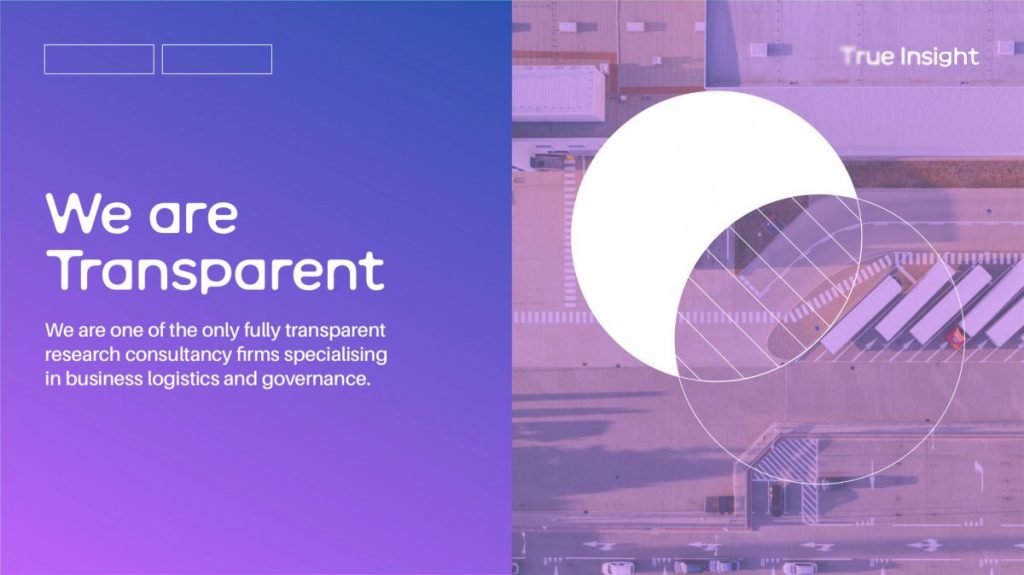
About the project
Findings contribute to a report, Glass Houses: Understanding transparency in information economies 2020.
Glass Houses is a research project that aims to investigate an end-user’s perception, understanding, and expectation of transparency in their engagement with modern information society, and in particular the role technologies, such as distributed ledgers, play in such engagement. It is funded by EPSRC through their Digital Economy Theme. glass-houses.cs.ucl.ac.uk
UCL Glass Houses Research Team: Sarah Meiklejohn is an Associate Professor in Cryptography and Security at University College London (UCL). Kruakae Pothong is a Research Fellow in Distributed Ledgers at University College London (UCL).
Fictional Focus Group is a Furtherfield/DECAL project created by Ruth Catlow with the UCL Glass Houses research team, developed in collaboration with Max Dovey.
Artist Cassie Thornton, of the Feminist Economics Department (the FED), will discuss The Hologram, a mythoreal collective peer-to-peer health project currently incubating at Furtherfield Gallery in London.
The Hologram, based on the understanding that all our crises are connected and everyone is a little sick, is a viral four-person health monitoring and diagnostic system practiced from couches all over the world.
Three non-expert participants create a three-dimensional “hologram” of a fourth participant’s physical, psychological and social health, and each becomes, in turn, the focus of three other people’s care in an expanding network.
This health distribution system is based on the experimental care models developed in the Social Solidarity Clinics in Greece during the height of the financial and migration crisis. The result is the construction of a robust network of multi-dimensional health, collectively oriented social practices, and trust that can outlive racial capitalism.
The presentation will be followed by a discussion of themes and topics. We welcome artists, healers, activists and system builders with an interest in alternative infrastructures and care as an act of resistance.
Please note The Hologram talk and workshops are now taking place online due to pandemic restrictions. Contact info@furtherfield.org if you need any further information or assistance.
About the artist
Cassie Thornton is an artist and activist who makes a “safe space” for the unknown, for disobedience and for unanticipated collectivity. She uses social practices including institutional critique, insurgent architecture, and “healing modalities” like hypnosis and yoga to find soft spots in the hard surfaces of capitalist life. Cassie has invented a grassroots alternative credit reporting service for the survivors of gentrification, has hypnotized hedge fund managers, has finger-painted with the grime found inside banks, has donated cursed paintings to profiteering bankers, and has taught feminist economics to yogis (and vice versa). She has worked in close collaboration with freelance curators and producers including Taraneh Fazeli, Magdalena Jadwiga Härtelova, Dani Admiss, Amanda Nudelman, Misha Rabinovich, Caitlin Foley and Laurel Ptak. Her projects, invited and uninvited, have appeared at (or in collaboration with) Transmediale Festival for Media Arts, San Francisco MoMA, West Den Haag, Moneylab, Swissnex San Francisco, Pro Arts Gallery & Commons, Dream Farm Commons, Furtherfield, Gallery 400, Strike Debt Bay Area, Red Bull Detroit, Elizabeth Foundation for the Arts, Flux Factory, Bemis Center for the Arts, Berliner Gazette and more.
The Hologram is part of Furtherfield’s three-year Citizen Sci-Fi programme crowdsourcing creative and technological visions of our communities and public spaces, together.
2020 is the year of Love Machines, nurturing living and machine systems for mutual care and respect on earth and beyond.
Exploring ecological conditions with the screen, this film programme recognises an alignment of self-with-other and human-with-nonhuman. Tapping into “thought-queering” as a tactic, the audience is asked to re-imagine ways of communicating as means for creating other discourse about the ongoing ecological crisis: to decentralise the concept of the self; to queer the thought process; and to occupy a multiplicity of positions.
Featuring films from Jonathas de Andrade, O Peixe (The Fish) (2016), and Zheng Bo, Pteridophilia 3 (2018). Curated by Dennis Dizon, in association with Furtherfield as part of a micro-residency.
The event is FREE! RSVP here.
About the Series
Matters of… is an ongoing critical inquiry into a queer techno-ecological. The project adopts psychosocial research methodologies, queer theory and theories of media and communication through the lens of Visual Culture. Matters of Concern is the first phase of the Matters of research series.
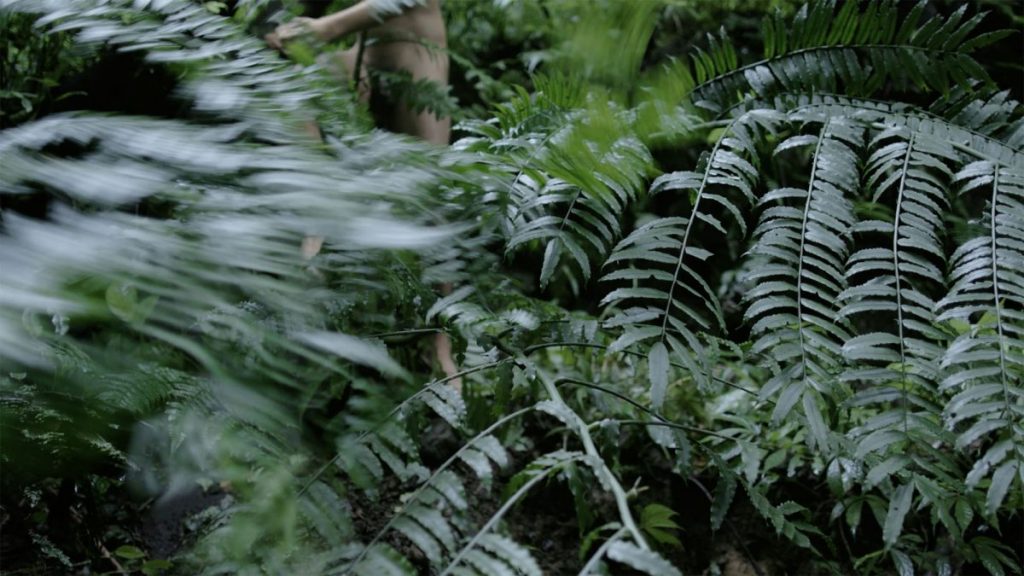
About the Artists
Zheng Bo is an artist committed to multispecies vibrancy. He investigates the past and imagines the future from the perspectives of marginalized communities and marginalized plants. He has worked with a number of art spaces in Asia and Europe, most recently ICA at NYU Shanghai, @KCUA in Kyoto, Asia Art Archive in Hong Kong, Parco Arte Vivente in Torino, TheCube Project Space in Taipei, and Villa Vassilieff in Paris. His works have been included in the performance program of the 58th Venice Biennale, Manifesta 12, the 11th Taipei Biennial, and the 11th Shanghai Biennial. In 2020, as artist-in-residence at the Gropius Bau in Berlin, he will collaborate with scientists to understand, speculate, and imagine how plants practice politics. He currently teaches at the School of Creative Media, City University of Hong Kong, where he leads the Wanwu Practice Group.
Jonathas de Andrade works with installation, photography, and video to explore constructs of love and the process of urbanization, with particular emphasis on Brazil’s vibrant but often ignored northeast region. De Andrade has had solo museum exhibitions in Instituto Cultural Itaú in São Paulo, Instituto Cultural Banco Real in Recife, Centro Cultural São Paulo, Museu de Arte Contemporânea de São Paulo, Kunsthalle Lissabon in Lisbon, Musée d’art Contemporain de Montréal, Museu de Arte do Rio, Museu de Arte de São Paulo, The Power Plant in Toronto, and New Museum in New York. He has participated at New Museum Triennial in New York, 29th São Paulo Biennial, Istanbul Biennial, Lyon Biennial, Performa15 in New York, Bienal de São Paulo, among others. He is also a former artist-in-residence at Gasworks in London. De Andrade lives and works in Recife.
About the Curator
Dennis Dizon is an independent digital research curator. He runs MATTERS OF — an ongoing critical inquiry into a queer techno-ecological. Dennis is a 2019 recipient of the Robert Rauschenberg Foundation’s Archives Research grant and holds an MRes in Curatorial/Knowledge from Goldsmiths, University of London. He was previously with Google Arts & Culture. He is a Filipino-American based in London.
Matters of Concern is part of Furtherfield’s three-year Citizen Sci-Fi programme crowdsourcing creative and technological visions of our communities and public spaces, together.
2020 is the year of Love Machines, nurturing living and machine systems for mutual care and respect on earth and beyond.
Featured Image:
Still from ‘O Peixe (The Fish)’, 2016
Jonathas de Andrade
Courtesy of the artist
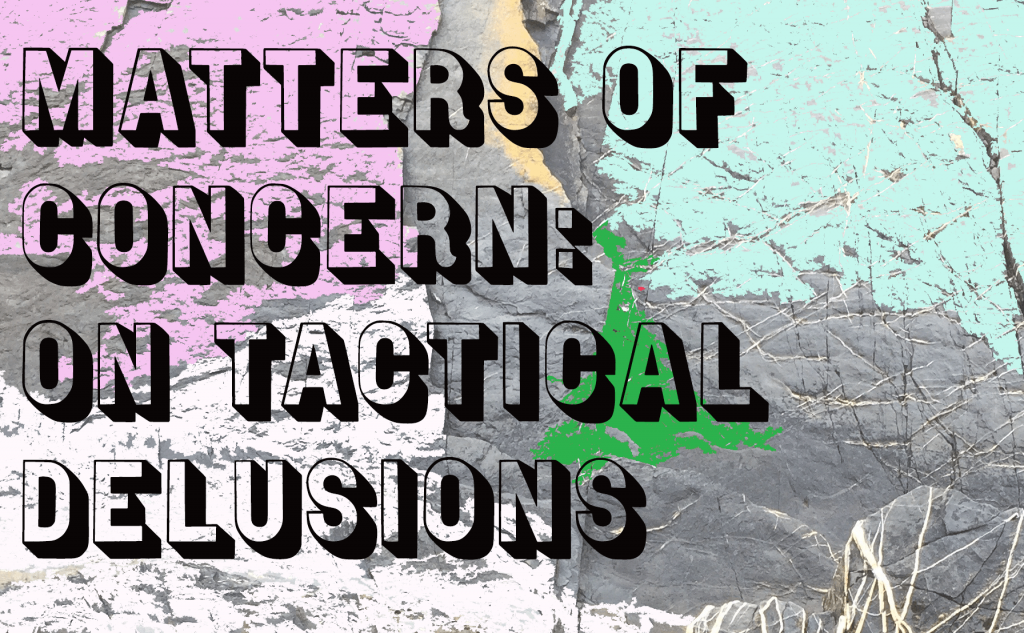
NeMe and curator Marc Garrett, Co-Founding and Co-Artistic Director of Furtherfield, have the pleasure to invite you to Children of Prometheus at NeMe Arts Centre, Limassol. The exhibition investigates the landscape of a rapidly transforming world and how some of these shifts inform and affect our immediate environment.
The complex nature of the ancient Greek myth of Prometheus has inspired philosophers, authors and artists throughout many centuries and will continue to do so because of the powerful contradictions which it embodies which reflects the ongoing dualities present in both the human mind and physical existence. Acknowledging that the Promethean spirit lives on in the ambitions of science and technology, which in many cases defies the limits imposed upon humanity by nature, the post-modern Prometheus belongs to an organised world focused on the technology of the internet. This rapidly expanding domain, with its presumed ethos of democracy belies the technologies of data mining, fake data, targeted personalised advertising, etc used by global conglomerates to engineer/manipulate people’s perception via media into a state of hyper-real urgency by dislocating the individual from physical realities.
Yet despite the plethora of work in the field, there has not been any sustained attempt to think through the larger philosophical, sociological, economical, political and cultural implications of new technologies. A crucial methodology for this exhibition is to view these themes through the eyes of the artists. Children of Prometheus generates a visual discussion around this persistent narrative that is still very enmeshed into our contemporary context.
This exhibition was originally produced in partnership with LABoral, in Gijon, and is an extension of the Monsters of the Machine: Frankenstein in the 21st Century, 18 Nov 2016 – 21 May 2017.
AOS (Art is Open Source) was born in Italy, in 2004 as an interdisciplinary research laboratory focused on merging artistic and scientific practices to gain better understandings about the mutation of human beings and their societies with the advent of ubiquitous technologies. AOS was created by Salvatore Iaconesi (engineer, hacker, artist, designer, TED Fellow, Eisenhower Fellow, Yale World Fellow, Prof. in Interaction Design at ISIA Design University in Florence), joined by Oriana Persico (social scientist, artist) and now includes more than 200 artists and researchers from across the world.
Alexia Achilleos is a Finnish-Cypriot artist with a background in fine art, archaeology and cultural studies. Her work is concerned with cultural, political and social issues which impact identity, specifically linked with cultural heritage & tourism, colonialism and national identity politics. She explores interactions, hybridisation and power struggles – especially how a cultural object’s function can change according to geography, history and politics, and how it can be suited to the needs and interests of the adopting culture.
Egor Chemokhonenko lives and works in Cyprus. He is a programmer and open source enthusiast, and keen to mix technologies with the arts. Egor has previously collaborated as a developer with fashion and arts projects such as Lumpen Agency and Cosmoscow Contemporary Art Fair. Machine self-portraits is his second programming for an artwork using artificial intelligence.
Anna Dumitriu is a British artist whose work fuses craft, sculpture and bioscience to explore our relationship to the microbial world, technology and biomedicine. She has an international exhibition profile, having exhibited at venues including The Picasso Museum in Barcelona, The Science Gallery in Dublin, The Museum of Contemporary Art (MOCA) Taipei, and The V & A Museum in London. She is artist in residence on the Modernising Medical Microbiology Project at the University of Oxford, a visiting research fellow: artist in residence in the Department of Computer Science at The University of Hertfordshire, and an honorary research fellow in the Wellcome Trust Brighton and Sussex Centre for Global Health at Brighton and Sussex Medical School.
Mary Flanagan is a writer and artist whose practice(s) extend into science, design, psychology, and futures studies. Her encompassing work in theory and criticism, with a wide range of essays and books on digital culture, is in constant dialogue with her use of digital and material platforms to create dynamic, constantly evolving systems that reflect cultural questions and trigger reflection. She is the author of the book Critical Play: Radical Game Design, the poetry collection Ghost Sentence, co-author of Values at Play in Digital Games and Similitudini. Simboli. Simulacri, and co-editor of the collections Reload: Rethinking Women in Cyberculture and Re:Skin. Her essays and articles have appeared in Salon, USA Today, The San Francisco Chronicle, and The Huffington Post.
Carla Gannis is an artist who lives and works in Brooklyn, New York. She received a BFA in painting from The University of North Carolina at Greensboro and an MFA in painting from Boston University. In the late 1990s she began incorporating net and digital technologies into her work. Gannis is the recipient of several awards, including a 2005 New York Foundation for the Arts (NYFA) Grant in Computer Arts, an Emerge 7 Fellowship from the Aljira Art Center, and a Chashama AREA Visual Arts Studio Award in New York, NY. She has exhibited in solo and group exhibitions both nationally and internationally. She is currently Assistant Chair of Digital Arts at Pratt Institute in Brooklyn.
Marinos Koutsomichalis is a media artist, scholar and creative technologist. He was born in Athens, GR (1981) and has since lived and worked in various cities around the world. His practice is hybrid, nomadic, and ethnographic, involving field-work, creative coding, critical theory, making, lecturing, live performance, workshopping, artist/research residencies, ‘Doing-It-With-Others’, and hands-on experimentation with materials and technologies of all sorts. His artistic corpus is prolific, yet persistently revolving around the same few themes: material inquiry/exploration; self-erasure; the quest for post-selfhood. He has hitherto publicly presented his work, pursued projects, led workshops, and held talks worldwide more than 250 times and in all sorts of milieux: from leading museums, acclaimed biennales, and concert halls, to churches, industrial sites, and underground venues. He has held teaching and research positions in various academic institutions, has published a book and numerous academic/scientific articles, and is currently a Lecturer in Multimedia Design for Arts at the Cyprus University of Technology (Limassol) where he co-directs the Media Arts and Design Research Lab.
Kypros Kyprianou is an artist based in Bristol. He investigates scientific, political and cultural constructs using materials drawn from official archives, reverse-engineered objects, scenarios from film and hearsay. His practice is often collaborative, culminating in performance, video, publications and site-specific intervention.
Gretta Louw was born in South Africa in 1981 but grew up in Australia. She received her BA in 2001 from the University of Western Australia and Honours in Psychology in 2002, subsequently living in Japan and New Zealand before moving to Germany in 2007. Her work has been exhibited widely, including in public institutions such as the Kunstmuseum Solothurn (CH), Münchner Stadtmuseum (DE), National Portrait Gallery (AUS), UNSW Galleries (AUS), LABoral (ESP), and Galeri Nasional Indonesia (IDN). She was awarded the Heinrich Vetter Preis by the City of Mannheim in 2014 and the Bahnwärter Stipendium by the City of Esslingen am Rhein in 2017, as well as studio scholarships in Munich and Mannheim. In 2017, Louw was an artist in residence at MozFest in London at the invitation of the Tate and the V&A museums in collaboration with the Mozilla Foundation. Louw has also curated thematic exhibitions at museums including the Villa Merkel (DE), Furtherfield Gallery (UK), and Paul W. Zuccaire Gallery (US) and contributed essays to numerous catalogues and publications.
Lynn Hershman Leeson is an artist and filmmaker whose work has been internationally acclaimed over the last five decades. Cited as one of the most influential media artists, Hershman Leeson is widely recognised for her innovative work investigating issues that are now acknowledged as key to the workings of society: the relationship between humans and technology, identity, surveillance, and the use of media as a tool of empowerment against censorship and political repression. Over the last fifty years she has made pioneering contributions to the fields of photography, video, film, performance, installation and interactive as well as net-based media art. ZKM | Center for Art and Media Karlsruhe, Germany, mounted the first comprehensive retrospective of her work titled Civic Radar. A substantial publication, which Holland Cotter named in The New York Times “one of the indispensable art books of 2016.” Lynn Hershman Leeson is a recipient of a Siggraph Lifetime Achievement Award, Prix Ars Electronica Golden Nica, and a John Simon Guggenheim Memorial Foundation Fellowship. In 2017 she received a USA Artist Fellowship, the San Francisco Film Society’s “Persistence of Vision” Award and the College Art Association’s Lifetime Achievement Award.
Joana Moll is a Barcelona / Berlin based artist and researcher. Her work critically explores the way post-capitalist narratives affect the alphabetization of machines, humans and ecosystems. Her main research topics include Internet materiality, surveillance, social profiling and interfaces. She has lectured, performed and exhibited her work in different museums, art centers, universities, festivals and publications around the world. Furthermore, she is the co-founder of the Critical Interface Politics Research Group at HANGAR [Barcelona] and co-founder of The Institute for the Advancement of Popular Automatisms. She is currently a visiting lecturer at Universität Potsdam and Escola Superior d’Art de Vic [Barcelona].
Cédric Parizot is a Researcher at the CNRS. He is an anthropologist of politics and currently works at the Institut d’Etudes et de Recherche sur le Monde Arabe et Musulman (IREMAM, Aix en Provence). His research focuses on mobility and borders in the Israeli – Palestinian space. He has recently published with Stephanie Latte Abdallah A l’ombre du mur: Israéliens et Palestiniens entre séparation et occupation, Arles, Actes sud, 2011. He coordinates a transdisciplinary research programme involving social scientists, scientists, artists and professionals in order to elaborate a multidisciplinary approach on the mutations of 21st century Borders in Europe and the Mediterranean at the Institute of Advanced Studies in Marseille, France.
Guido Segni, aka Clemente Pestelli, lives and works somewhere at the intersections between art, pop internet culture and data hallucination. With a background in Hacktivism, Net Art and Video Art, his work is characterized by minimal gestures on technology which combine conceptual approaches with a traditional hacker attitude in making things odd, useless and dysfunctional. Co-founder of Les Liens Invisibles, he exhibited in galleries, museums (MAXXI Rome, New School of New York, KUMU Art Museum of Talinn) and art & media-art international festivals (International Venice Biennale, Piemonte SHARE Festival, Transmediale). Currently he teaches at the Accademia di Belle Arti of Carrara, directs the imaginary REFRAMED lab and he is part of the editorial committee for the project Atypo.
Alan Sondheim is an independent writer/theorist/artist. He co-founded the Cybermind and Wrytingemail lists. He is editor of Being on Line and author of .echo, Disorders of the Real and The Wayward. He is also published widely online and his video/sound work is internationally exhibited. Sondheim is the developer of the concept of code work, wherein computer code itself becomes a medium for artistic expression. He explores notions of the ‘abject’ in the masculine and feminine online, and more recently has dealt with the machinic using the language of computer code to articulate novel forms of identity in cyberspace. His work crosses over between philosophical explorations and sound poetry and more recently he has returned to the language of music using the tonalities of a wide range of ethnic instruments. His current areas of exploration include: the aesthetics of virtual environments and installations; mapping techniques using motion capture and 3D laser scanners; Buddhist philosophy and its relation to avatars and online environments; and experimental choreography.
Featured Image:
Detail from ‘The Garden of Emoji Delights Triptych’ (2014) by Carla Gannis
Furtherfield are looking for curators for collaboration in a short-term project based at their Gallery in London’s Finsbury Park
Connect for Creativity is an 18-month project led by the British Council, in partnership with Abdullah Gül University in Turkey and three creative hubs – ATÖLYE in Turkey, BİOS in Greece, Nova Iskra in Serbia. The project is co-funded by the European Union and the Republic of Turkey, through the Intercultural Dialogue programme.
The project features art and technology residencies which will bring artists, creatives and technologists from Turkey, the UK, Greece and Serbia together at each location to explore uses of creative technology to build bridges and empathy within and across societies.
“The residencies will result in immersive and multimedia-rich artwork, powered by techniques of design research, human-centered design and speculative design. The artists will be asked to question what hopes and fears are associated with rapidly changing work and life environments in contemporary society, how a networked culture can develop cohesion and how to deal with uncertainty and change.”
To work for a maximum of 6 days each, between 1st November 2019 and 28th February 2020 at €200 per day. Must be available to attend event at Furtherfield Commons between 5.00 and 9.00pm on 6th November.
If you are a curator with Turkish, Greek or Serbian heritage born or based in London we would love to hear from you. To apply please send a 1 page CV and 1 page covering letter explaining why the project interests you to info@furtherfield.org by 12.00pm Friday 18th October. Final candidates will be notified by Friday 25th October.
The Future Machine, part of Furtherfield’s Citizen Sci-Fi programme, has been built with local groups as a witness to people and places, changing over time. It gathers evidence and stories of these turbulent times, as the Earth changes, and we journey to an uncertain future.
You are invited to join the Future Machine on it’s first procession around Finsbury Park on Sat 12 Oct. We begin at Furtherfield Gallery at 3.00pm. Then the Future Machine will be welcomed at various stops on the way by local groups who promise to care for the future, it ends its journey at 6pm with a party to welcome the Autumn in at Furtherfield Commons Garden.
Please join the procession at Furtherfield Gallery at 3pm, or at any of the stops and dress up in your best or wildest Autumn clothes.
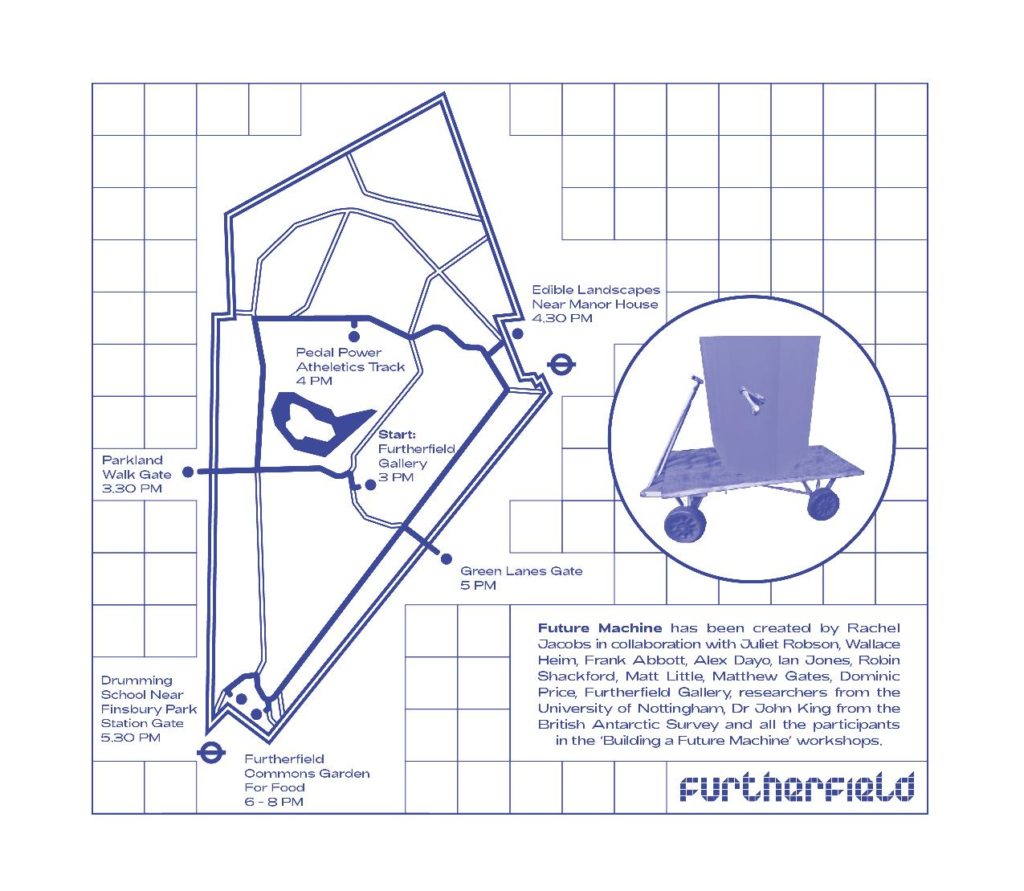
Future Machine Procession Stops:
Future Machine has been created by Rachel Jacobs in collaboration with Juliet Robson, Wallace Heim, Frank Abbott, Alex Dayo, Ian Jones, Robin Shackford, Matt Little, Matthew Gates, Dominic Price, Furtherfield Gallery, researchers from the University of Nottingham, Dr John King from the British Antarctic Survey and all the participants in the ‘Building a Future Machine’ workshops.
After touring to other places across England, the Future Machine will return to Finsbury Park in October in 2020 and 2021, as the future comes.
Featured image: credit to Rachel Jacobs
In June 2019 Martin Zeilinger and Furtherfield held a Future of Money workshop, inviting people with expertise in alternative currencies, crypto tech and to meet with sci-fi writers and enthusiasts. They presented their work and to stimulate a discussion on how the politics and practicalities of cashlessness could be explored with younger generations.
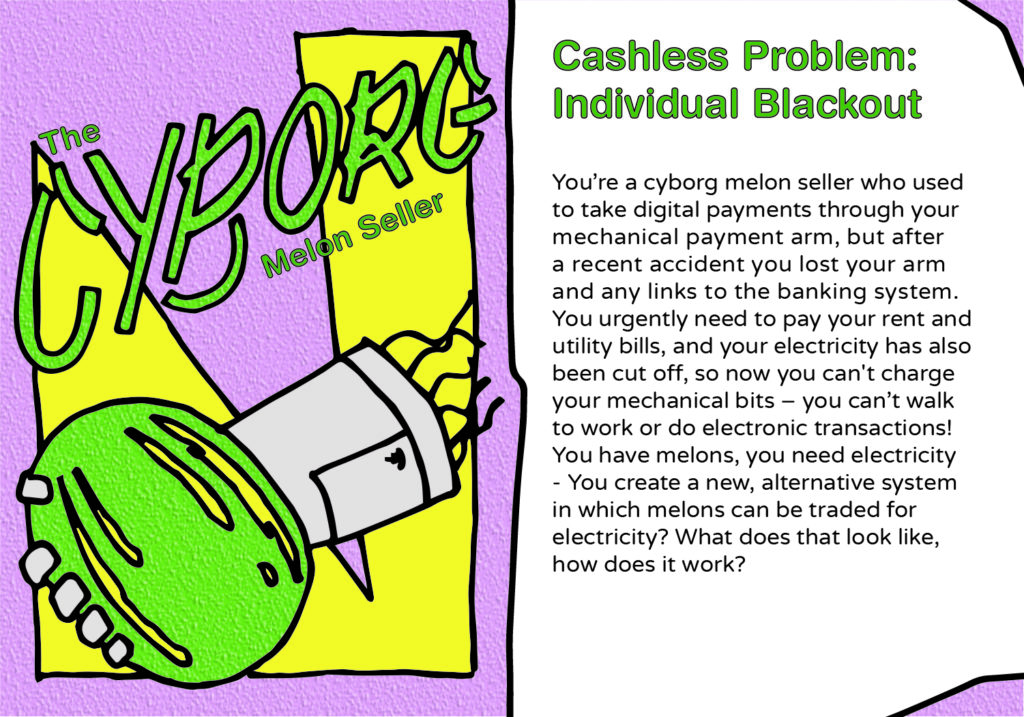
Contributors included:
Mud Howard – gender non-comforming sci-fi writer; Arjun Harrison-Mann – graphic designer; Ben Cain – graphic designer; Brett Scott – on the future of money; Jaya Klara Brekke – on the politics of crypto finance; Ailie Rutherford – feminist economics artist; Peter Holsgrove – art and blockchain developer; Cecila Wee – writer and curator with finance and money specialism. The aim of this event was to develop a framework for running workshops exploring the issues of a cashless society.

The framework, devised by Zeilinger, Furtherfield and Studio Hyte, is a playful workbook (and set of stickers and badges). Users select a scenario from Planet Cashless 2029 and are invited through a set of steps designed to tease out solutions to the scenario. For example in one scenario a cyborg melon seller loses power in their digital payment arm and they need to find an alternative way to sell their melons!
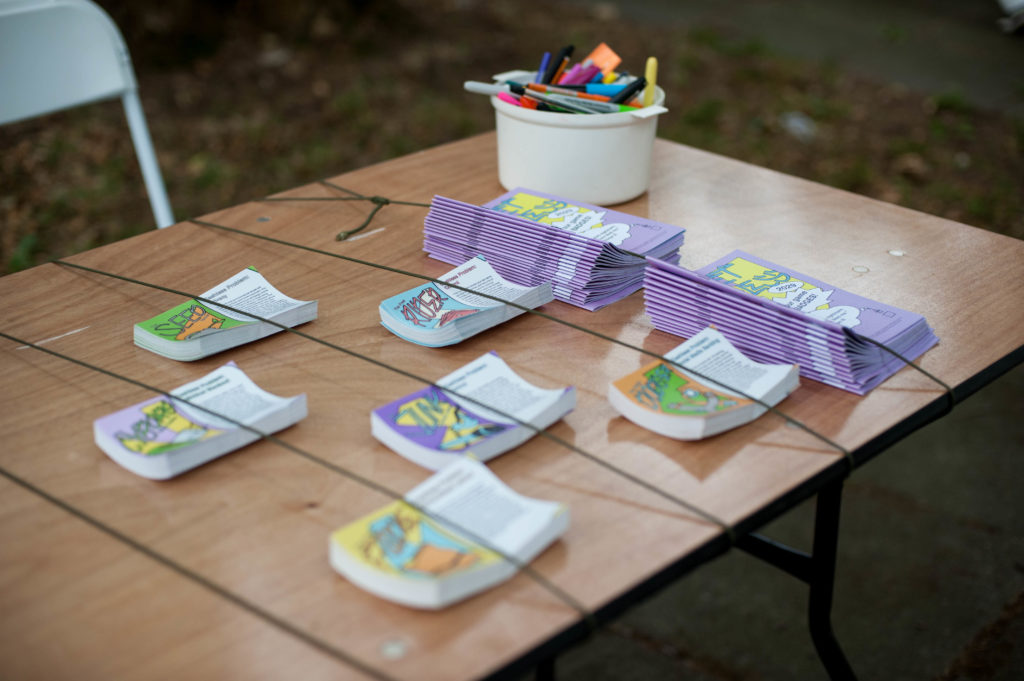
We now plan to further bring the workbook alive with AR. In particular, we aim to create futuristic scavenger hunts where young people can explore locally, investigate financial forms for themselves, and come up with their own solutions to arising issues of the disappearance of cash.
The first Future of Money Lab was run by Zeilinger and Catlow at Furtherfield Commons, London, on 6th June 2019
Martin Zeilinger is a new media researcher, curator, and practitioner whose work focuses on the intersections between new media art, emerging technologies, critical theory, and activism in the financial, political, and environmental realms. Martin is Senior Lecturer in Computational Arts & Technology at Abertay University in Dundee. He has curated the Toronto-based Vector New Media Arts Festival since 2013, and is a member of the curatorial collective for the Dundee-based NEoN Festival.
Featured image: Image from Planet Cashless 2029 booklet designed by Studio Hyte
Join us in using play to design a utopian economy by coming to play Utopoly at Furtherfield Commons.
Utopoly is a tool for inquiry, reflection and idea generation. Its purpose is to generate alternatives to the neoliberal orthodoxy and address the social and ecological crises it creates. It uses a game as utopian practice to critique the state of society and engage in speculation about how to shape the future. Through improvisational play Utopoly provides that rare space for people to re-imagine society, where values, forms of exchange and social relations can be reconsidered and reconfigured. Players then interact with and evaluate the alternative social and political spaces that emerge.
Utopoly starts with a Future Workshop, a method developed by Robert Jungk in 1962 to re-engage people’s innate creative genius which had been suppressed by school, work and consumerism. This involves separate stages of critique, fantasy and implementation. It starts with a discussion and critical exploration around a selected topic or situation. Players critically engage with the now or what-has-become to then open up space for the future or the what-is-yet-to-become. They create fantasies of a utopian nature unconstrained by whether they can be realized or not. Desires, ideas, alternative values, attributes and features of a utopian future are discussed. Moving from the limits of knowing to the possibilities of the yet-to-be-known. This is the political space where the future is open and crucially not a continuation of the present.
The implementation stage involves a ‘hack’ of Monopoly, a popular game which in its original form in 1904 had a progressive and beneficial informative function, but now celebrates and normalises competitive accumulation and socially useless rentier behaviour.
Players discuss and decide which of the features of a utopian future they want represented in the game Utopoly. They determine how the new economy works and – by introducing alternative values, currencies and transactions – can inspire new ways of considering existing social norms. Players then collaborate in a contest against the prevailing crises bound by the neoliberal agenda.
By playing Utopoly participants have the opportunity to reflect on alternative realities and social relations. They can navigate and negotiate the various game features and experience what it is like to inhabit a world incorporating the new economic and social possibilities they have created. In addition, by providing a platform for beneficial expectations Utopoly cultivates the ‘education of desire’ for a better world.
Further information about Utopoly can be found in the following articles:
New School (New York) Public Seminar, Utopoly – A utopian design game
Furtherfield UTOPOLY – playing as a tool to reimagine our future: an interview with Neil Farnan
The OPEN SCORES exhibition brings together 16 practices through which artists articulate their own forms of (digital) commons. From online archives, to digital tools/infrastructure and educational formats, the projects envision a (post-)digital culture in which notions of collaboration, free access to knowledge, sustainable use of shared resources and data privacy are central.
Curated by Creating Commons (Shusha Niederberger, Cornelia Sollfrank, Felix Stalder)
For the exhibition, artists have developed a SCORE relating to their practice. A SCORE can have different meanings: It can be a general instruction, a working instruction, a performance instruction or an operating instruction. In any case, it is meant to lead to a realization of an intended action and as such is an interface between a human actor and an object/material/machine. And a SCORE can also be linked to a technical HOWTO document, in that it contains information on how to perform a specific task.
Within the exhibition, the newly developed SCORES add an aesthetic layer while pointing to the socio/political impact of the presented projects. The exhibition will also feature the interviews conducted as part of the research project as well as a temporary library on the subject of digital commons. Furthermore, there will be a program of talks, screenings, and workshops.
The exhibition features The DAOWO Open Score for Artworld Commoning by Ruth Catlow and Marc Garrett, Furtherfield/DECAL
DAOWO (Decentralised Autonomous Organisation With Others) is the second wave of global artworld restructuring against the toxic cult of the individual artistic genius which first found expression in the punk spirit of networked collaboration called DIWO (Do It With Others).
The DAOWO Open Score is an experimental framework for nurturing the artworld commons after Web3.0, at the intersection of three fields of practice: art, commoning and decentralisation engineering.
Dušan Barok (monoskop.org), Marcell Mars & Tomislav Medak (memoryoftheworld.org), Sebastian Lütgert & Jan Gerber (0xdb.org), Kenneth Goldsmith (ubu.com), AAAAARG, Zeljko Blace (#QUEERingNETWORKing), Ruth Catlow & Marc Garrett (furtherfield.org), Laurence Rassel (erg.be), Marek Tuszynski (Tactical Tech), Constant (Michael Murtaugh, Femke Snelting & Peter Westenberg), Stefanie Wuschitz (Mz* Baltazar’s Lab), Panayotis Antoniadis (nethood.org), Alessandro Ludovico (neural.it), Eva Weinmayr (andpublishing.org), Spideralex, Sakrowski (curatingyoutube.net), Creating Commons, Johannes Kreidler, Alison Knowles.
Presentation and open conversation with Penny Rafferty and Ruth Catlow
Artists Ruth Catlow and Penny Raffety will host an open conversation about their recent Artworld DAO think tank, a 52 hour immersive event employing technical talk, political discussion and uncanny working methods to create pathways to collective arts production, tools, capacities, resources, resistance and solidarity.
“We believe that by engaging with these spaces collectively we will strengthen and build quicker and better models for the future DAOs and hopefully make them a reality for all.”
The intensive commodification of art over the last five decades has been accompanied by the hyper-individualization and beggering of artists on the ground in even the world’s wealthiest countries. Decentralised Autonomous Organisations (DAOs) now allow people to exchange economic value, to pool resources and form joint-ventures, without control from the centre; to enjoy the benefits (or otherwise) of the shared activity in the future. DAOs provide both the technical underpinnings and the context for reimagining a full re-constellation of stakeholders for radical imagination and other possible art worlds.
Additionally because artworlds can provide timespaces for practical philosophy and creative play with everyday rules, behaviours and structures they have the potential to inject (into an over-mechanised technical space) radical imagination that produces new ways of being, feeling and knowing for collectives of people.
*The first Artworld DAO Think Tank was made possible with funding by Furtherfield/DECAL and Serpentine Galleries
Featured image: Woodcut (1888) Artist Anonymous
This family-friendly ‘Albion’ style fair for Finsbury Park’s 150th anniversary forms part of our 3-year programme Citizen Sci-Fi – crowdsourcing creative and technological visions of our communities and public spaces, together.
Music, storytelling, costumes, food, and all kinds of activities for exploring the future of the park and beyond!
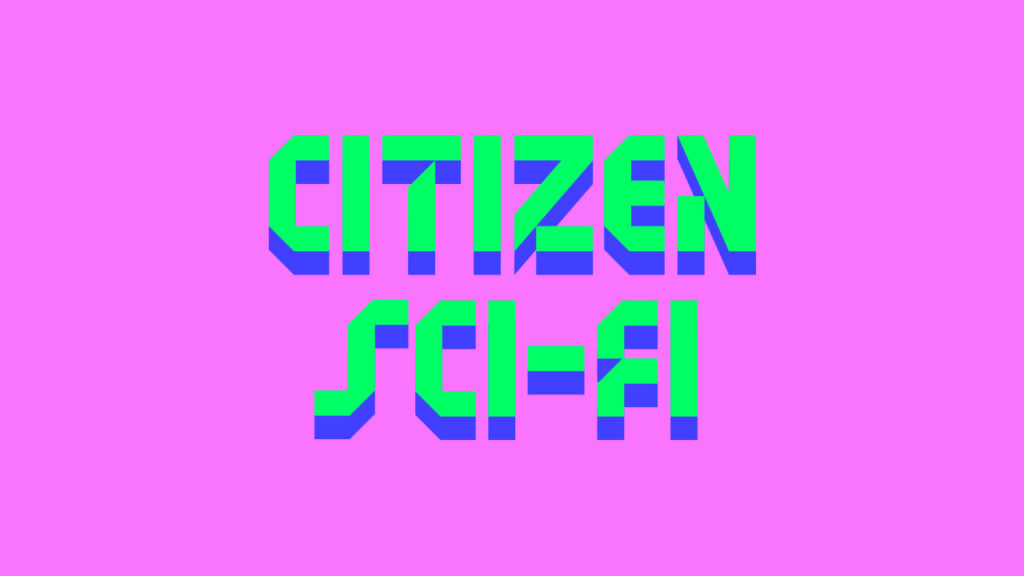
Activities Include:
Martin Zeilinger
Should a cashless society leave us quaking in our boots? Come play our game imagining the future of money – and how we’ll get by if there’s no cash to pay for things. You’ll get given a scenario and asked to design a way to make exchanges in the future. Are you a ‘Barter Bender’ or ‘Sharey Carey’? Or will you sink the system and start again? Find out!
Times: 10.00-5.00
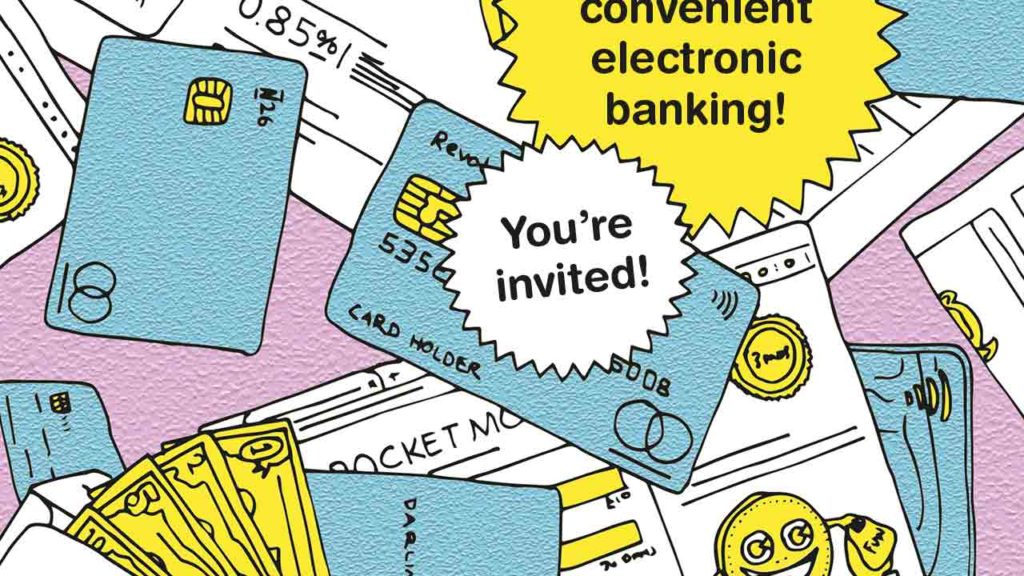
Mud Howard and Stephen Oram
Gather round and listen to two short stories emerging from the heady mix of sci-fi authors, scientists and the folk of Finsbury Park. Come and decide if these are the futures you want for your park?
Times: 11.30, 2.30
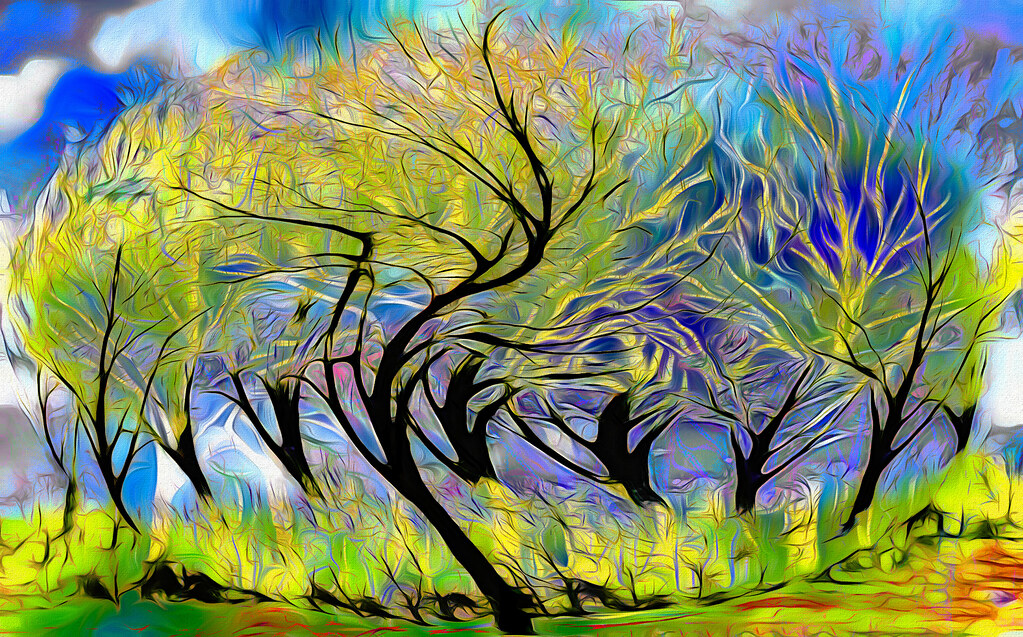
Idit Nathan and Helen Stratford
Take part in the launch of an entirely new app that leads you on a walk of the park that’s like no park walk you’ve ever been on before! This app was designed with local people through similarly silly strolls and we need YOU to bring it to life! Drop by and we’ll show you how to download the app (it’s very easy!) and collect a map that will help you ‘catch’ prompts all around the park. We’ll also have colourful badges for you to take home.
Times: 10.00-5.00
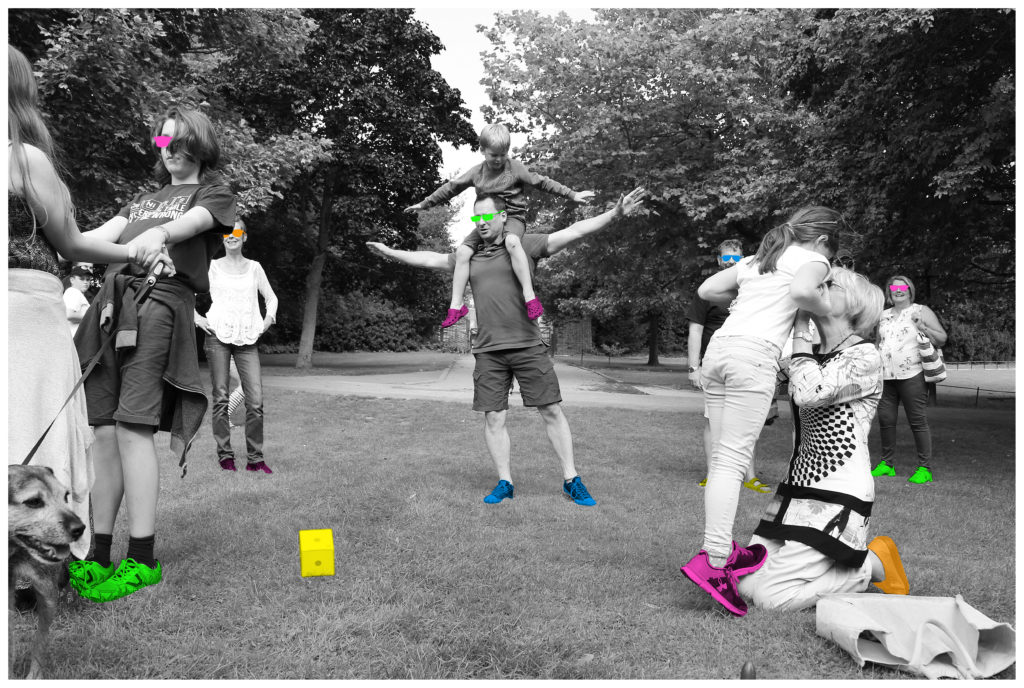
Jason Wilsher-Mills
Pedal Power, come meet Jason and the Argonauts – a set of wild and wacky AR-enabled characters who have come to visit you. Jason will show you how he made them and how you can help him make new ones all about the Pedal Power community. (this activity is especially for Pedal Power, but all welcome)
Times: 10.00-5.00
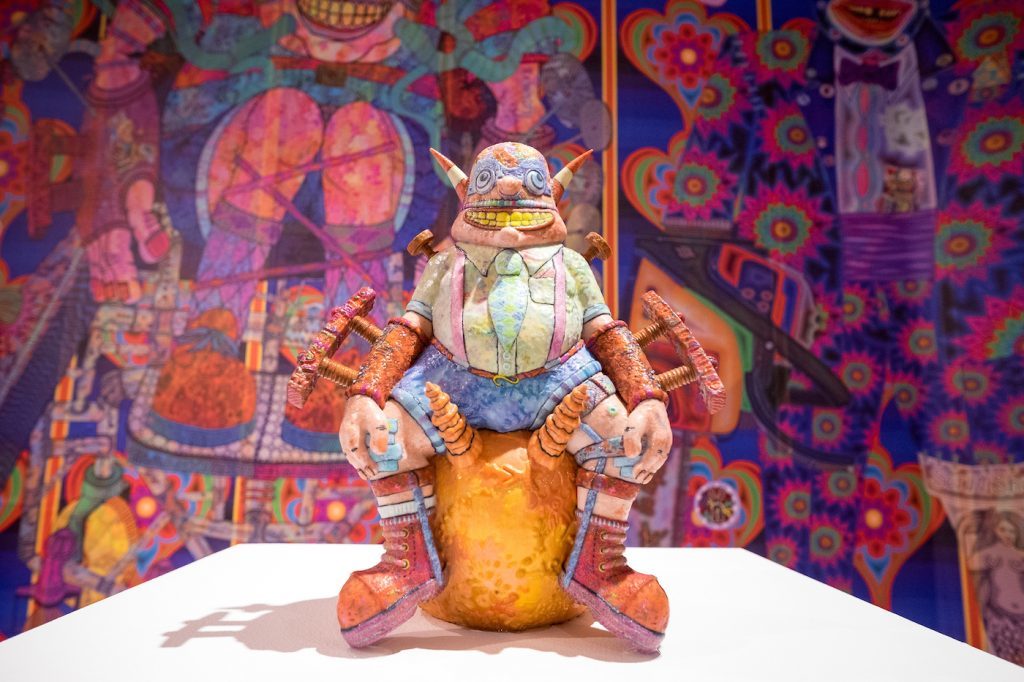
Alex Dayo
Drop by and join in a family-friendly Community Drumming workshop led by Alex Dayo, master drummer from Burkina Faso (West Africa), find your inner rhythm and let it out!
Times: 10.30, 4.00
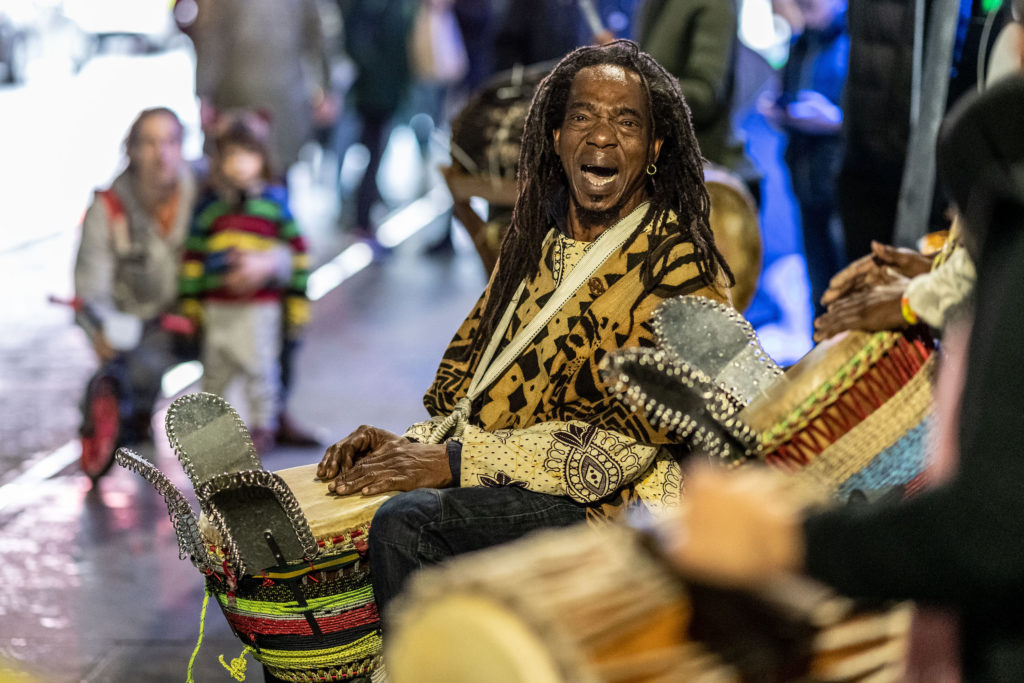
Possible Bodies: The Underground Division – Helen Pritchard, Jara Rocha, Femke Snelting
Join a research session with Possible Bodies: The Underground Division, a team of fiction writers, geo-techno-scientists and trans*feminist device problematizers. A hands-on collective investigation into the micro, meso and macro political consequences of earth scanning practices. Together we’ll look at what undergrounds are rendered when using techniques such as Terrestrial Light Detection and Ranging, magnetic resonance, UltraSound, and Computer Tomography.
Times: All day but limited places, book now

Feminist Internet
What have parks done for their communities? What role do they play in our lives both socially and politically? What kind of spaces could they be for us in the future? Feminist Internet launch a special episode of their podcast series and an accompanying zine for the Albion fair that unearths the history of Finsbury Park, examining the role urban parks play within their communities and speculates about their potential futures.
Times: 10.00-5.00
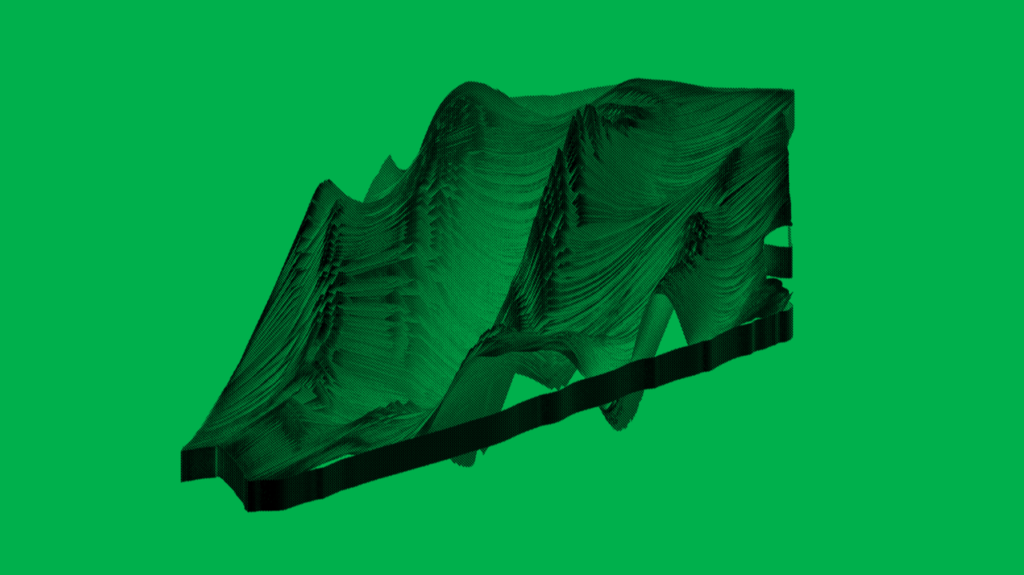
Larisa Blazic
It’s time to call this meeting to order! Join a special Theatre of the Oppressed inspired performance by reading aloud meeting minutes published by Finsbury Park’s many organisations and community hubs.
Times: 12.00-2.30
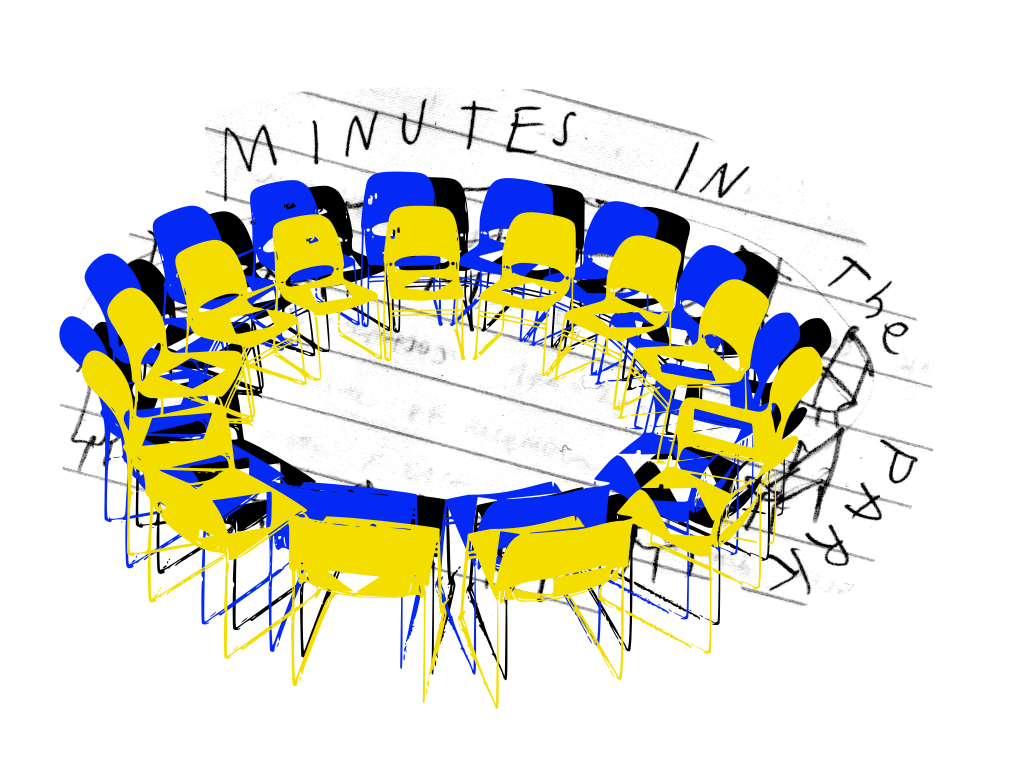
Sunara Begum
The ‘Who Am I?’ workshop is about reversing technology and reflecting on history through creativity. Design and create your own special crest and emblem to signify who you are. Investigate the world of sound through percussion-led music making and immerse yourself in the art of expression through movement. The workshop looks at understanding who we are, tapping into our inner self, asking questions, seeking answers and sharing personal and collective journeys.
Times: 10.00-5.00
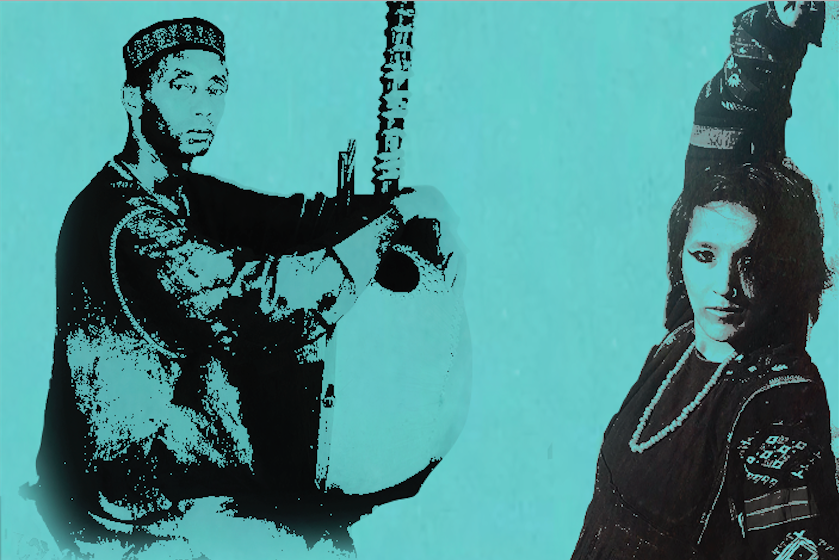
Artist: Alistair Gentry. Curators: Hannah Redler Hawes and Julie Freeman.
Just how trusting are you? Meet the hot-pink puppet-robot who wants to tell you all about your life online! How much will you reveal and how much does the trustbot know already?
Times: 10.00-11.30, 12.00-2.00, 3.00-5.00
This work was produced as part of an ODI R&D project funded by Innovate UK.
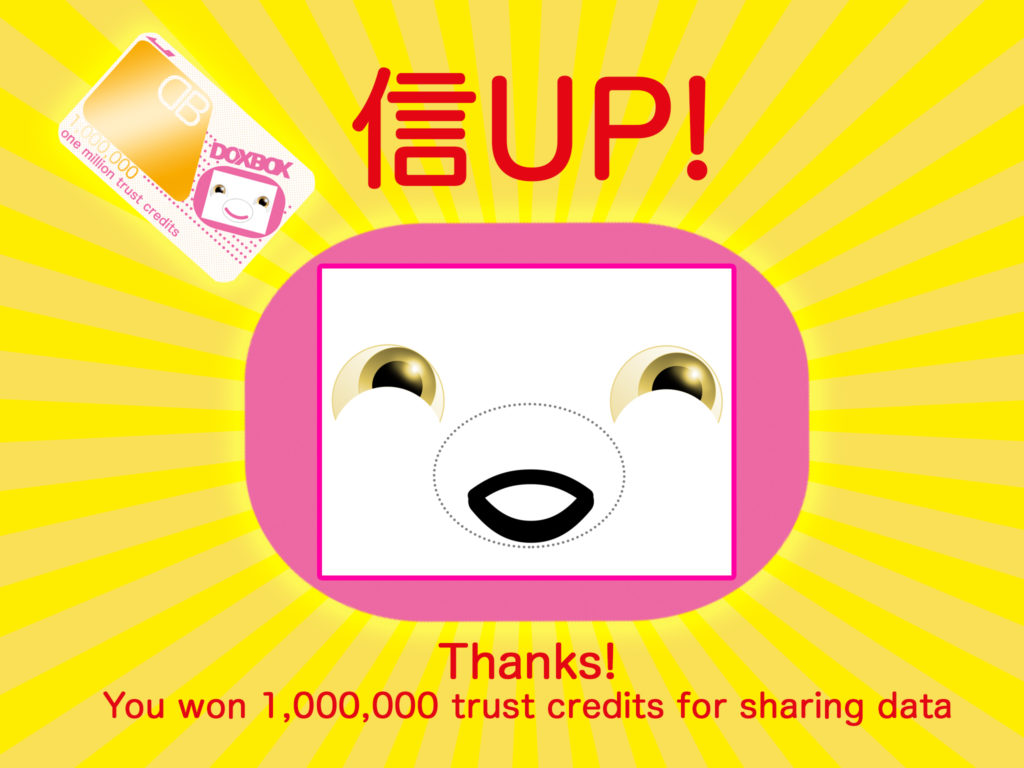
Rachel Jacobs
How will you dress fancy for the Future Machine? Rachel Jacobs needs your help to create a stylish parade for the unveiling of the Future Machine this autumn. What will you wear?
Times: 10.00-5.00
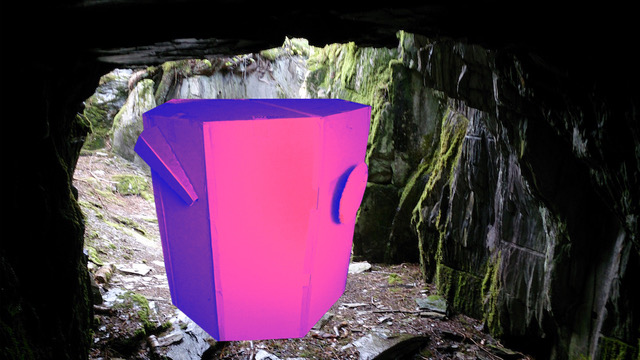
They Are Here
There will be a vegetarian and Halal barbeque on the go, with servings inspired by recipes from the refugees They Are Here have been collaborating with. Food will be offered in exchange for a sketch reimagining the transformation of the garden, this will inform the changes taking place in the Autumn.
Times: DJ 12.00-4.30. BBQ 1.00-4.30
Kathryn Davis, Dhelia Snoussi and Zey Kussan, Museum of London
What might future archaeologist say about us in the park? How right (or wrong!) could they be? Discover the left objects found in park through the Everything project, and see what connections you can make to you, the park and 2019.
Times: 11.00-1.00
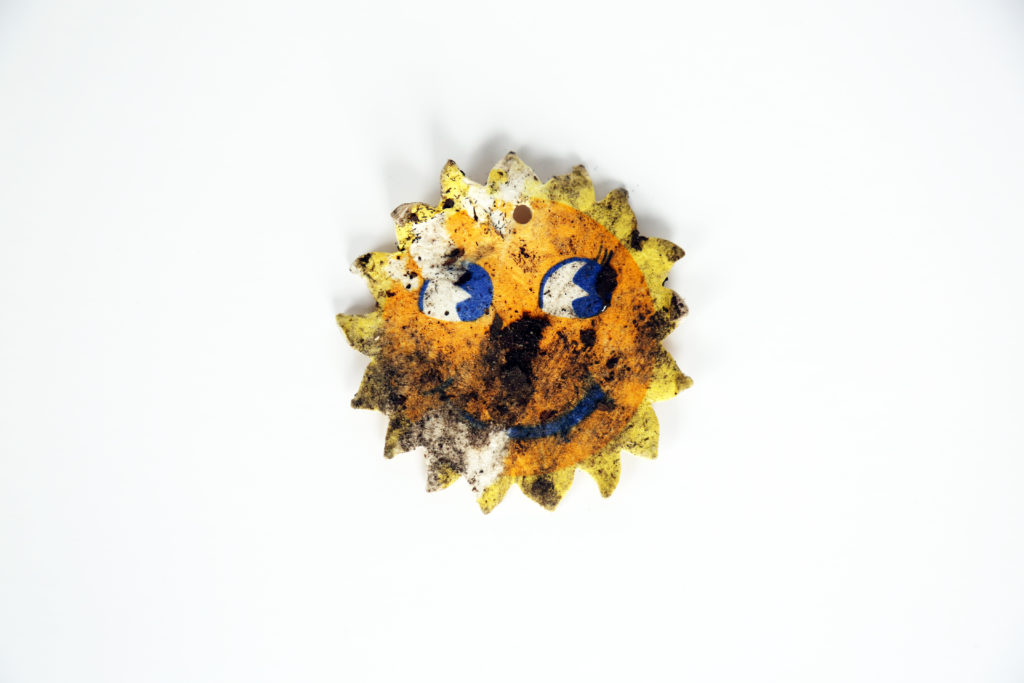
Andrew Smith, Goran Vodicka
Come and map your experiences of Finsbury Park and feed into research about urban parks and festivals.
Times: 10.00-5.00
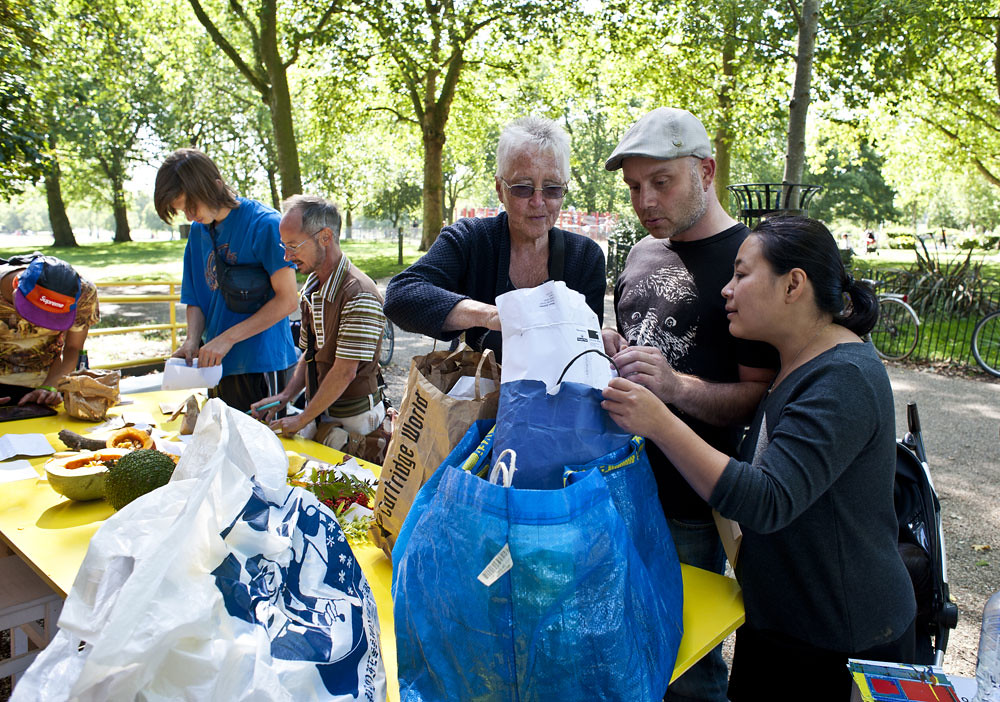
Featured image: Image by Studio Hyte, artwork in image by Jason Wilsher-Mills
Alex Dayo
Alex Dayo is a versatile composer, arranger and musician (he primarily plays percussion instruments), who was born in Burkina Faso, West Africa. Alex recalls growing up to the sound of drumbeats all around him – music has been part of his everyday life from birth, with instruments replacing childhood toys. His professional musical career started in the 1980s, accompanying the National Ballet Kouledafourou on tour as well as playing for African Royalty and globally-recognised dignitaries at private and public events and the Ensemble des Radios and Televisions of Burkina Faso, based in Bobo-Dioulasso. In 1985, Alex founded Fusion band Wountey, and, for fifteen years, toured with his band and the Ballet across Africa and Europe, spreading Burkina Faso’s cultural fusion to a wider audience. His musical collaborations include Ali Farka Toure, Femi Kuti and Salif Keita from Africa and traditional Master Griots from Burkina Faso/Mali/Guinea/Gambia. An accomplished arranger, Alex modifies his style according to the need, incorporating African traditional, Fusion, Jazz, Rock, Latin and Caribbean influences. A highlight of Alex’s career was being chosen to play at the Opening and Closing ceremonies at the London 2012 Olympics. As well as gaining British community music teaching qualifications, Alex developed his teaching skills working throughout Europe (Switzerland, Italy, Germany, Austria, Luxembourg, Belgium, France and Holland) and Africa and has played at numerous festivals and events, including Notting Hill and Hackney Carnivals, where he has performed for the past ten years.
Alistair Gentry
Alistair Gentry is a science fiction artist. He likes silly costumes, museums, absurdity, visiting the uncanny valley, the Oxford comma, and making machines do things their manufacturers wouldn’t approve of. DoxBox trustbot was developed during his embedded research residency at The Open Data Institute. Other recent projects include an imaginary tourist information agency and a technological ritual with televisions and credit card shredders.
Andrew Smith
Andrew Smith is a Reader in the School of Architecture and Cities at the University of Westminster. His background is in urban geography and one of his main research interests is the significance of organised events in post-industrial and entrepreneurial cities.
Goran Vodicka is a Research Fellow in the School of Architecture and Cities at the University of Westminster. He is an architect/urbanist and his research is broadly focused on diversity and inclusion in public spaces.
Feminist Internet
Feminist Internet is a group of artists and designers working to advance online and offline equalities for women and other marginalised groups through creative and critical practice.
Hannah Redler Hawes
Hannah is the director of the Data as Culture art programme at the ODI and an idneoendent curator. She specialises in art and technology, art and science and emerging artistic practice with an interest in participatory process. She develops interdisciplinary projects for galleries, museums, digital space and non-art contexts. Alongside her work with ODI she curates exhibitions, events and art interventions. Past projects have been with Science Gallery London, Tate Modern, Natural History Museum, FACT Liverpool, the Digital Catapult and the Institute of Physics. As an artist, Julie’s focus is the investigation of data as an art material, using it to create work that reflects the human condition through the analysis and representation of data. As a computer scientist and artist, Julie oftens works collaboratively and experimentally with scientists. Her work has been shown widely in the UK and internationally, and she has won awards from the Wellcome Trust, the Arts Council and Nesta. She holds a PhD in Media & Arts Technology from QMUL and is the founder of the Data as Culture art programme at the ODI.
http://culture.theodi.org/about/
Helen Stratford and Idit Nathan
Helen Stratford and Idit Nathan – Working collaboratively as Play Anywhere Now or Never! and combining backgrounds in theatre and architecture, Idit and Helen have worked in partnership with Wysing Arts Centre, Kettles Yard, Cambridge and METAL and in locations across the UK (Bristol, Sunderland, Peterborough, Southend and London). In 2015 they formulated Play The City Now or Never! (PCNN) working with METAL Peterborough and Southend to develop the PCNN App, a site-specific geo-locative App for mobile devices positioned at the intersection of art, play and technology. The PCNN App, like other low-tech resources they have developed, such as a compilation of games and scores as well as DIY die, solicits playful engagement with spaces and sites. Other recent and ongoing collaborative projects include developing a mobile artwork for Yorkshire Sculpture Park as well as walkshops for Cambridge Junction, Festival of Ideas Cambridge, CounterPlay ’16 Aarhus, Wellcome Trust, Live Art Development Agency and the National Theatre.
www.playanywherenowornever.com
Jason Wilsher-Mills
Jason Wilsher-Mills is a disabled digital artist who is based in the East Midlands, using iPads to create paintings which detail his disability, childhood memories, popular culture, social history/heritage, creating new biographical narratives, through theatrical artifice and humour. He initially painted traditionally, with oils, but since becoming disabled has found the iPad screen more manageable – affording him the opportunity to create large pieces of artwork, through high-resolution files, modern Giclée printing methods & projection methods. It has also given him the chance to work collaboratively, due to its connectivity and accessibility. The primary themes of his work include memory, childhood, disability and illness. In parallel to his own artistic practice Wilsher-Mills conducts public art commissions and residencies working primarily with learning disabled collaborators on wild and wacky interactive sculptures.
Larisa Blazic
Larisa Blazic is a London based digital artisan, educator and feminist hacker with practice ranging from net.art to FLOSS art and design. In her most recent work, Data Union Fork, part of Vertigo STARTS Residency, she explores collective response to personal data abuses by state and corporate sector and creates experiments based on technologies developed within the DECODE project and investigates local governance in Local&&Ledger project.
Martin Zeilinger
Martin Zeilinger is a London-based interdisciplinary researcher, curator, and media practitioner. Currently he works as Senior Lecturer in Media at Anglia Ruskin University (Cambridge/UK), and also serves as curator of the Vector Festival (Toronto/CAN). His research interests include digital art, appropriation-based art practices, experimental uses of financial technologies in contemporary art, theories of cultural ownership and intellectual property, political economies of new media, live coding and creative computing, videogame culture, and experimental game art.
Mud Howard
Mud Howard (they/them) is a gender non-conforming poet, performer and activist from the states. mud creates work that explores the intimacy and isolation between queer and trans bodies. mud is a Pushcart Prize nominee. they are currently working on their first full-length novel: a queer and trans memoir full of lies and magic. they were the first annual youth writing fellow for Transfaith in the summer of 2017. their poem “clearing” was selected by Eduardo C. Corral for Sundress Publication’s the Best of the Net 2017. mud is a graduate of the low-res MFA Poetry Program at the IPRC in Portland, OR and holds a Masters in Creative Writing from the University of Westminster. you can find their work in THEM, The Lifted Brow, Foglifter, and Cleaver Magazine. they spend a lot of time scheming both how to survive and not perpetuate toxic masculinity. they love to lip sync, show up to the dance party early and paint their mustache turquoise and gold.
Possible Bodies – Femke Snelting
Femke Snelting works as artist and designer, developing undisciplined research at the intersection of feminisms and free software. In various constellations she explores how digital tools and cultural practices might co-construct each other. She is member of Constant, a non-profit, artist-run association for art and media based in Brussels.
www.snelting.domainepublic.net
Possible Bodies – Helen Pritchard
Helen Pritchard is an artist and researcher, whose interdisciplinary work brings together the fields of Computational Aesthetics, Geography and Feminist TechnoScience. Helen’s practice is both one of writing and making and these two modes mutually inform each other in order to consider the impact of computational practices on our engagement with environments. Helen is the head of Digital Art and a lecturer in Computational Art at Goldsmiths, University of London.
Possible Bodies – Jara Rocha
Jara Rocha is an independent researcher/mediator who tends to attend to the semiotic-material urgencies of present cultures with a trans*feminist sensibility. Works with infrastructural politics and aesthetics, text logistics, body inscriptions and tests non-formal ways of learning in collective situations like Euraca Seminar, Las promesas de los algos, Relearn Summerschool, or The Darmstadt Delegation.
Rachel Jacobs
Rachel Jacobs is an artist, researcher and games designer. She co-founded the artist-led collective Active Ingredient in 1996 and the commercial games company Mudlark Production Company in 2007. She completed a Doctorate in Computer Science in 2014. Rachel is a practising artist exhibiting nationally and internationally, and a Research Associate at the Horizon Digital Economy Institute, University of Nottingham. Her artworks include the award winning ‘Heartlands (Ere Be Dragons)’ one of the first mobile games that took place on city streets in Sao Paulo, Yokhama, Berlin, Paris, Cambridge, Bristol and Nottingham; ‘A Conversation Between Trees’, a touring artwork and schools exchange using environmental sensors to connect forests in the UK and Brazil; and ‘The Prediction Machine’, an interactive installation that predicts the future impacted by climate change. Rachel is currently developing a series of artists interventions ‘Creating Rituals for When The Future Comes’, alongside a mobile interactive artwork the ‘Future Machine’.
Stephen Oram
Stephen Oram writes thought provoking stories that mix science fiction with social comment, mainly in a recognisable near-future. He is one of the writers for SciFutures and, as 2016 Author in Residence at Virtual Futures – described by the Guardian as “the Glastonbury of cyberculture” – he was one of the masterminds behind the new Near-Future Fiction series and continues to be a lead curator. Oram is a member of the Clockhouse London Writers and a member of the Alliance of Independent Authors. He has two published novels: Fluence and Quantum Confessions, and a collection of sci-fi shorts, Eating Robots and Other Stories. As the Author in Residence for Virtual Futures Salons he wrote stories on the new and exciting worlds of neurostimulation, bionic prosthetics and bio-art. These Salons bring together artists, philosophers, cultural theorists, technologists and fiction writers to consider the future of humanity and technology. Recently, his focus has been on collaborating with experts to understand the work that’s going on in neuroscience, artificial intelligence and deep machine learning. From this Oram writes short pieces of near-future science fiction as thought experiments and use them as a starting point for discussion between himself, scientists and the public. Oram is always interested in creating and contributing to debate about potential futures.
Sunara Begum
Originally from Bangladesh, Sunara Begum studied film and fine art in the UK and Yoga and Ayurveda in India. She lives between London and Lagos where she is the co-founder of several international arts initiatives including Chand Aftara, an artist’s collective dedicated to the exhibition and production of experimental cinema, New Horizons Africa, an annual music and arts festival and Living Legacies, Gambia’s first traditional music archive. Begum’s work has been widely exhibited in film festivals, museums, galleries and cinematheques worldwide. In 2017, her film Meditation on Stillness was selected as the Best Experimental Short at the Art Africa Film Festival and the Jury Grand Prize at the 21st Media City Film Festival. Her films are in the permanent collections of Dimbola Museum & Galleries (UK), Lionel Wendt Gallery (Sri Lanka), Centre for Contemporary Art (Nigeria), Drik Gallery (Bangladesh) as well as Central Saint Martins College of Art & Design. Sunara’s work is a highly personal expression of themes including gender, memory and migration with powerful imagery that evokes deep-rooted feelings of reflection, contemplation and stillness. Sunara has developed a visual language that is distinctly her own drawn from her unique lived experience, straddling the dialectics of east and west, cultural identity, femininity and the immutable polarities of displacement.
They Are Here
They Are Here (f. 2006) is a collaborative practice steered by Helen Walker and Harun Morrison. They are currently based in London and on the River Lea. Their work can be read as a series of context specific games. The entry, invitation or participation can be as significant as the game’s conditions and structure. Through these games, they seek to create ephemeral systems and temporary, micro-communities that offer an alternate means of engaging with a situation, history or ideology. In parallel, they initiate multiyear socially engaged projects that become generative spaces for further works. They Are Here work across media and types of site, particularly civic spaces.
Museum of London
Curating London will change how the museum collects 21st century London. It also seeks to recruit staff from a broader range of backgrounds and professional experience and puts Londoners at the heart of our collecting practice by working in partnership with local communities. From physical objects to interviewing Londoners about their own histories and memories, Curating London will capture, collect and record contemporary London.
The project started in April 2018 and runs until March 2022.
Each year the museum will begin four projects: three area studies of particular areas and one themed study that spans the whole of London.
https://www.museumoflondon.org.uk/discover/curating-london-collecting-community-contemporary-city